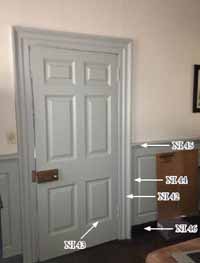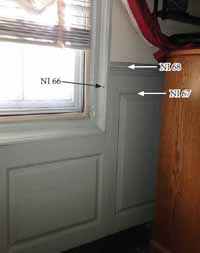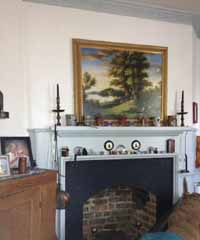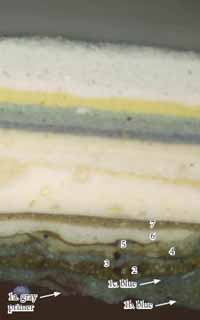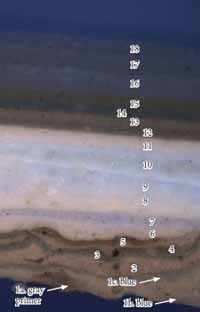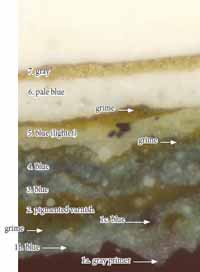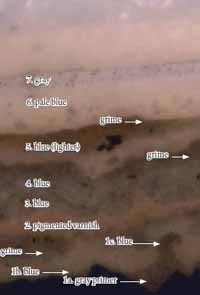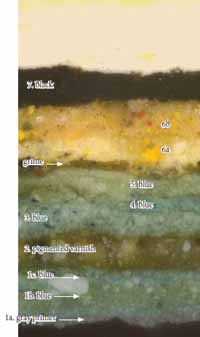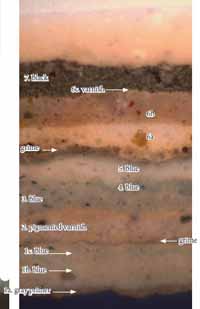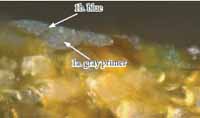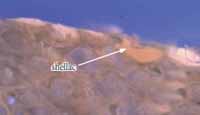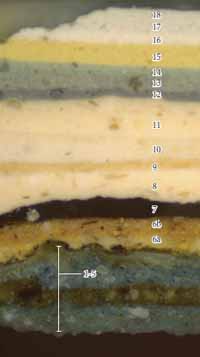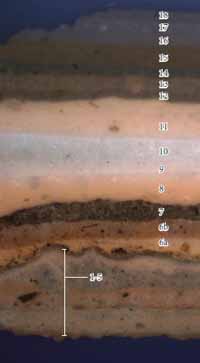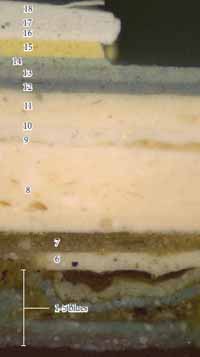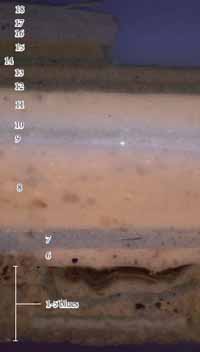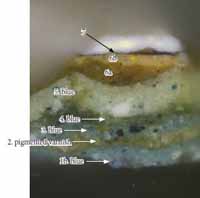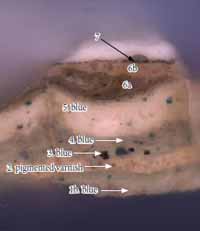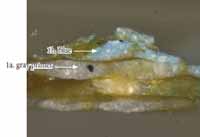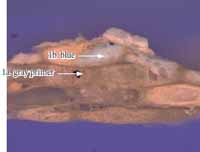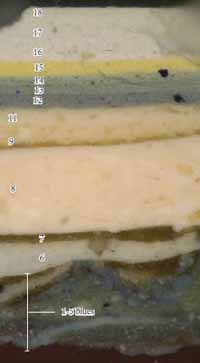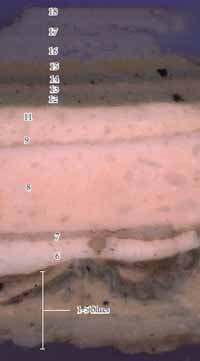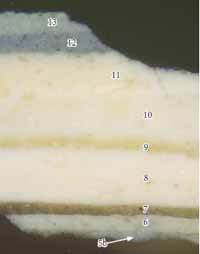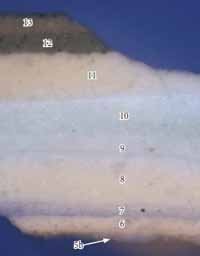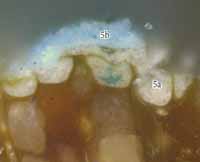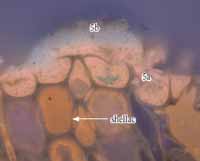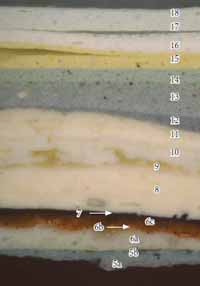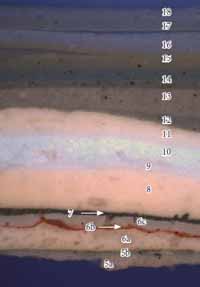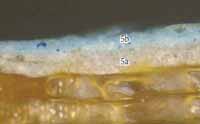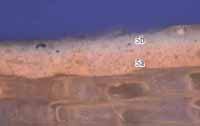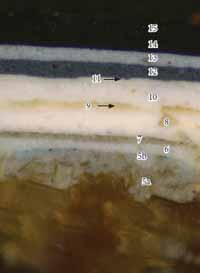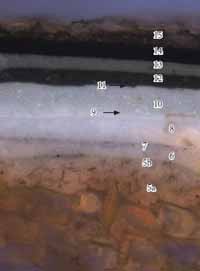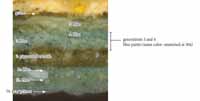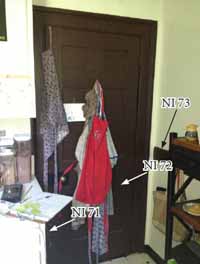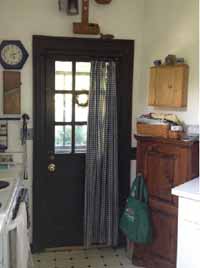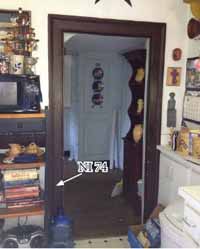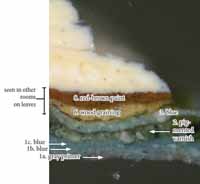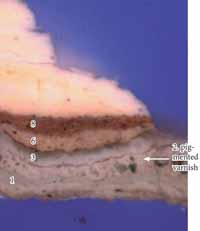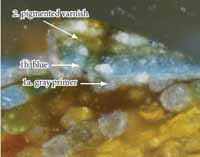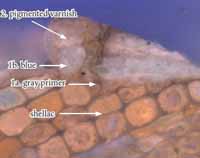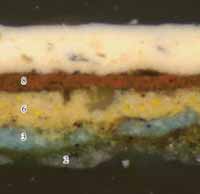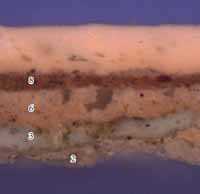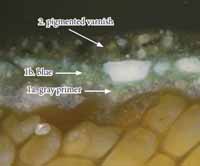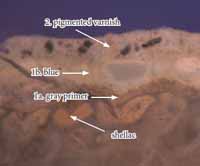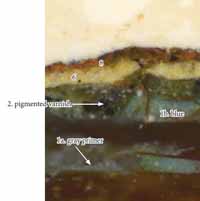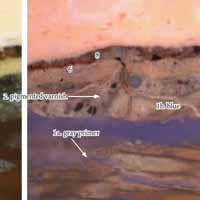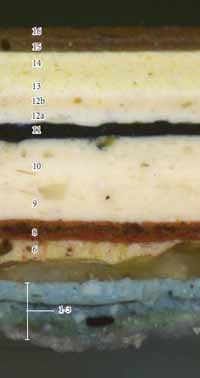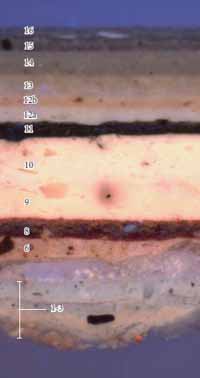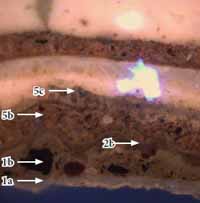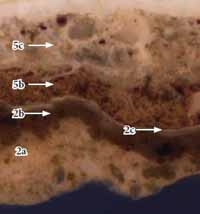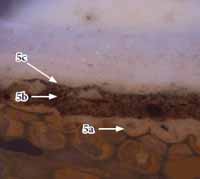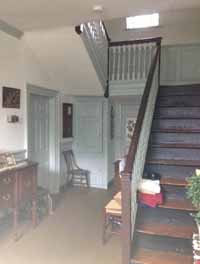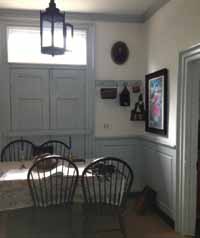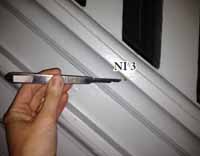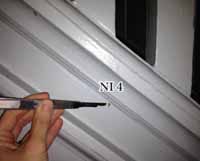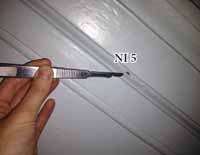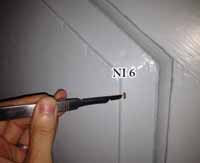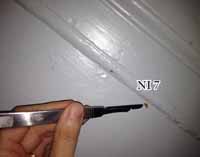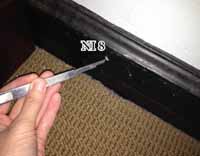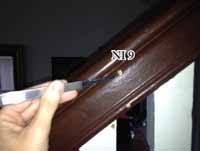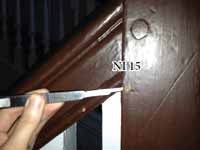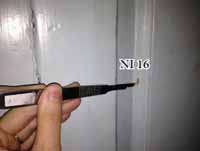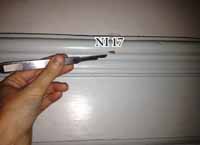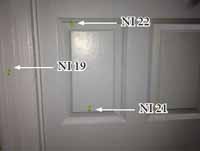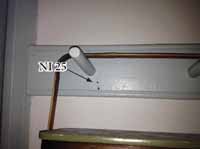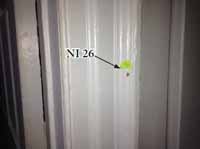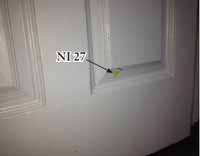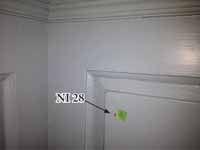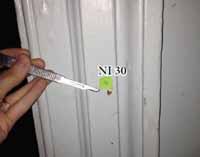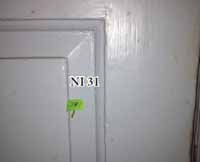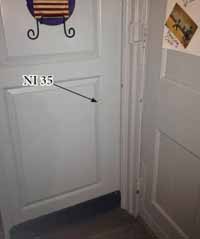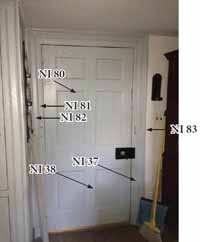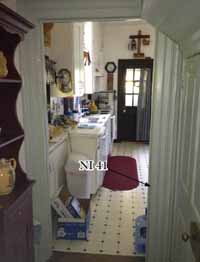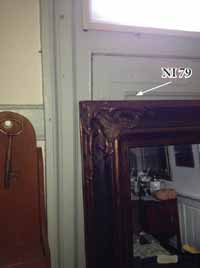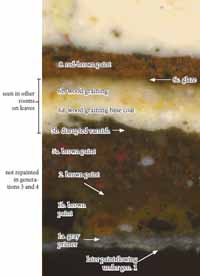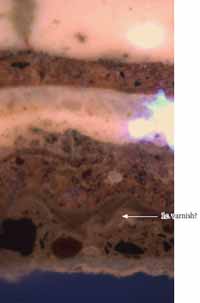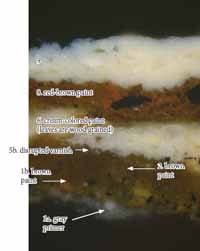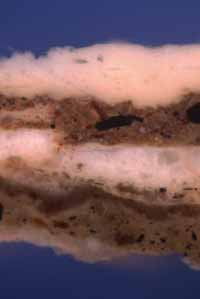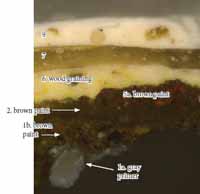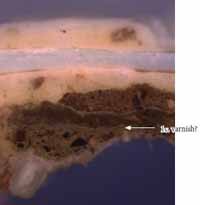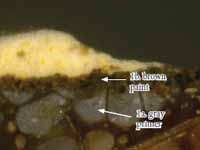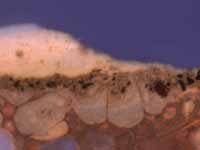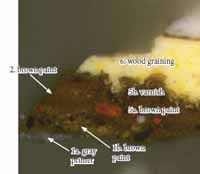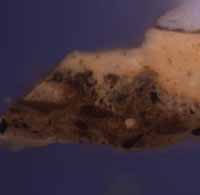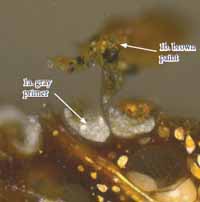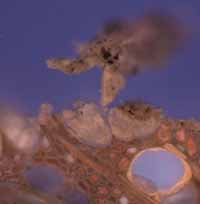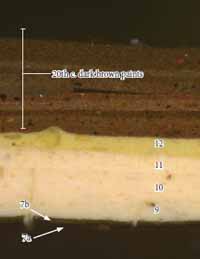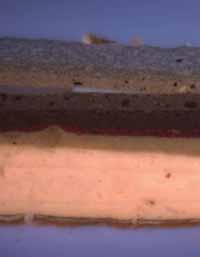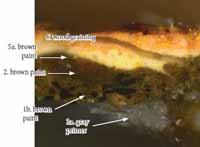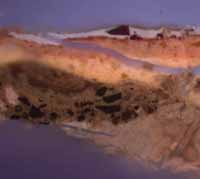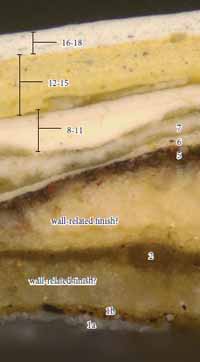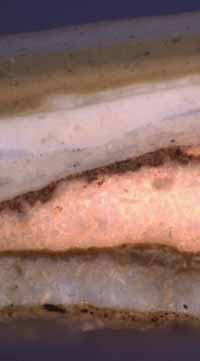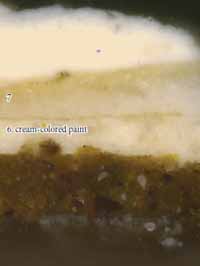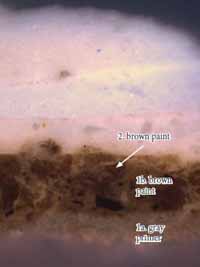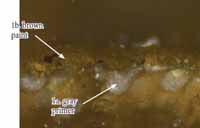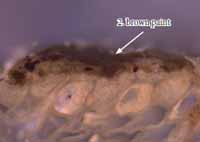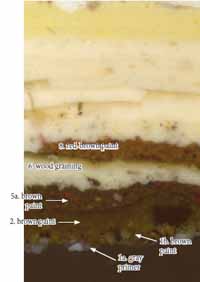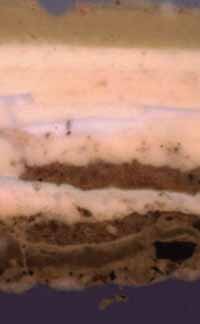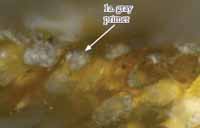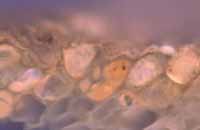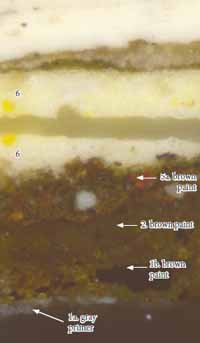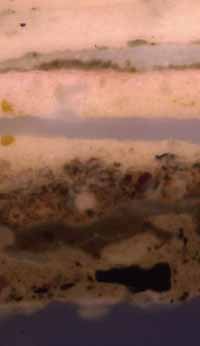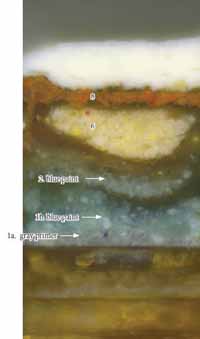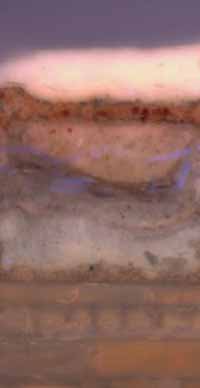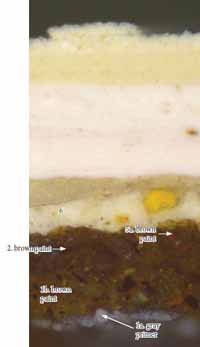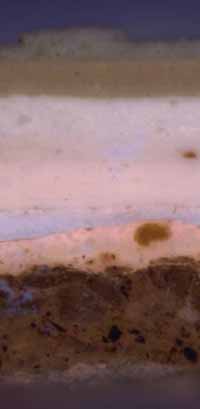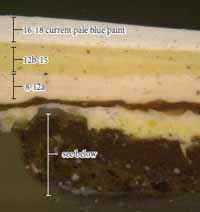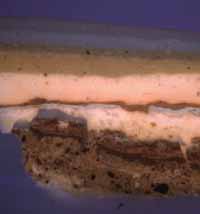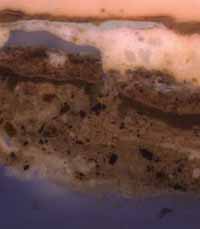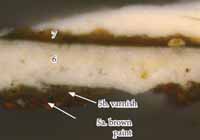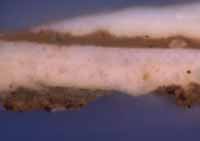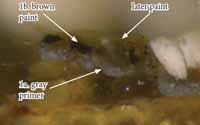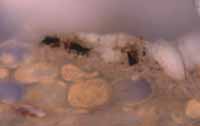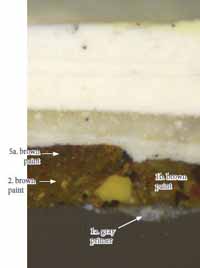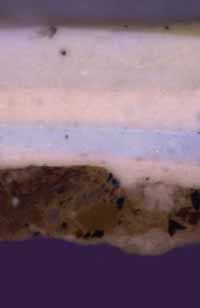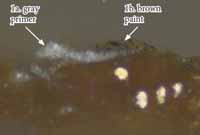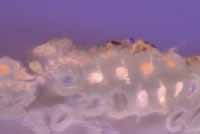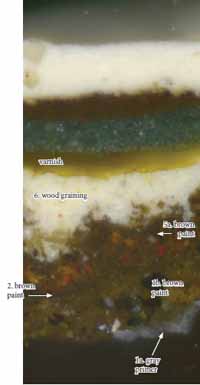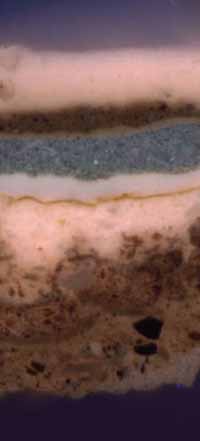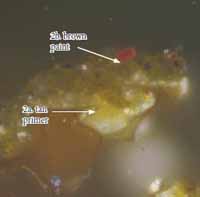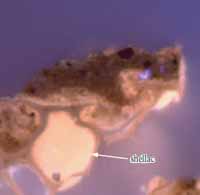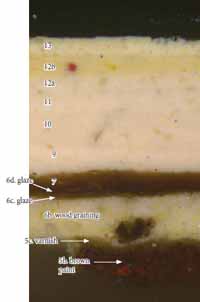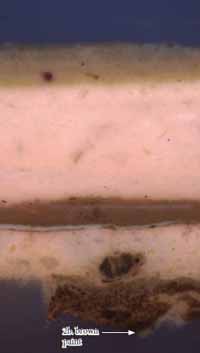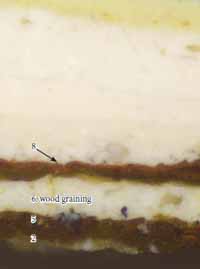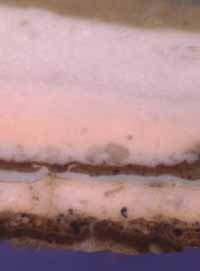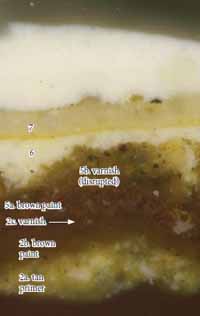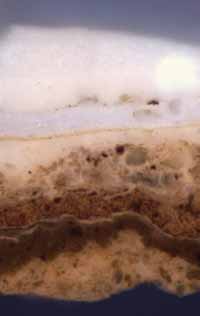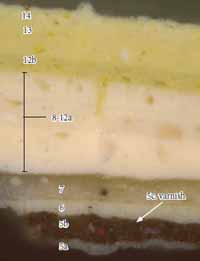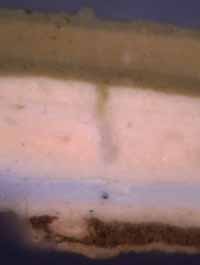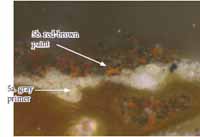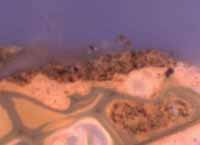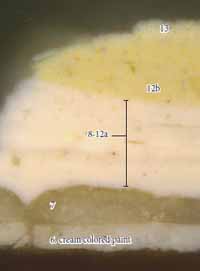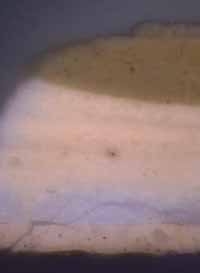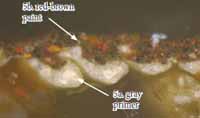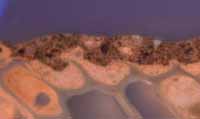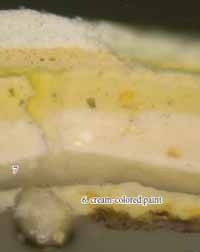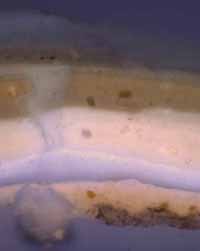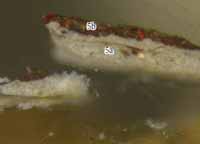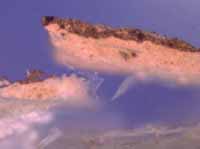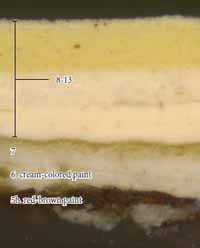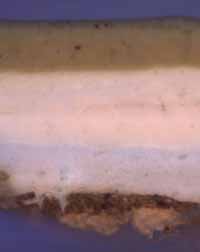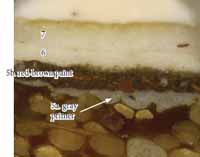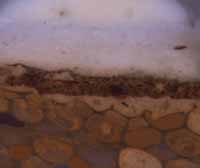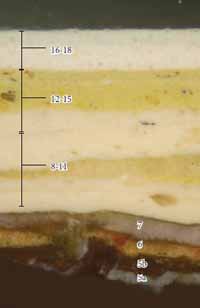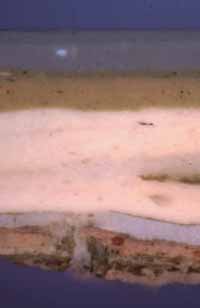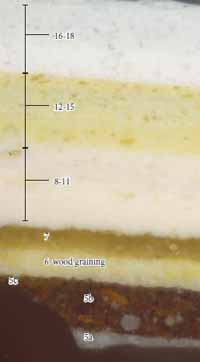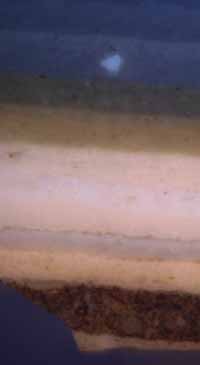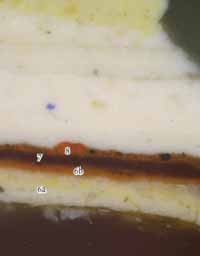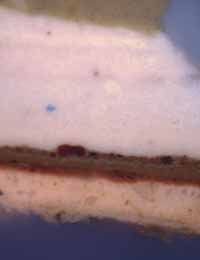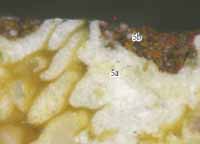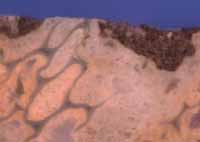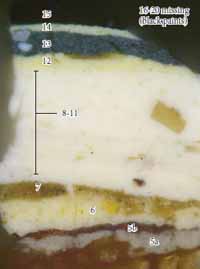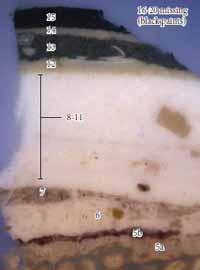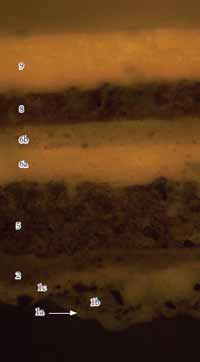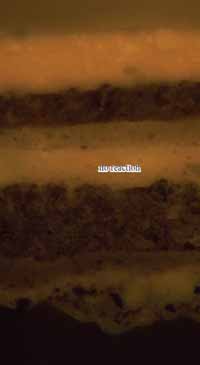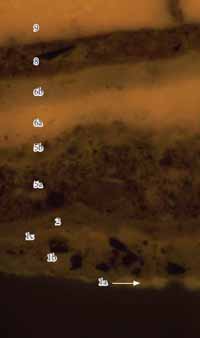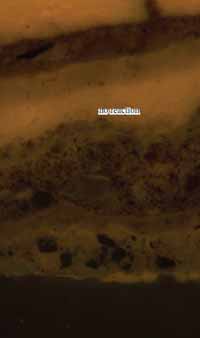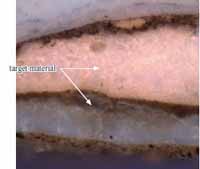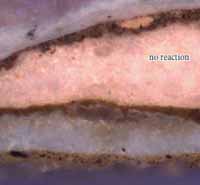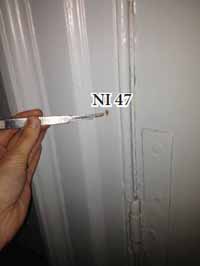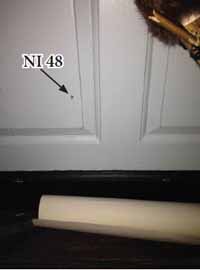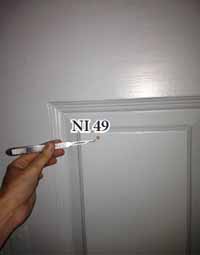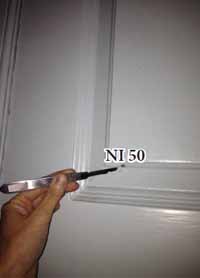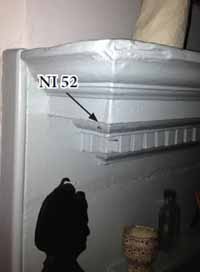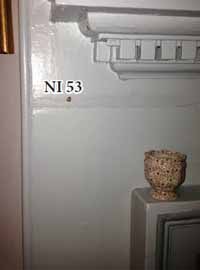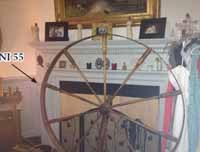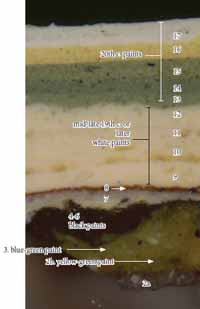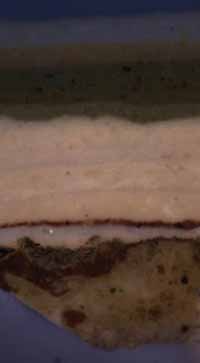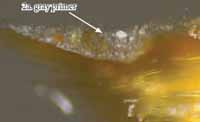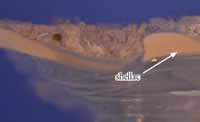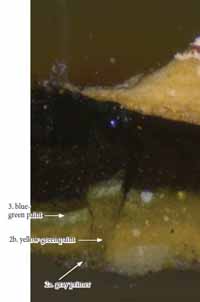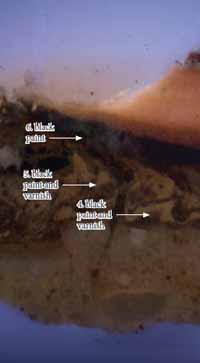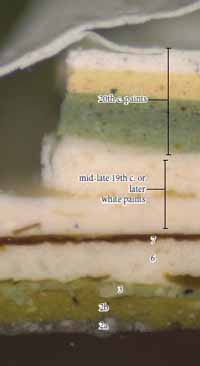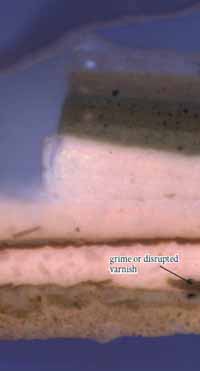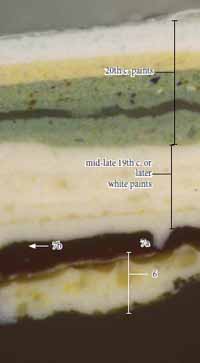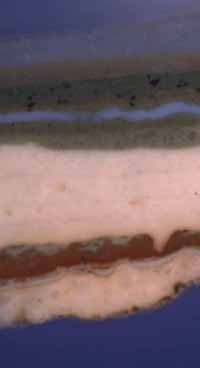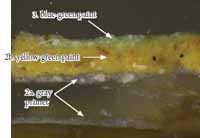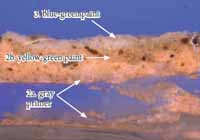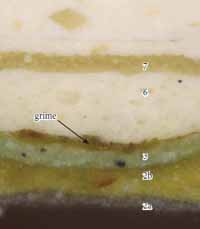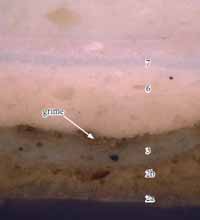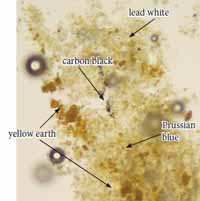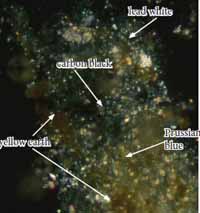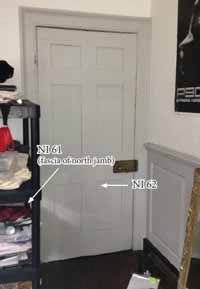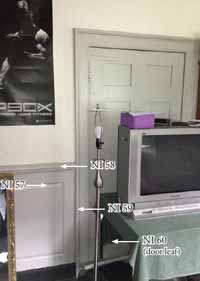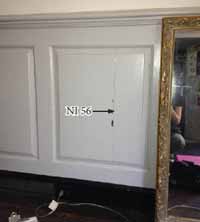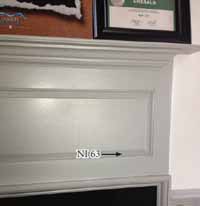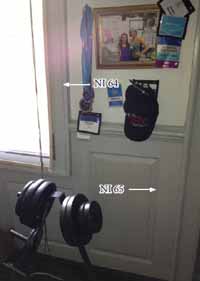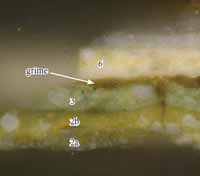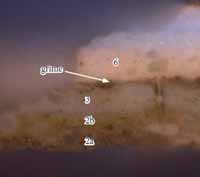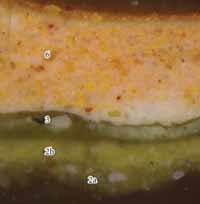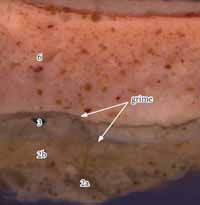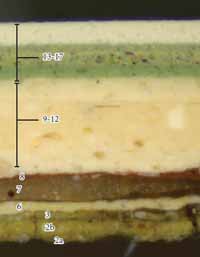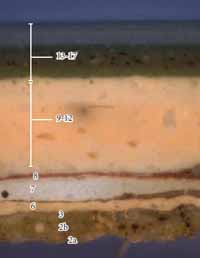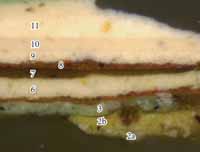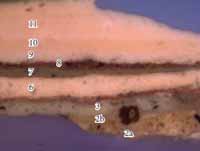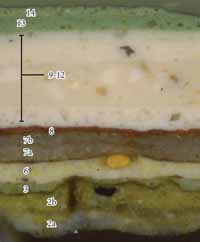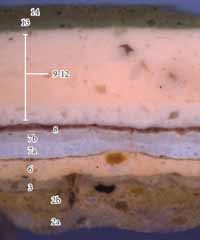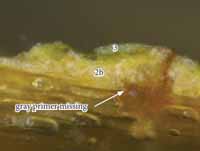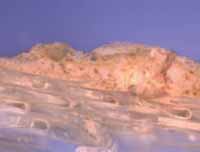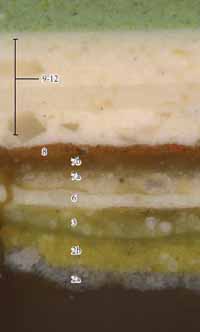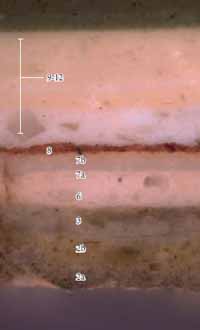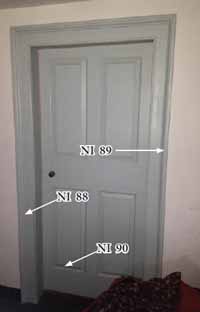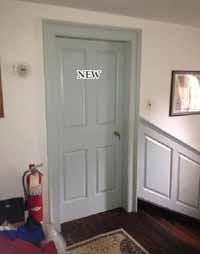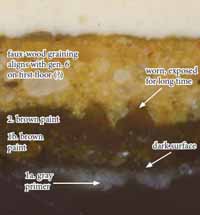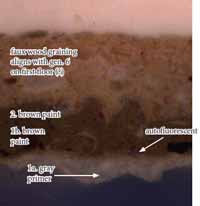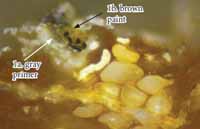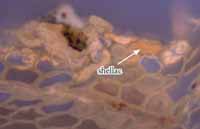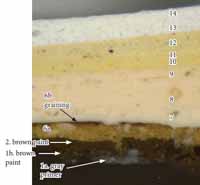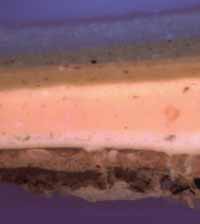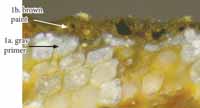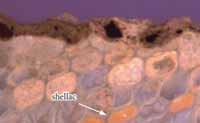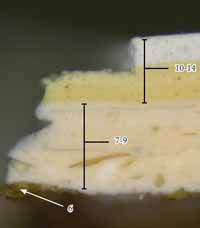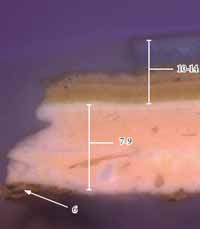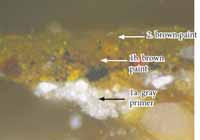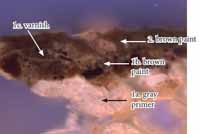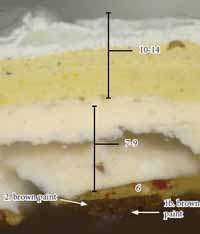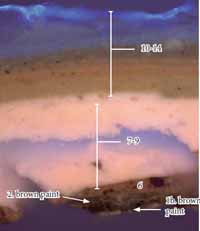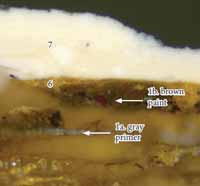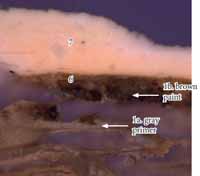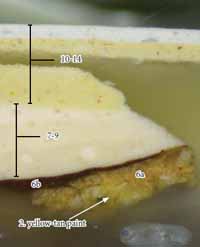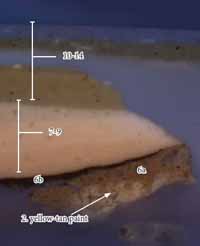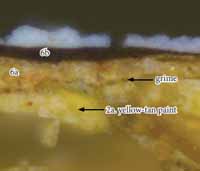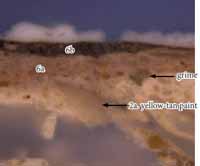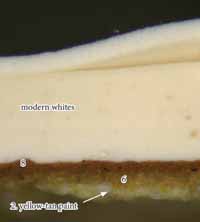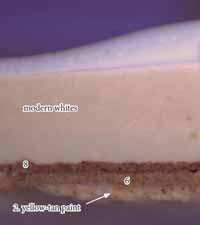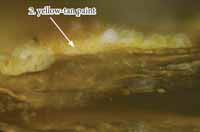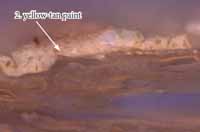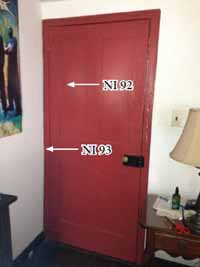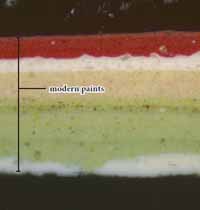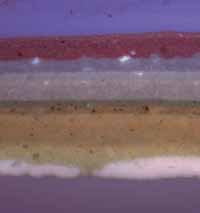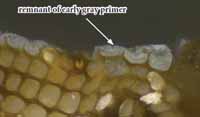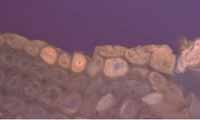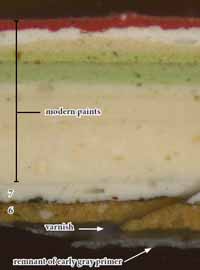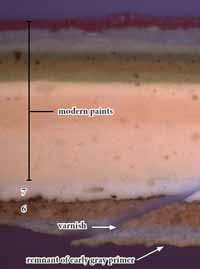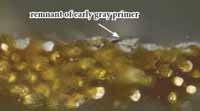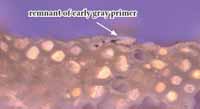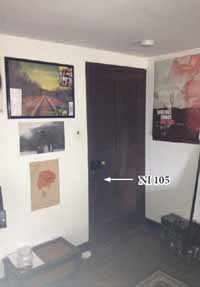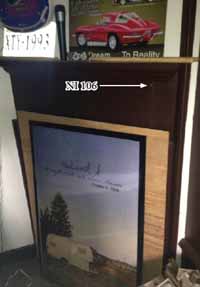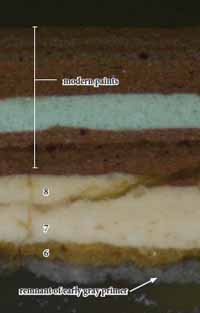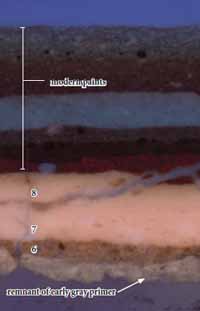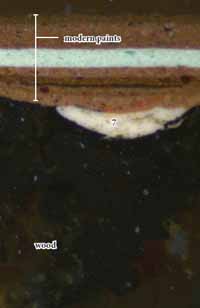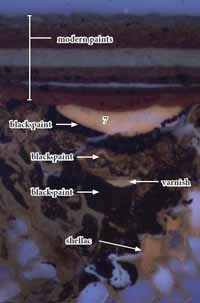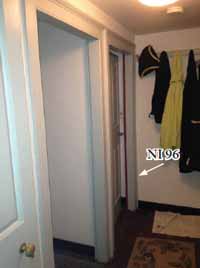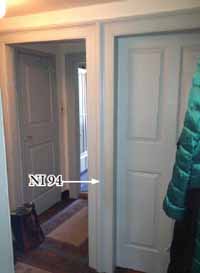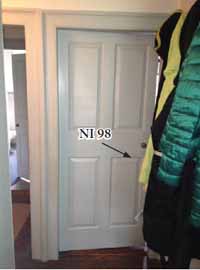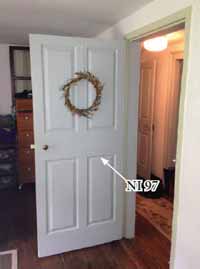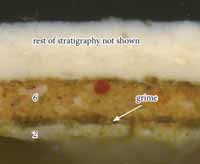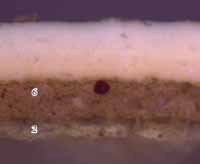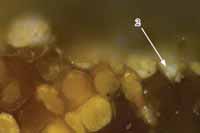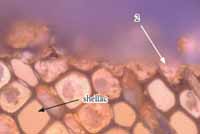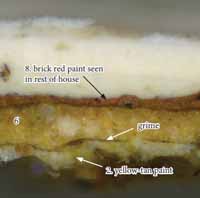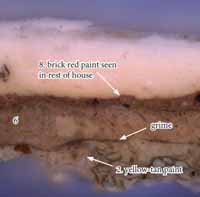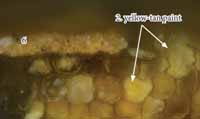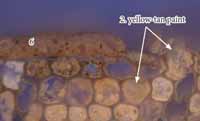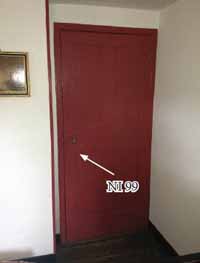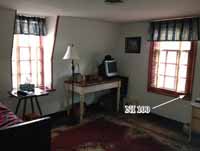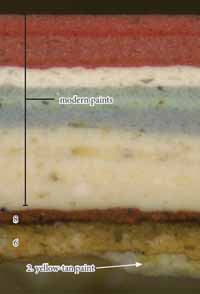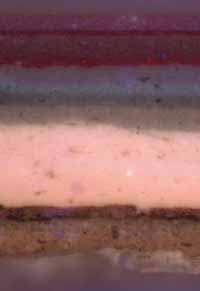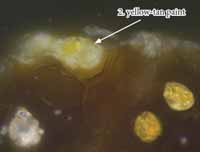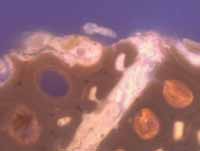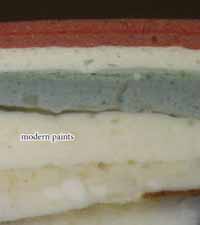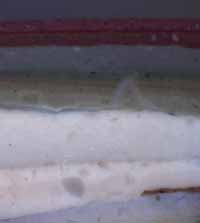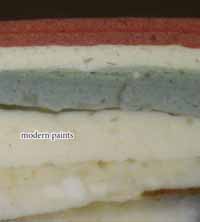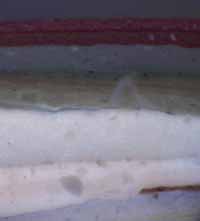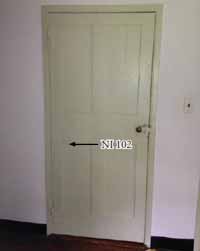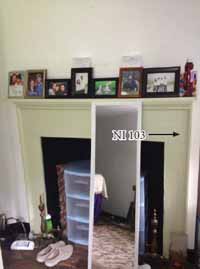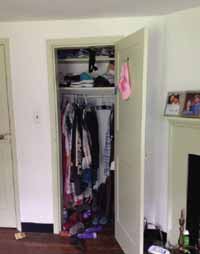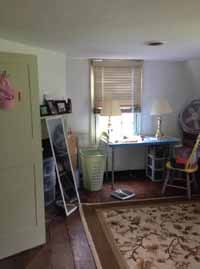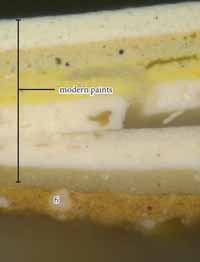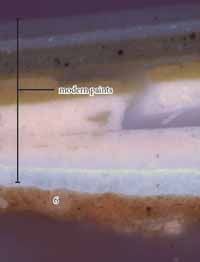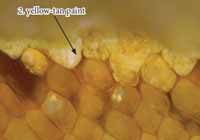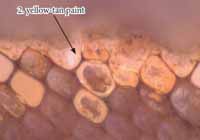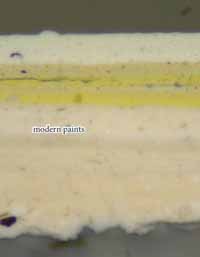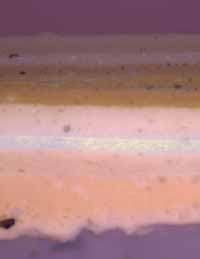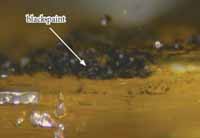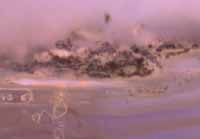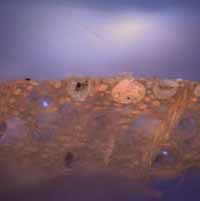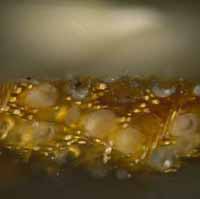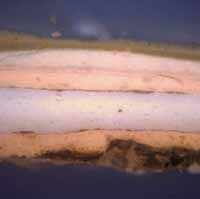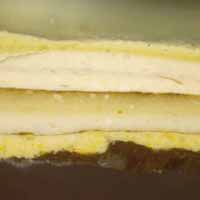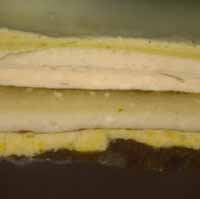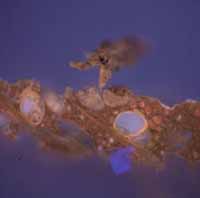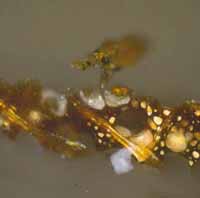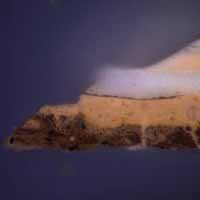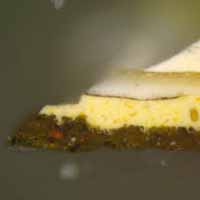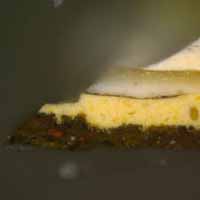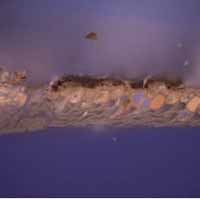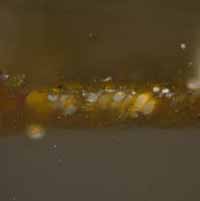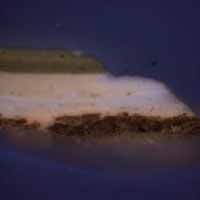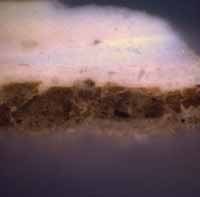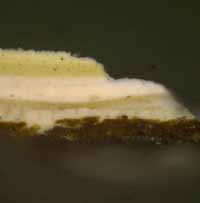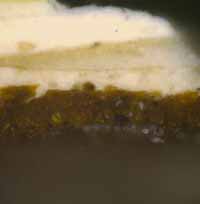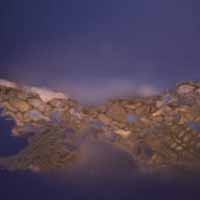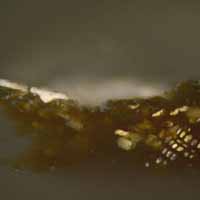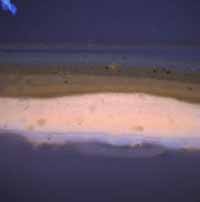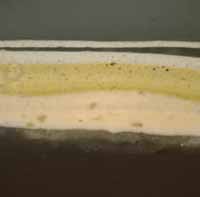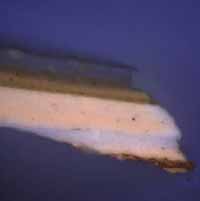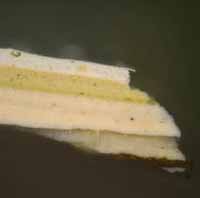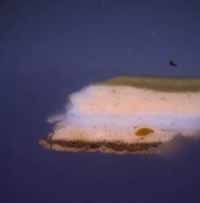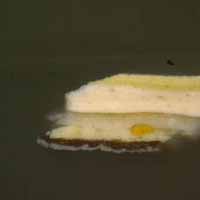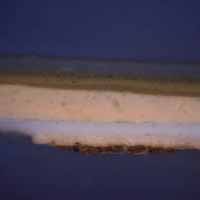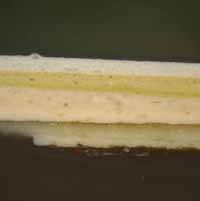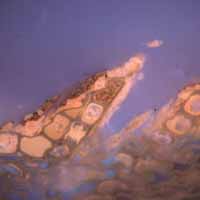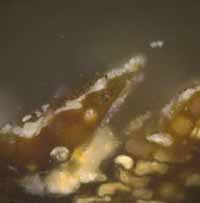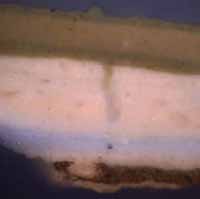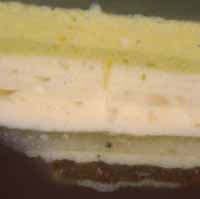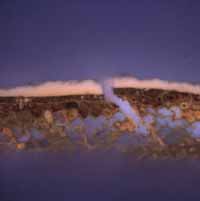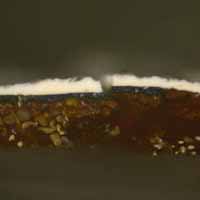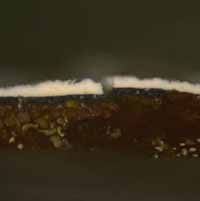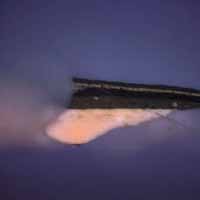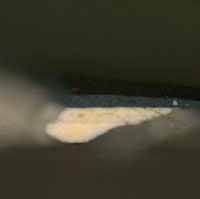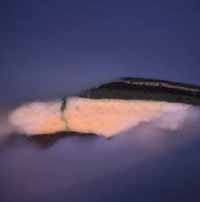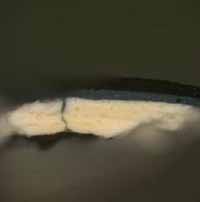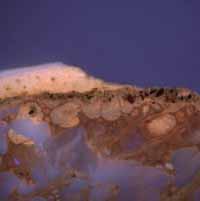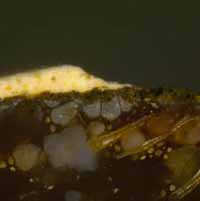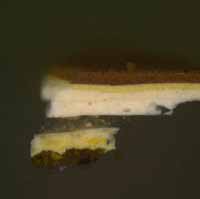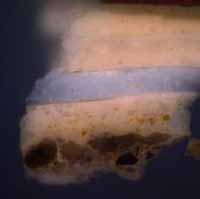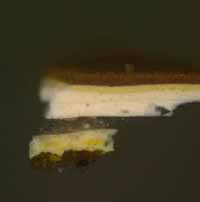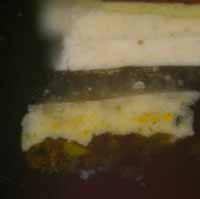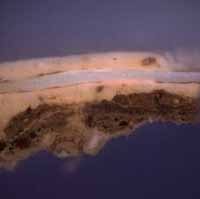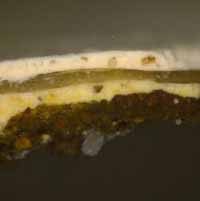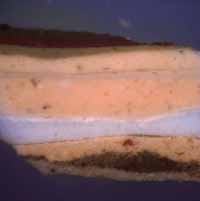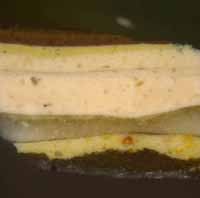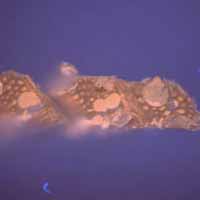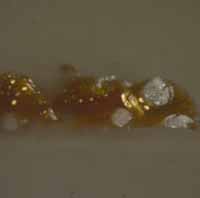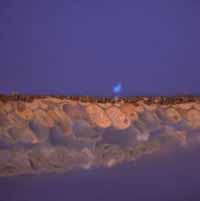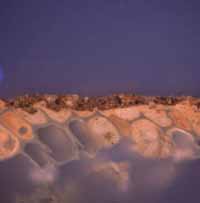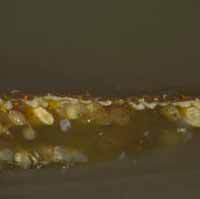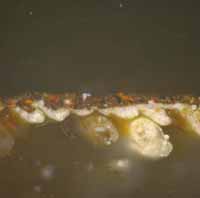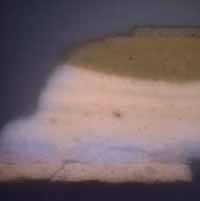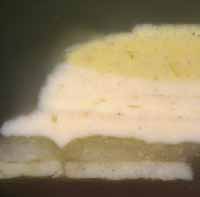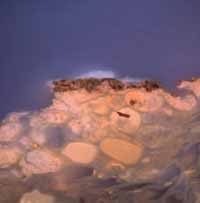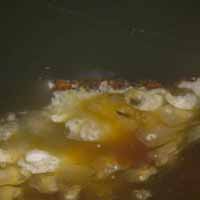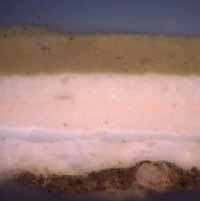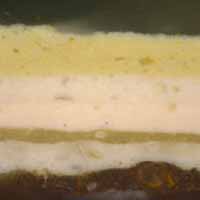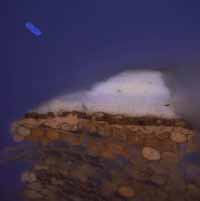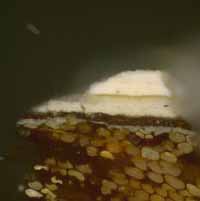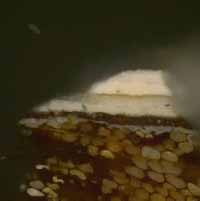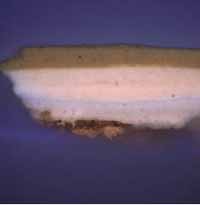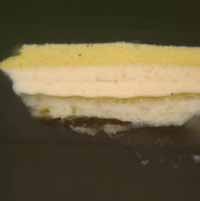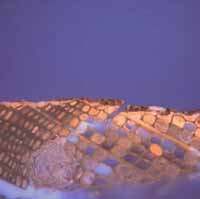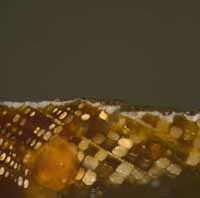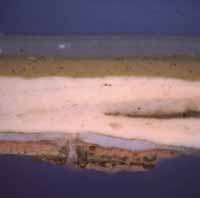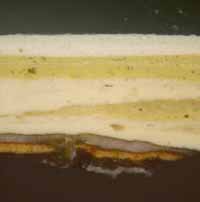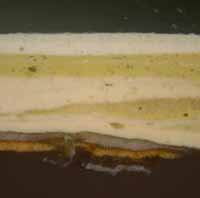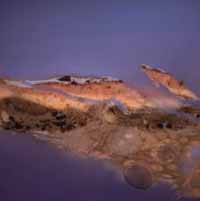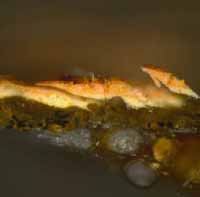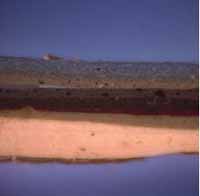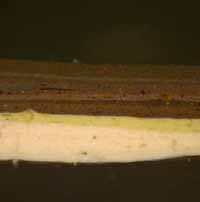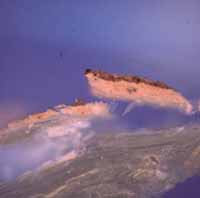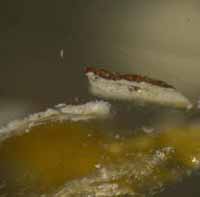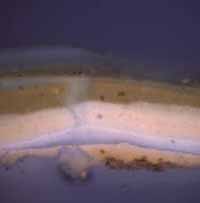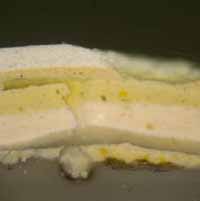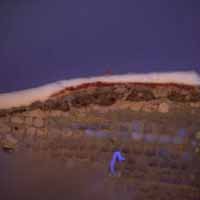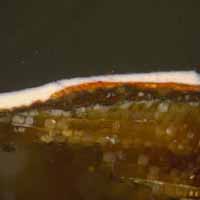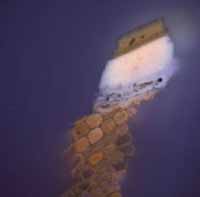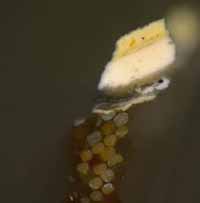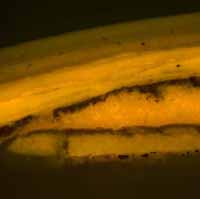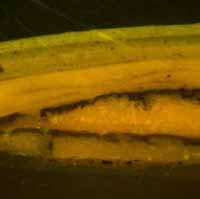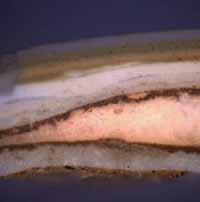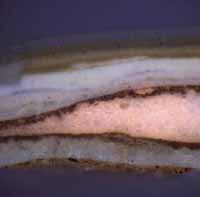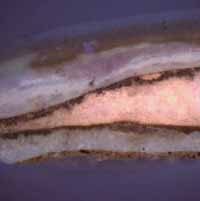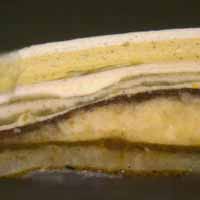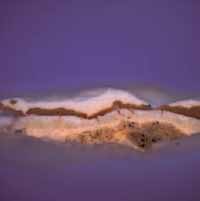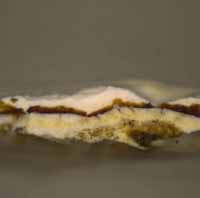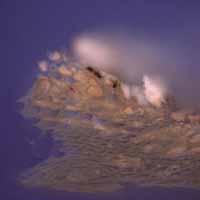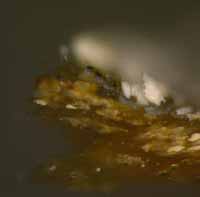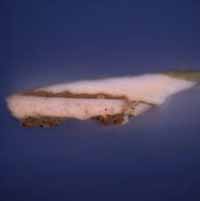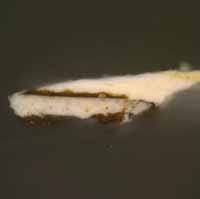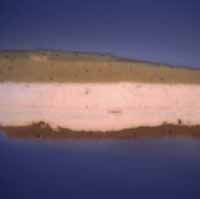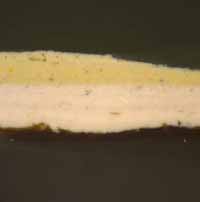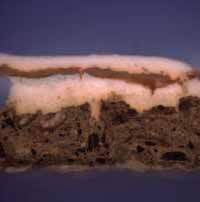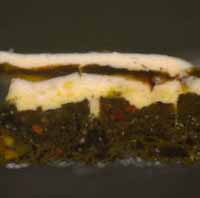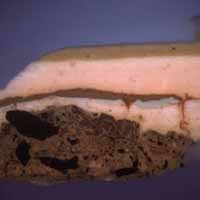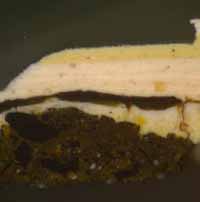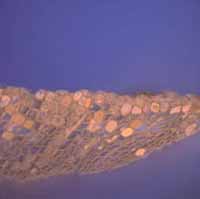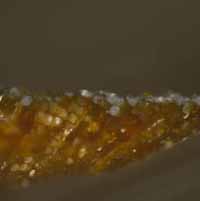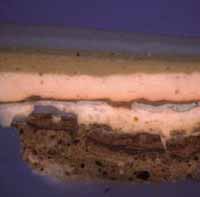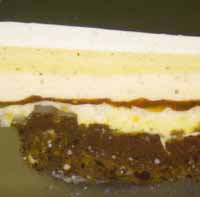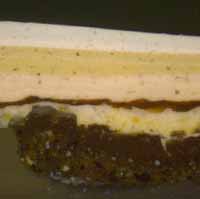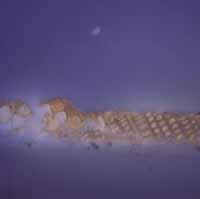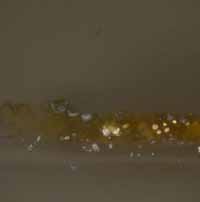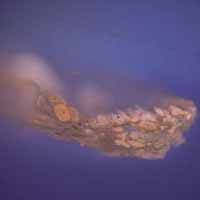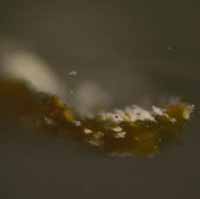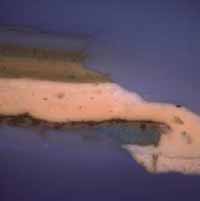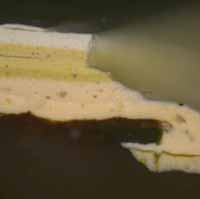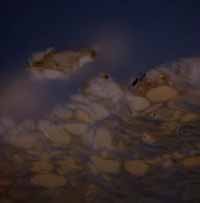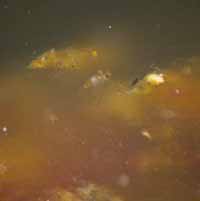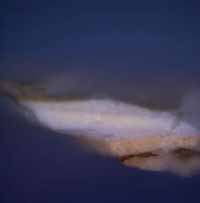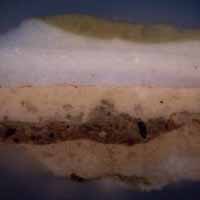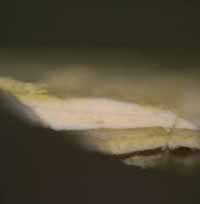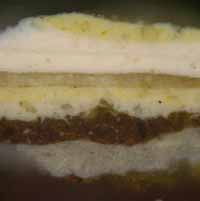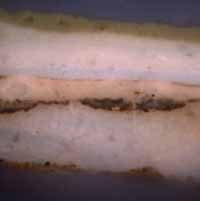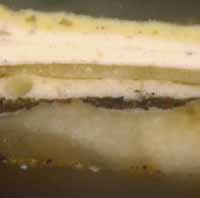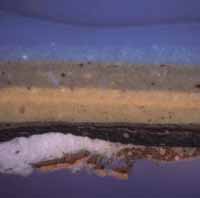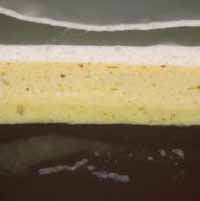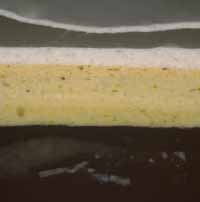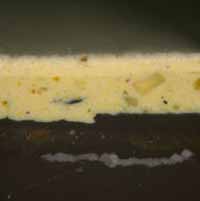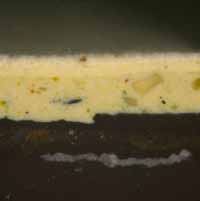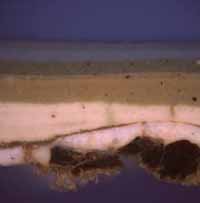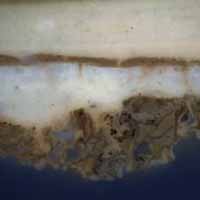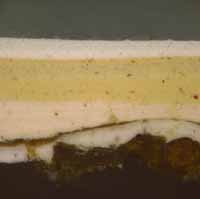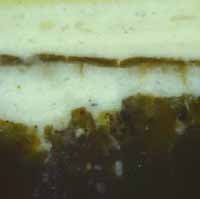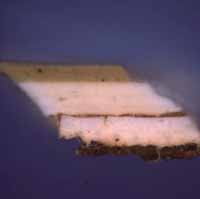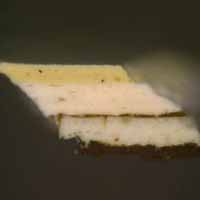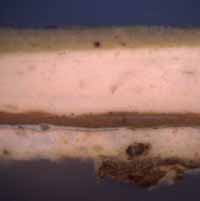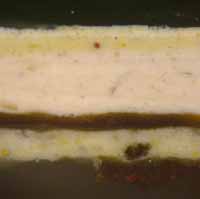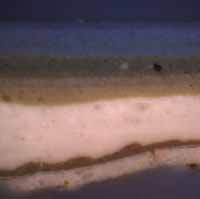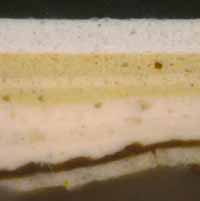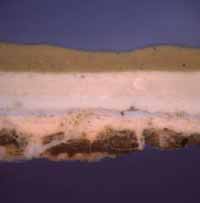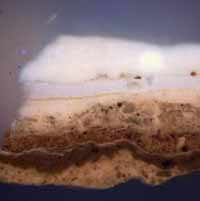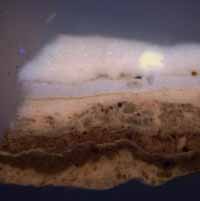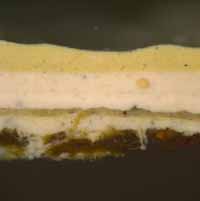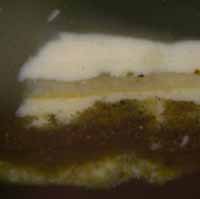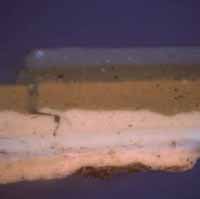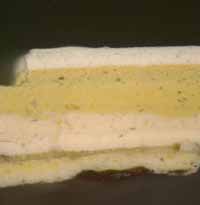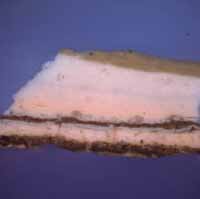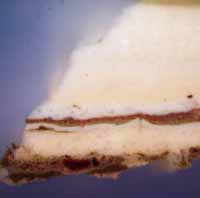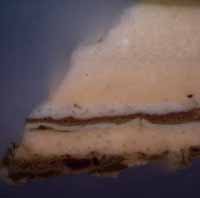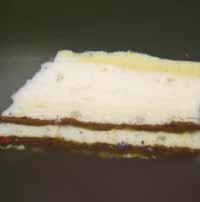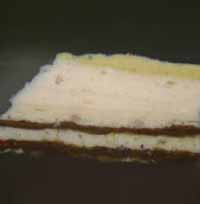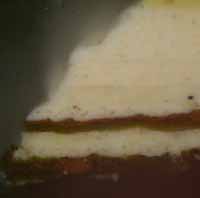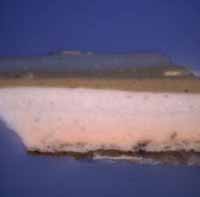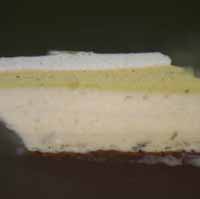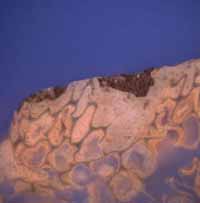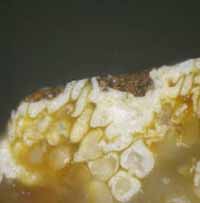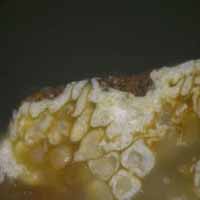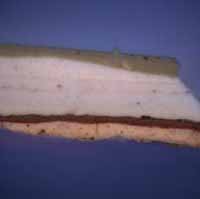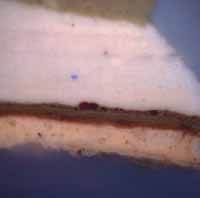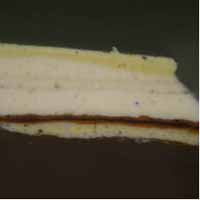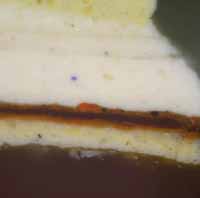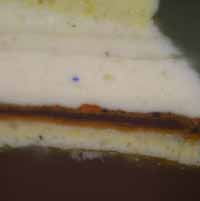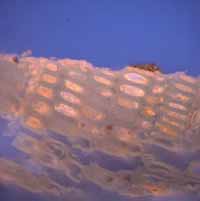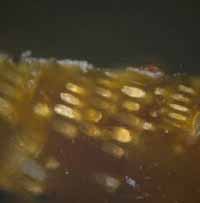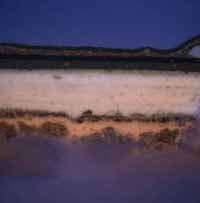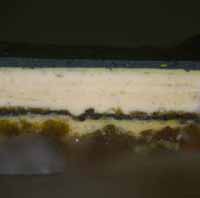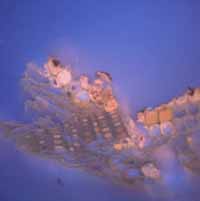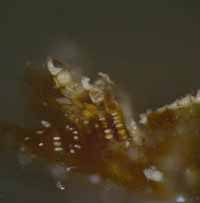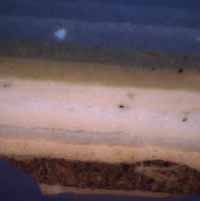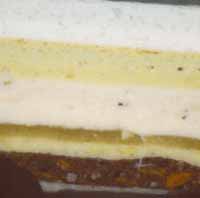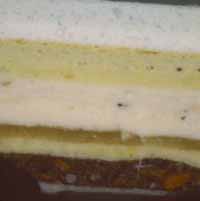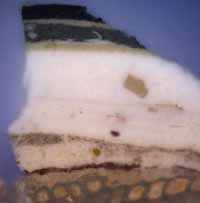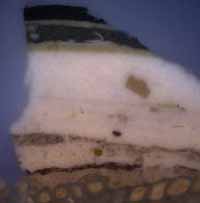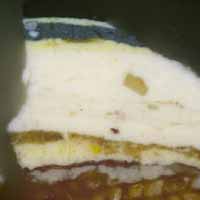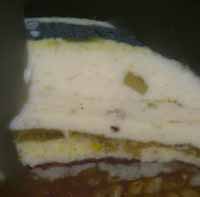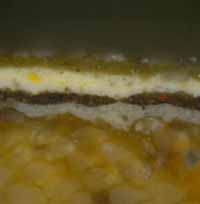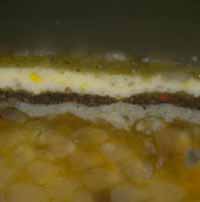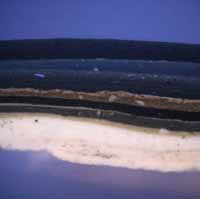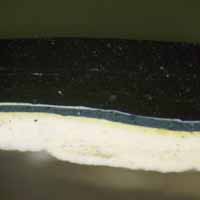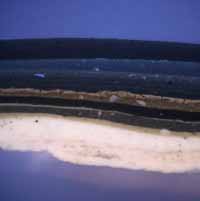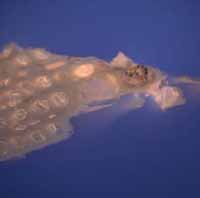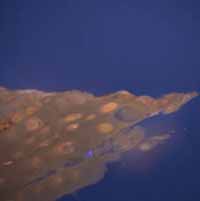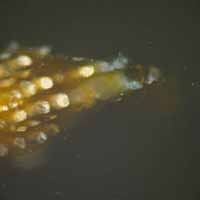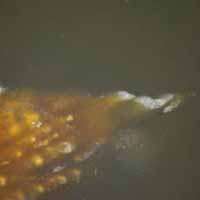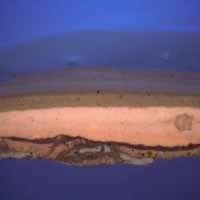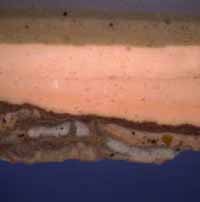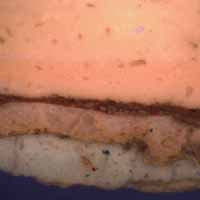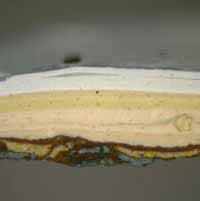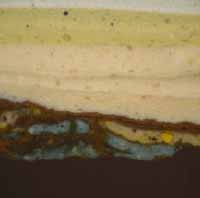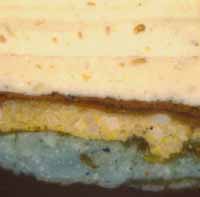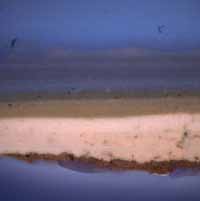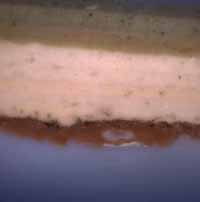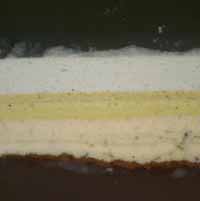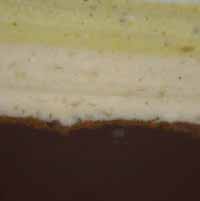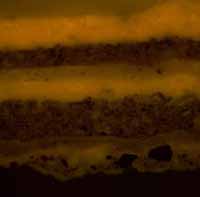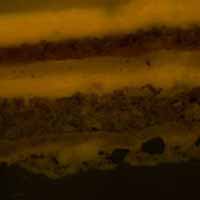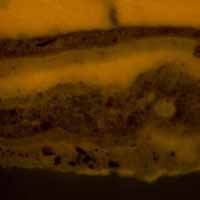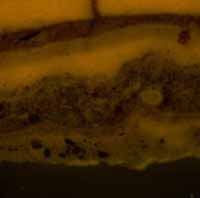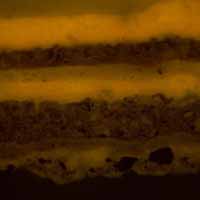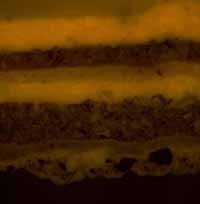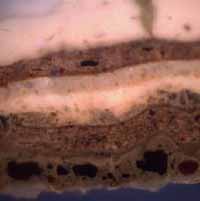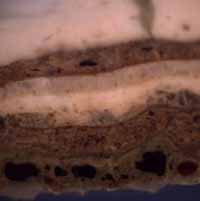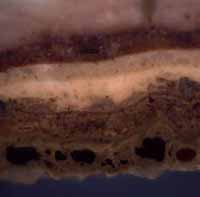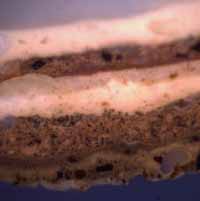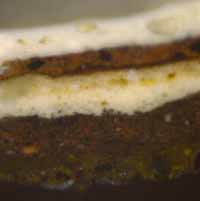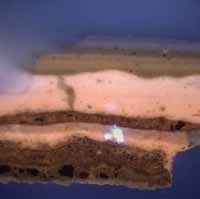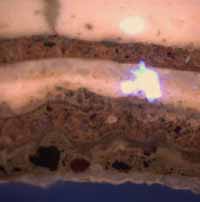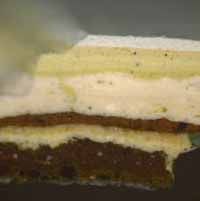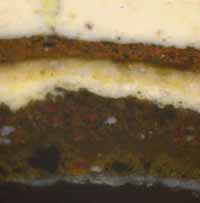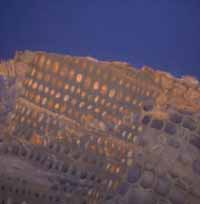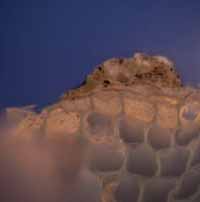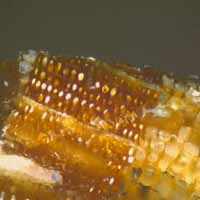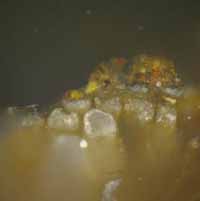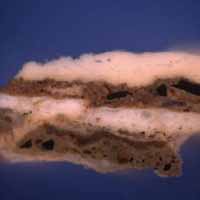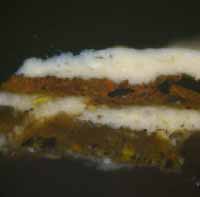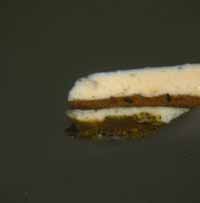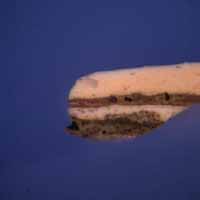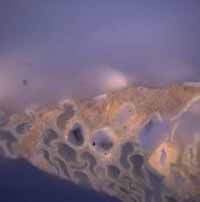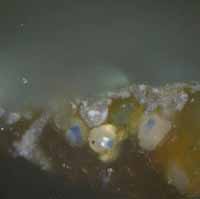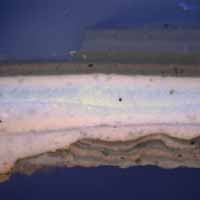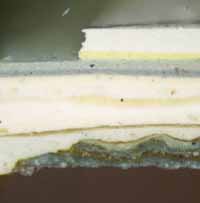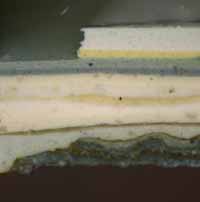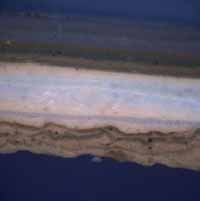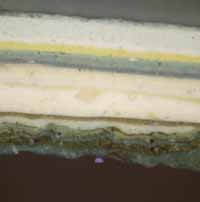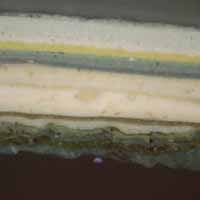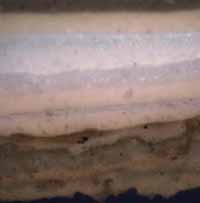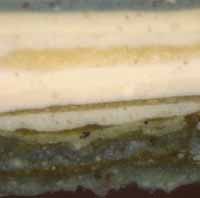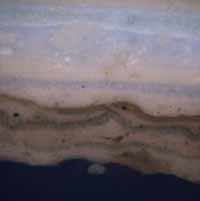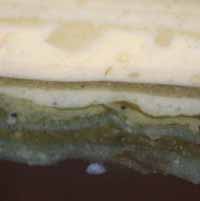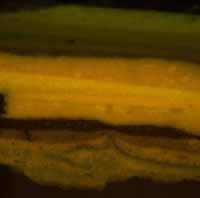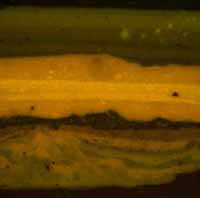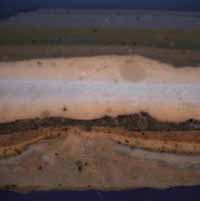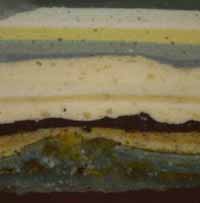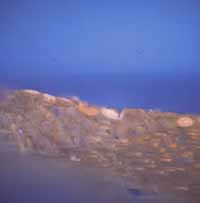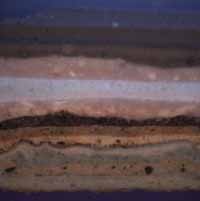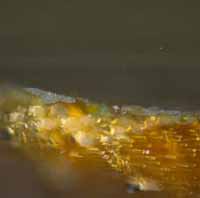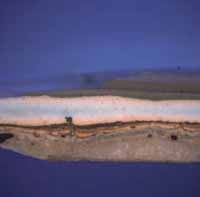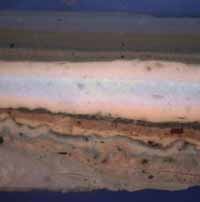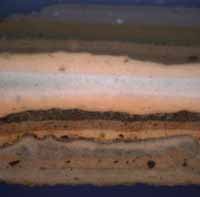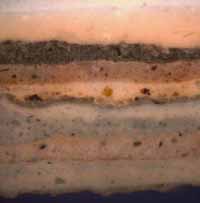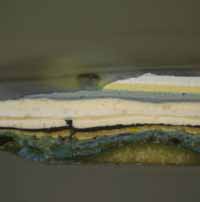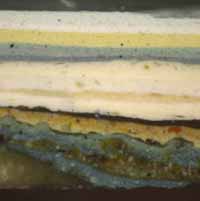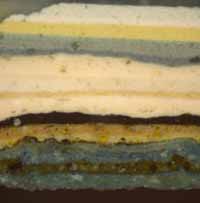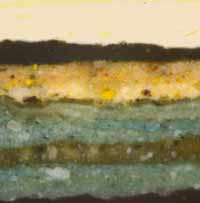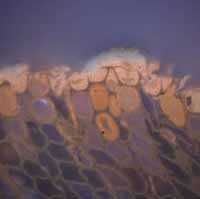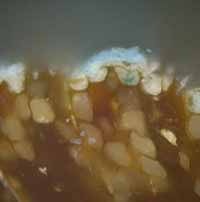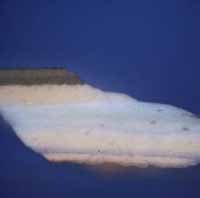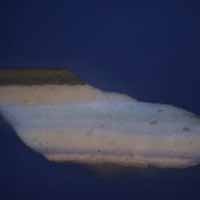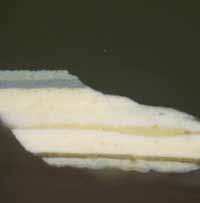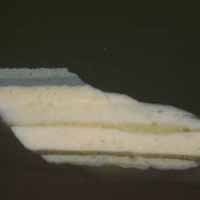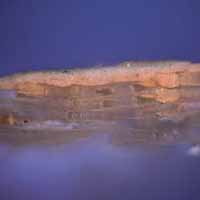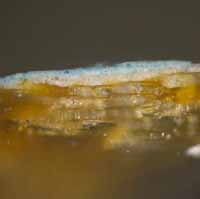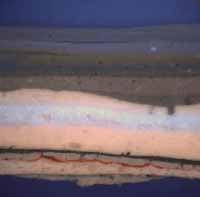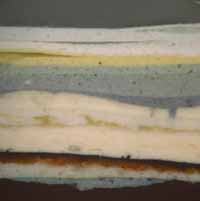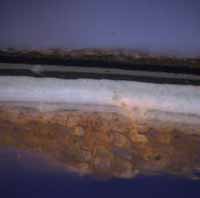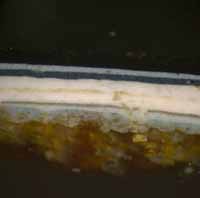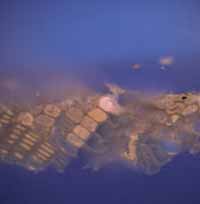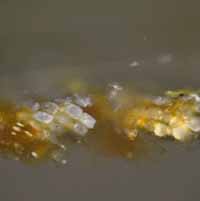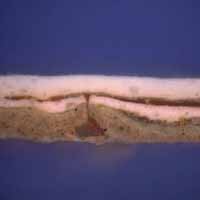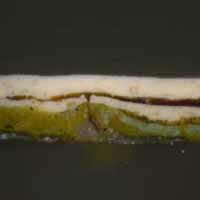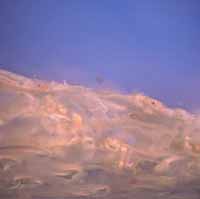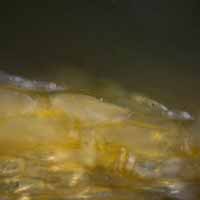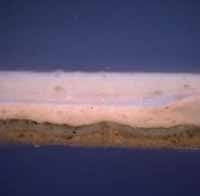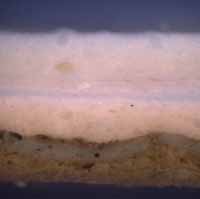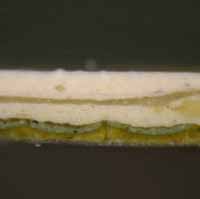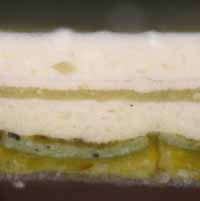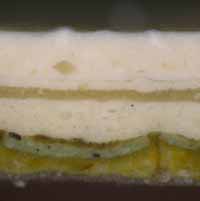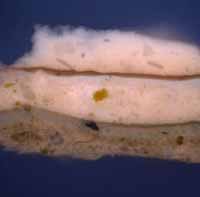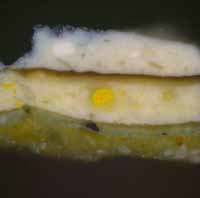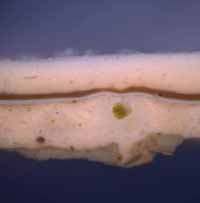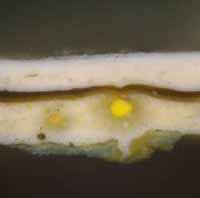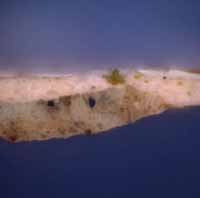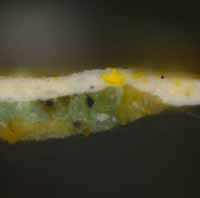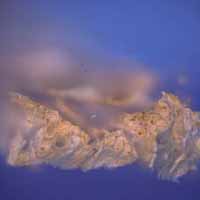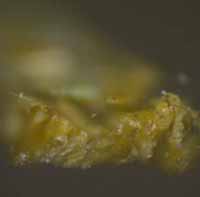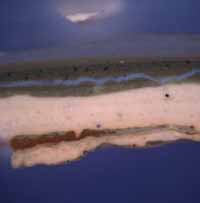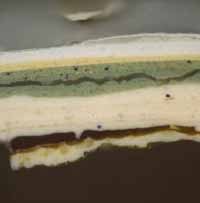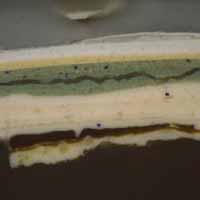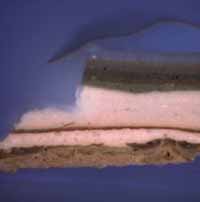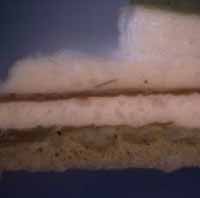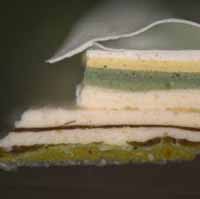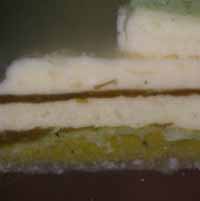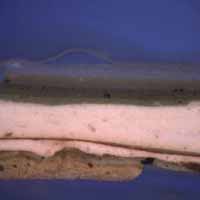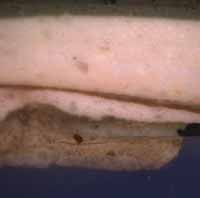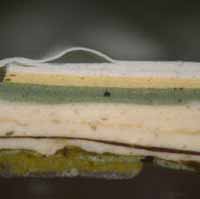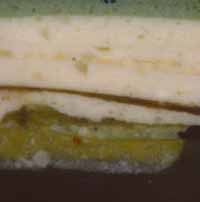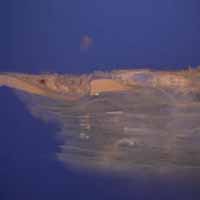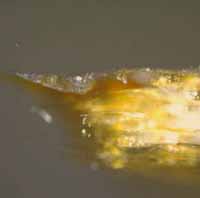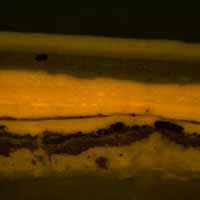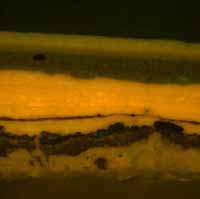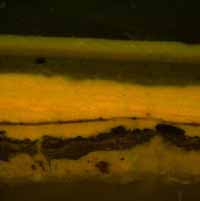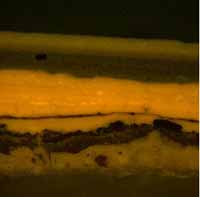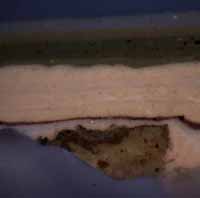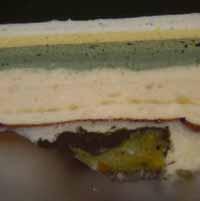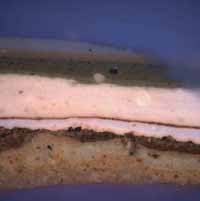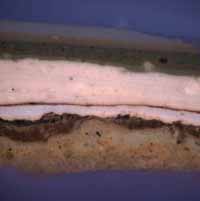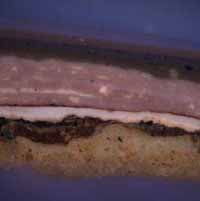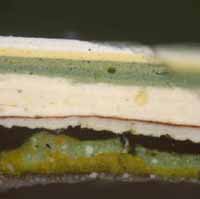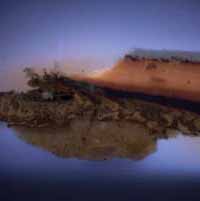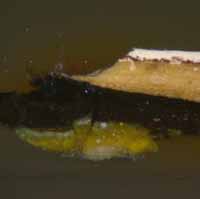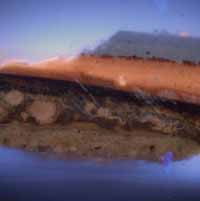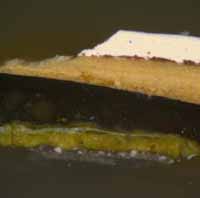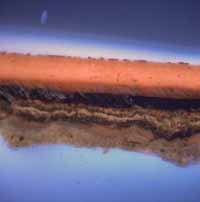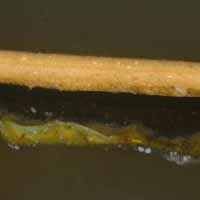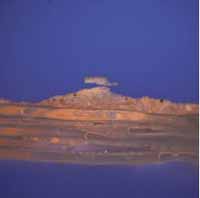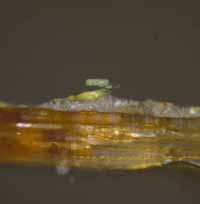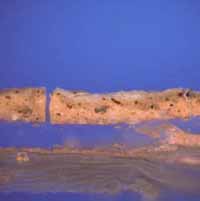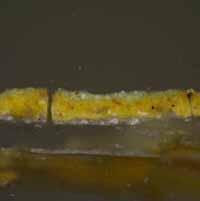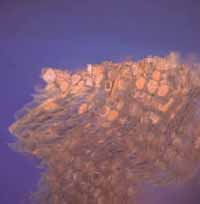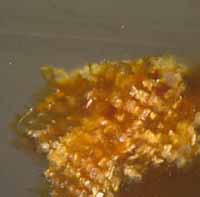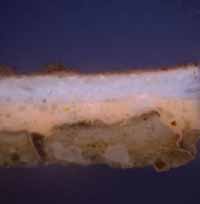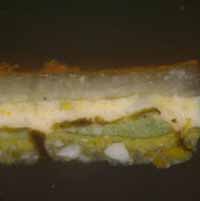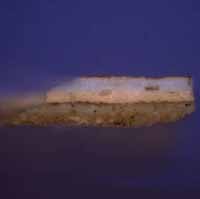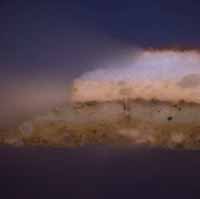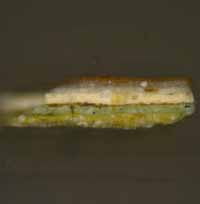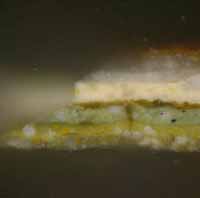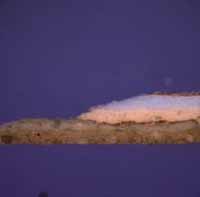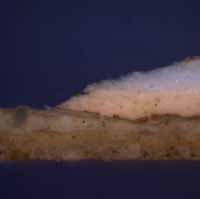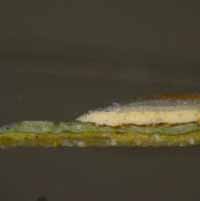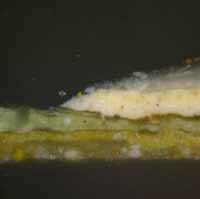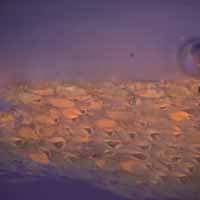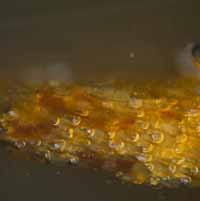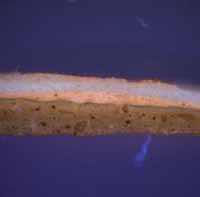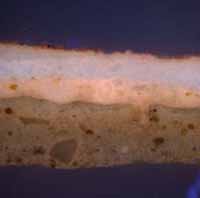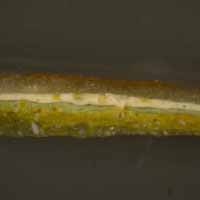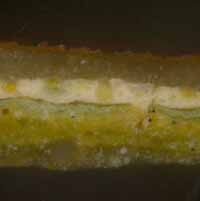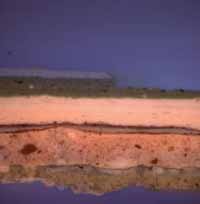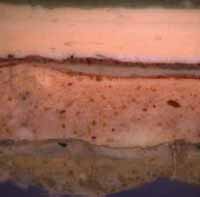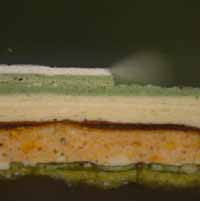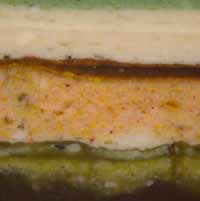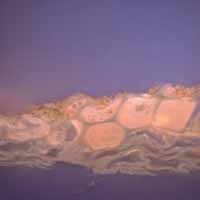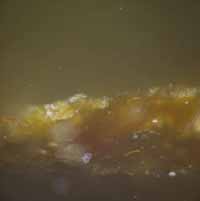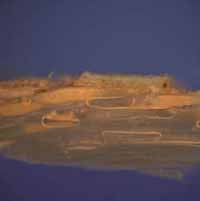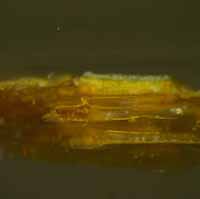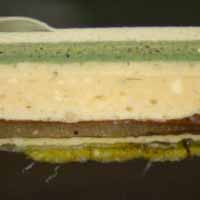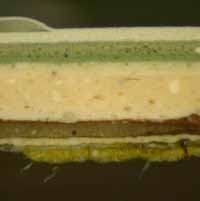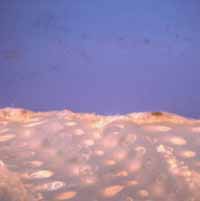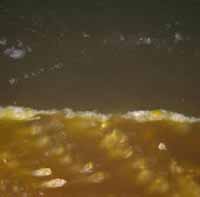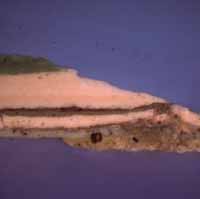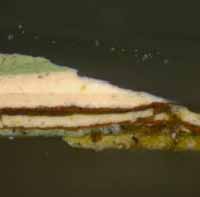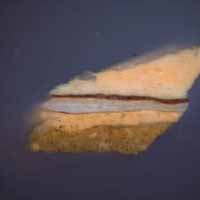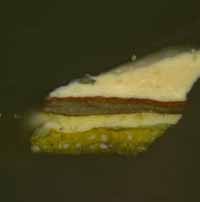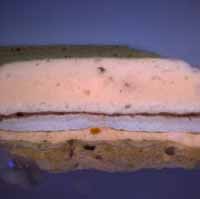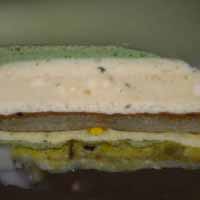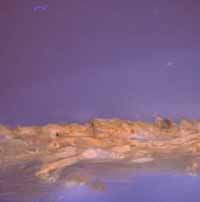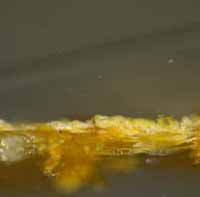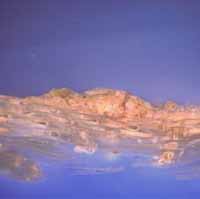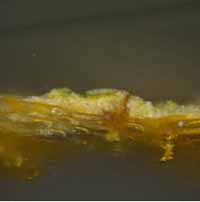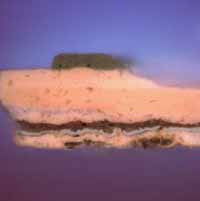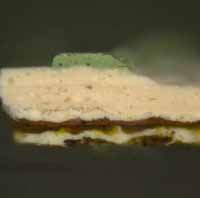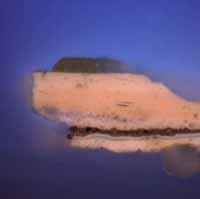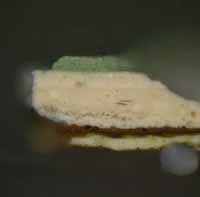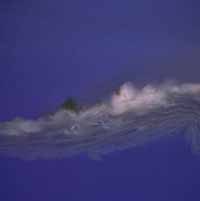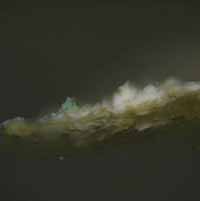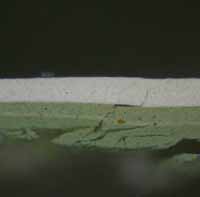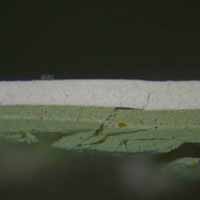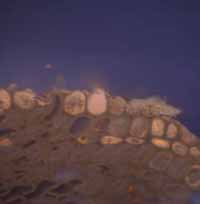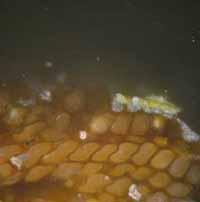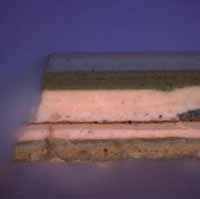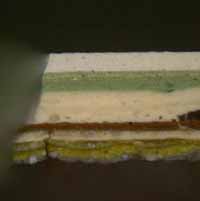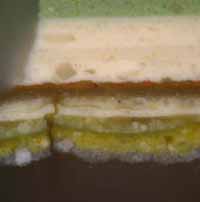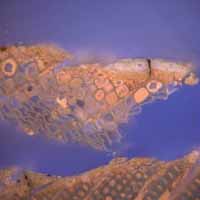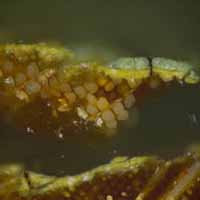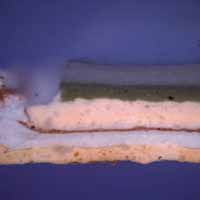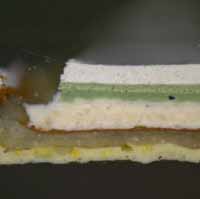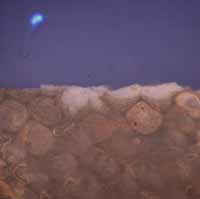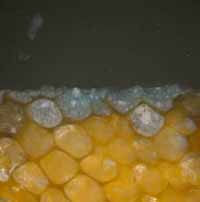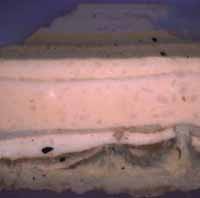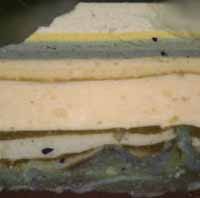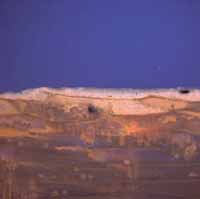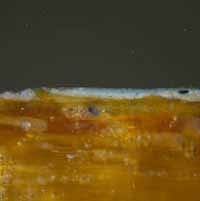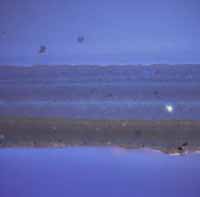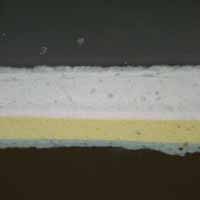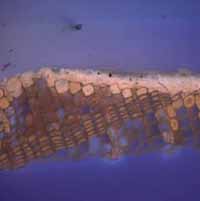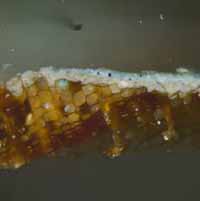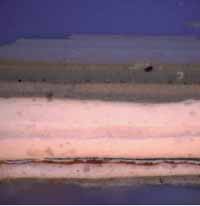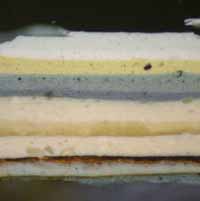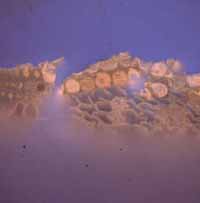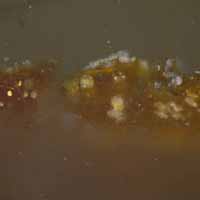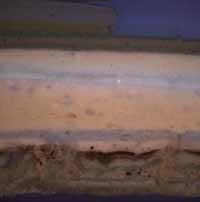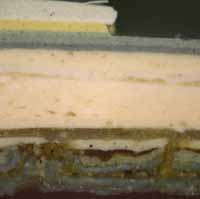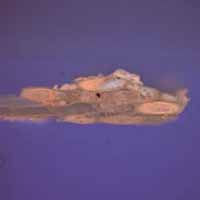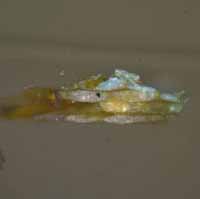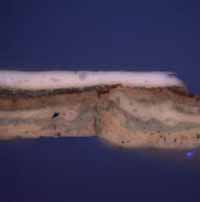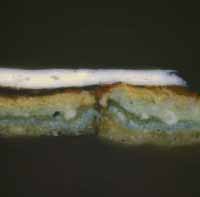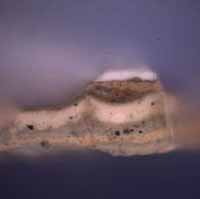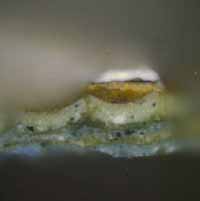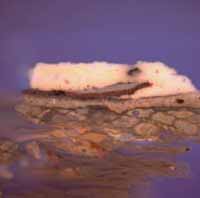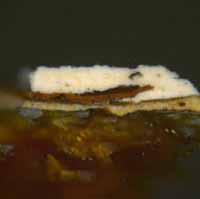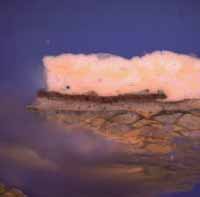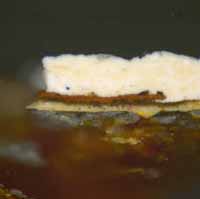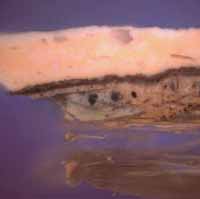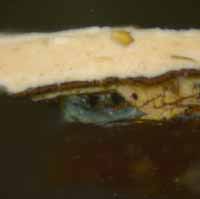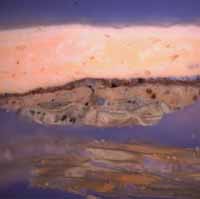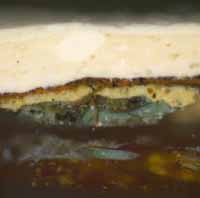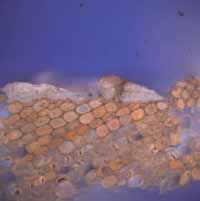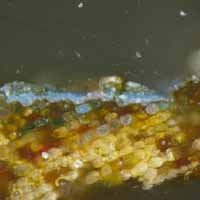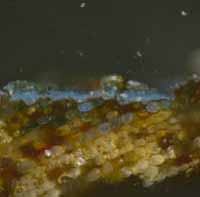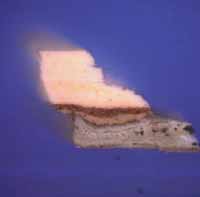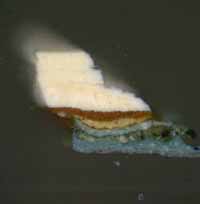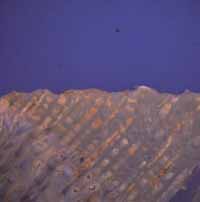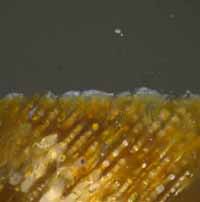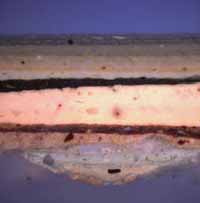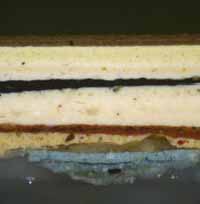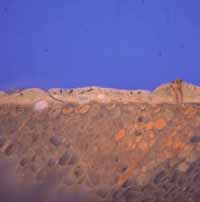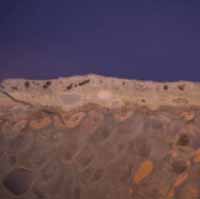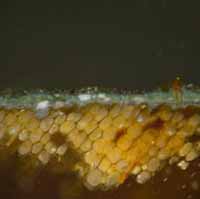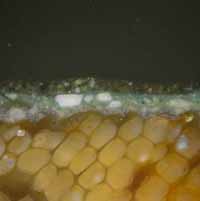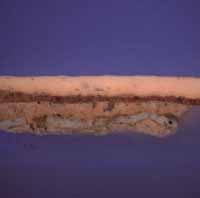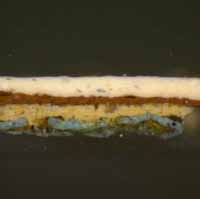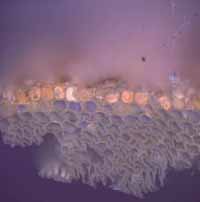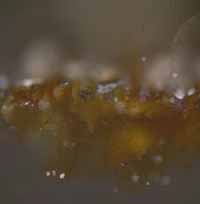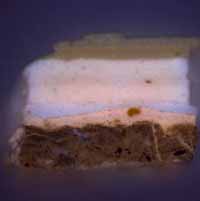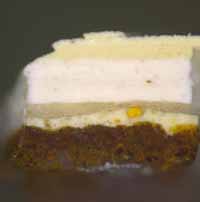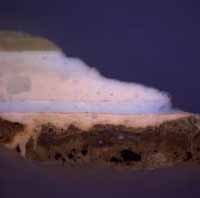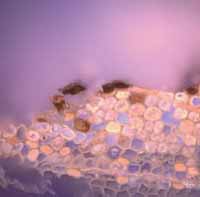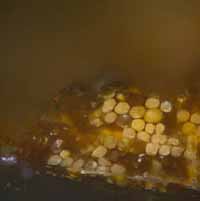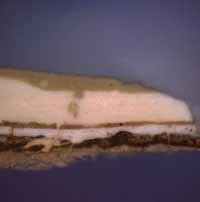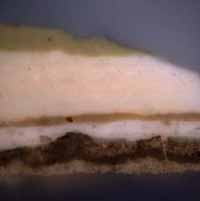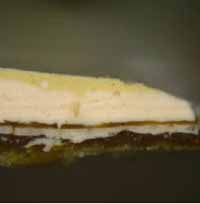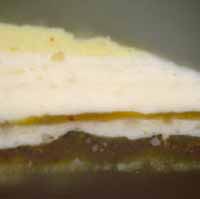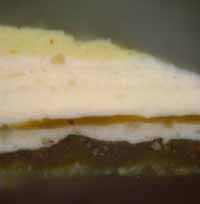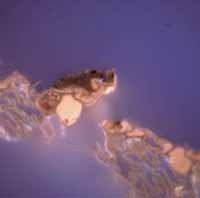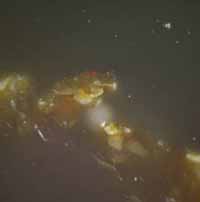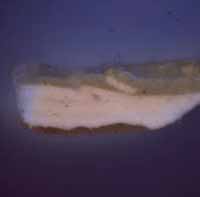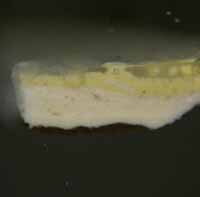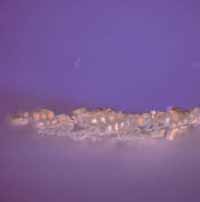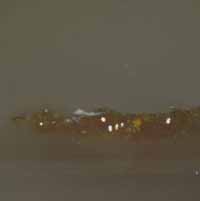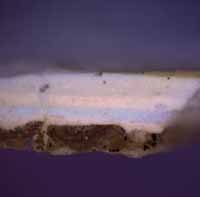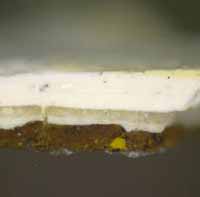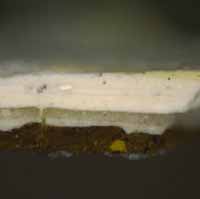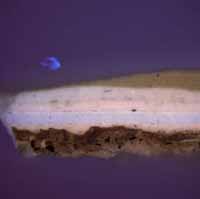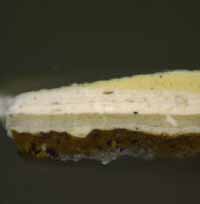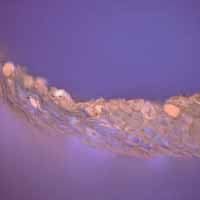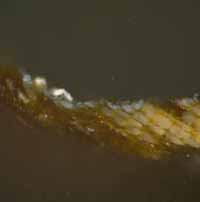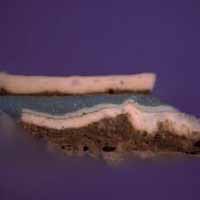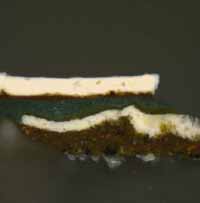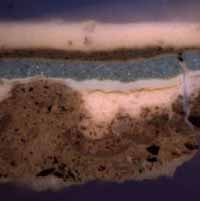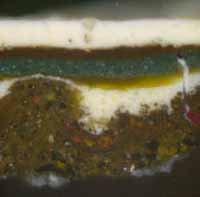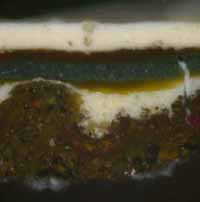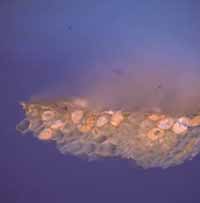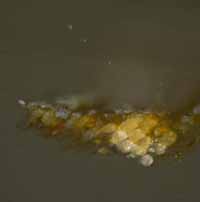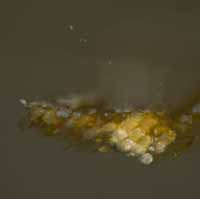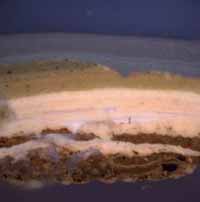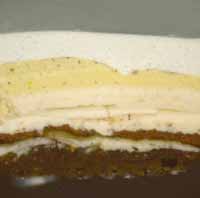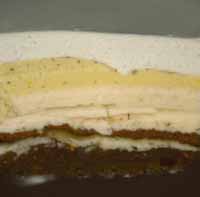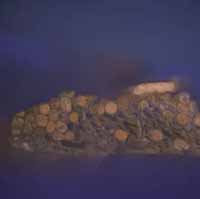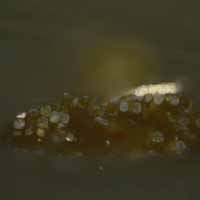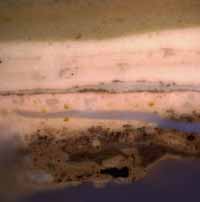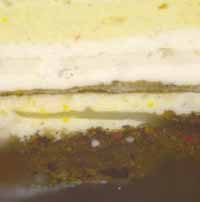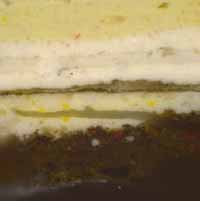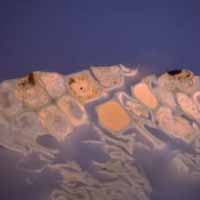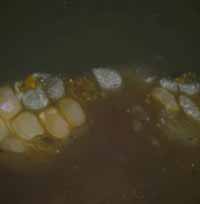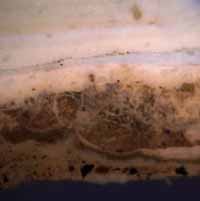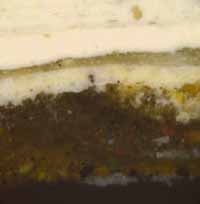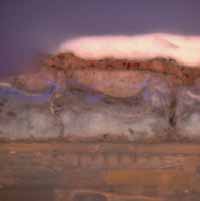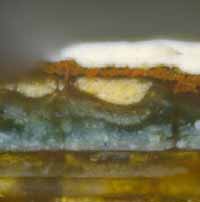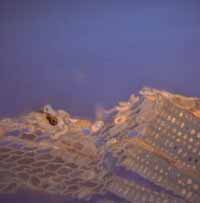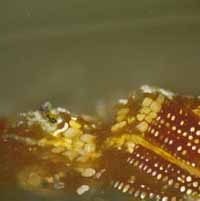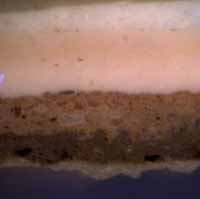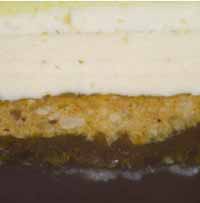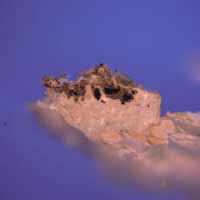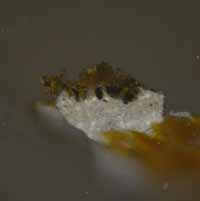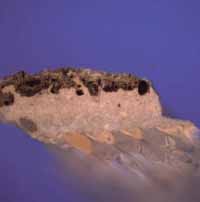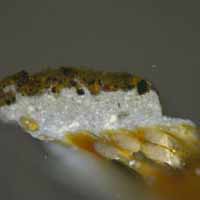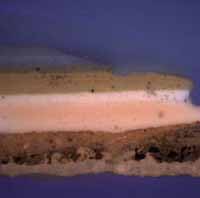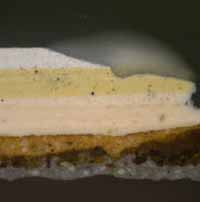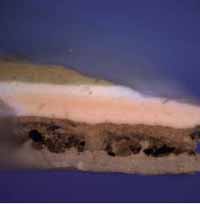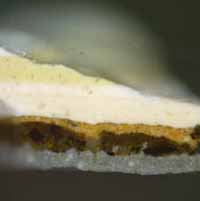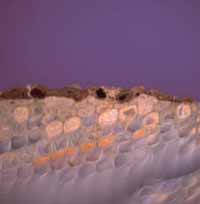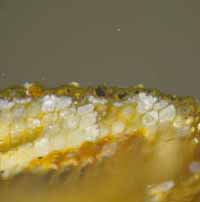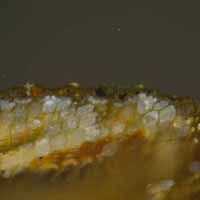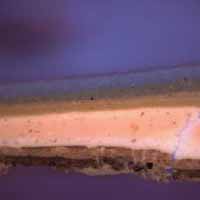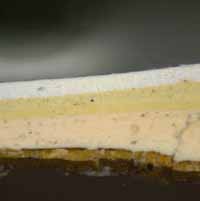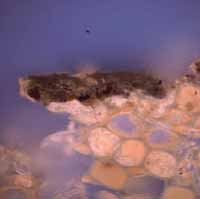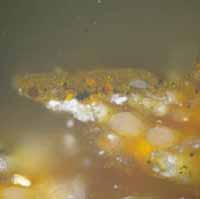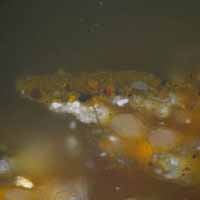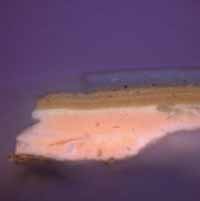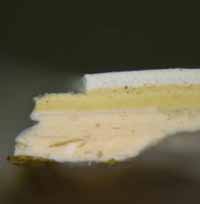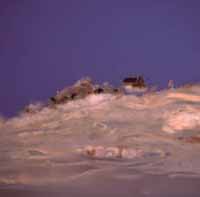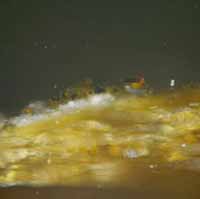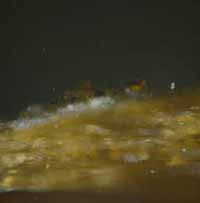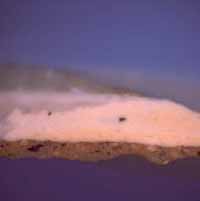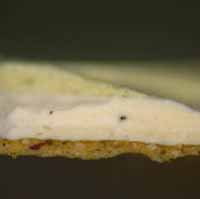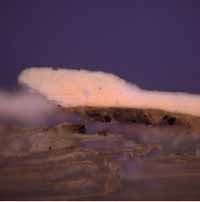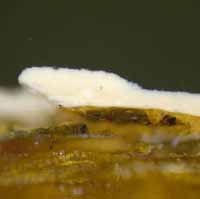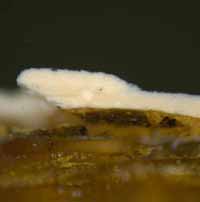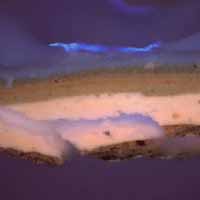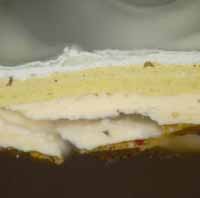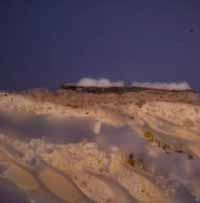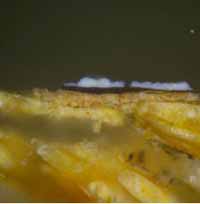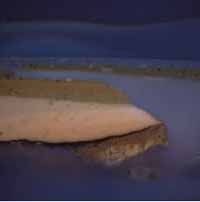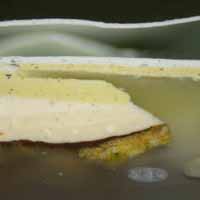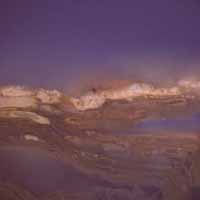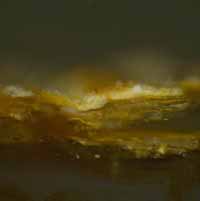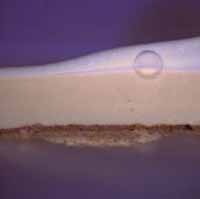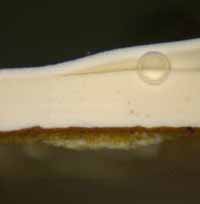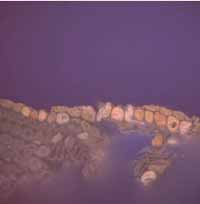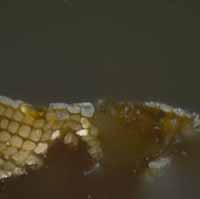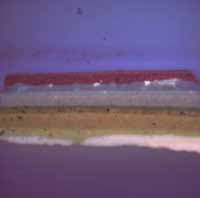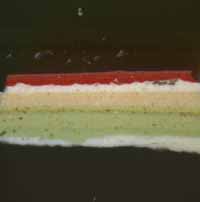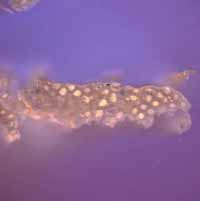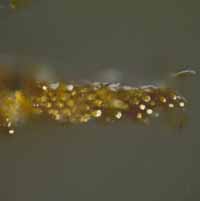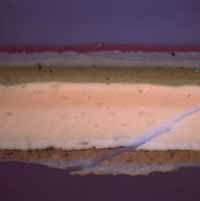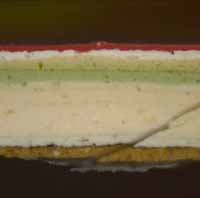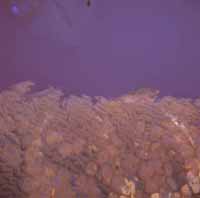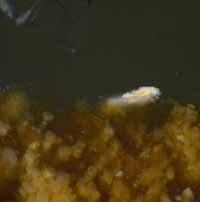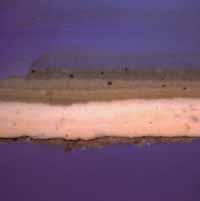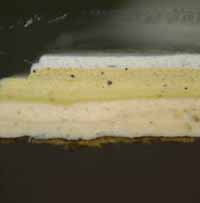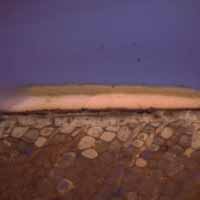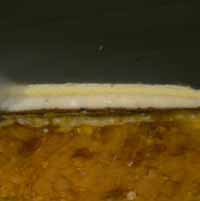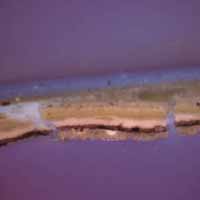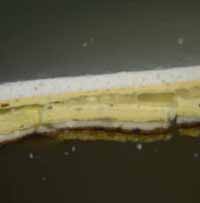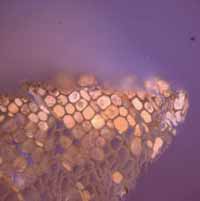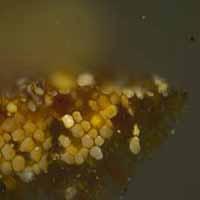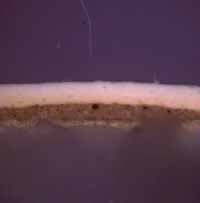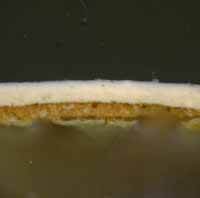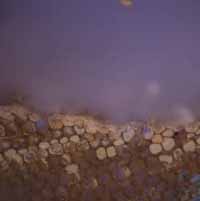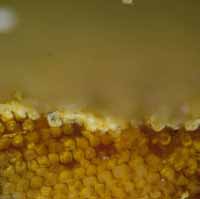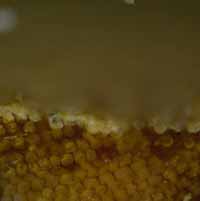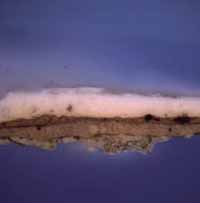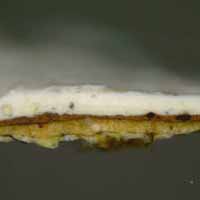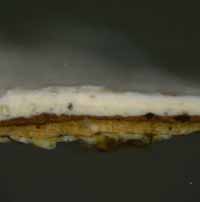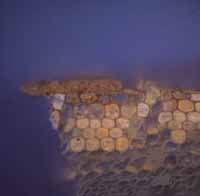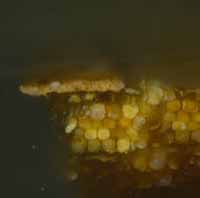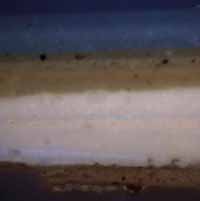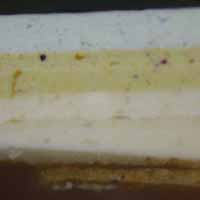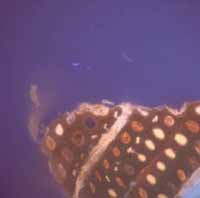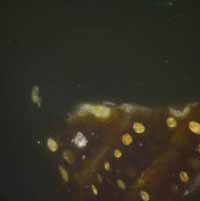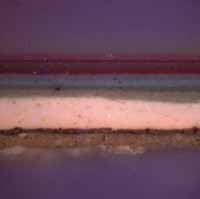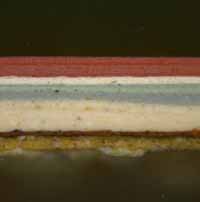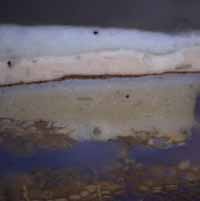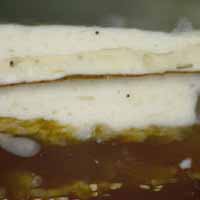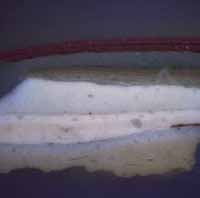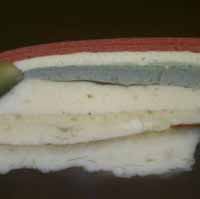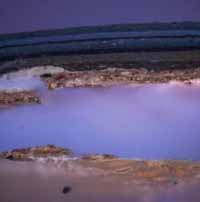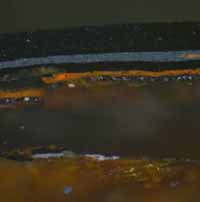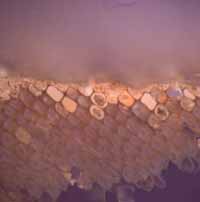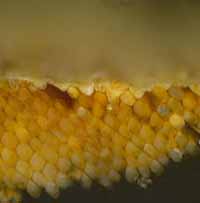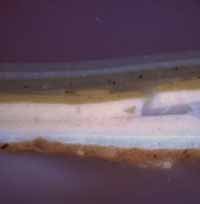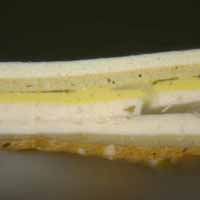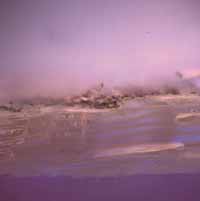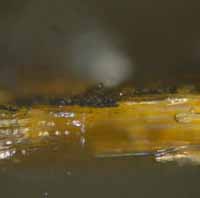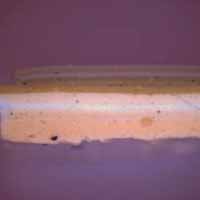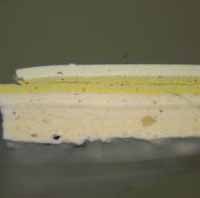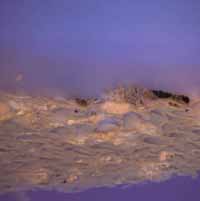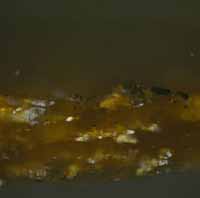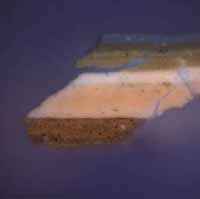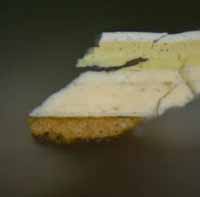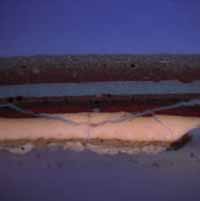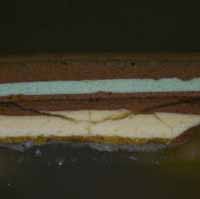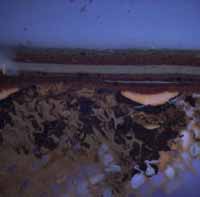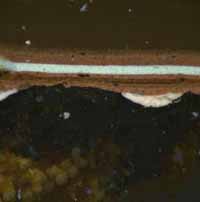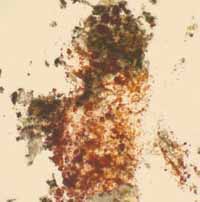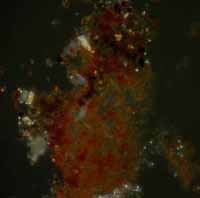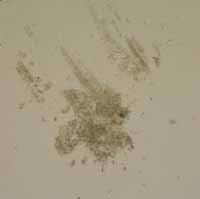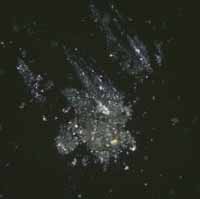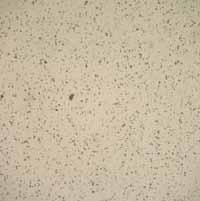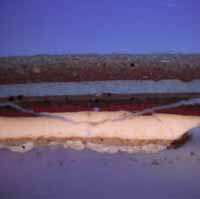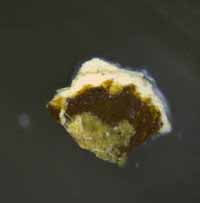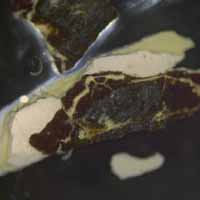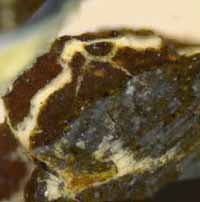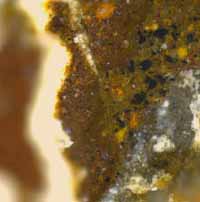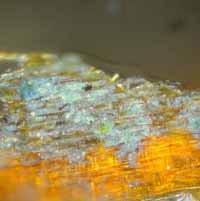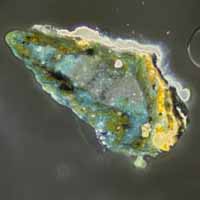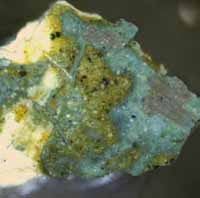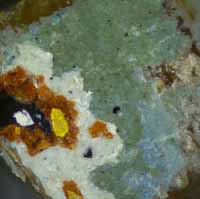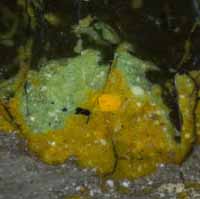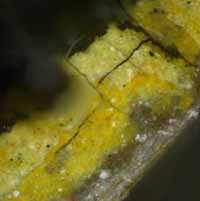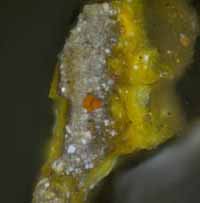Cross-section Microscopy Analysis of Interior Paints: Robert Nicolson House (Block 7, Building 12)Robert Nicolson House Interior Paint Analysis Report_with photomicrograph appendix
Colonial Williamsburg Foundation Library Research Report Series - 1757
Colonial Williamsburg Foundation Library
Williamsburg, Virginia
2013
CROSS-SECTION MICROSCOPY ANALYSIS REPORT
ROBERT NICOLSON HOUSE, INTERIOR FINISHES
Block 7, Building 12
COLONIAL WILLIAMSBURG FOUNDATION
WILLIAMSBURG, VIRGINIA
| Purpose | 4 |
| History | 4 |
| Previous Research | 5 |
| Procedures | 5 |
| Results | 6 |
| First-Floor Southeast Room | |
| Discussion of Results | 7 |
| Table 1. First-Floor SE Room — Paint History | 9 |
| Sample Location Photos | 10 |
| Cross-section Photomicrographs | 11 |
| Binding Media Analysis | 21 |
| Pigment ID | 24 |
| Colorimetry | 27 |
| First-Floor Northeast Room | |
| Discussion of Results | 33 |
| Table 2. First-Floor NE Room — Paint History | 34 |
| Sample Location Photos | 35 |
| Cross-section Photomicrographs | 36 |
| First-Floor Stair Passage | |
| Discussion of Results | 40 |
| Table 3. First-Floor Stair Passage — Paint History | 44 |
| Sample Location Photos | 45 |
| Cross-section Photomicrographs | 52 |
| Binding Media Analysis | 79 |
| Pigment ID | 83 |
| Colorimetry | 88 |
| First-Floor Southwest Room | |
| Discussion of Results | 91 |
| Table 4. First-Floor SW Room — Paint History | 92 |
| Sample Location Photos | 93 |
| Cross-section Photomicrographs | 94 |
| Binding Media Analysis | 99 |
| Pigment ID | 102 |
| Colorimetry | 105 |
| First-Floor Northwest Room | |
| Discussion of Results | 108 |
| Table 5. First-Floor NW Room — Paint History | 109 |
| Sample Location Photos | 110 |
| Cross-section Photomicrographs | 112 |
| Second-Floor Stair Passage | |
| Discussion of Results | 116 |
| Table 6. Second-Floor Stair Passage — Paint History | 117 |
| Sample Location Photos | 118 |
| Cross-Section Photomicrographs | 119 |
| 3 | |
| Second-Floor Present Bathroom | |
| Discussion of Results | 124 |
| Cross-Section Photomicrographs | 125 |
| Second-Floor Northeast Room | |
| Discussion of Results | 126 |
| Sample Location Photographs | 126 |
| Cross-Section Photomicrographs | 127 |
| Second-Floor Southeast Room | |
| Discussion of Results | 129 |
| Sample Location Photographs | 130 |
| Cross-Section Photomicrographs | 131 |
| Second-Floor West Passage | |
| Discussion of Results | 133 |
| Sample Location Photographs | 134 |
| Cross-Section Photomicrographs | 135 |
| Second-Floor Southwest Room | |
| Discussion of Results | 137 |
| Sample Location Photographs | 137 |
| Cross-Section Photomicrographs | 138 |
| Second-Floor Northwest Room | |
| Discussion of Results | 140 |
| Sample Location Photographs | 141 |
| Cross-Section Photomicrographs | 142 |
| Conclusions | 144 |
| References | 147 |
| Appendix A. Analytical Procedures | 148 |
| Appendix B. Sample Memo (E. Chappell, July 26, 2013) | 151 |
| Appendix C. Sample Memo (K. Travers, July 3, 2013) | 154 |
| Appendix D. Sample Memo (K. Travers, August 9, 2013) | 155 |
| Appendix E. Photomicrograph Contact Sheet | attached |
Robert Nicolson House Interior, Cross-Section Microscopy Report
September 2013
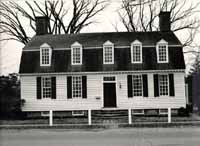 Robert Nicholson House exterior, block 7, building 12 [history.org]
Robert Nicholson House exterior, block 7, building 12 [history.org]
| Structure: | Nicholson House, block 7, building 12 |
|---|---|
| Requested by: | Edward Chappell Roberts Director of Architectural and Archaeological Research, Colonial Williamsburg Foundation |
| Analyzed by: | Kirsten Travers, Paint Analyst, Colonial Williamsburg Foundation |
| Consulted: | Susan L. Buck, Ph.D., Conservator and Paint Analyst, Williamsburg, Virginia |
| Date submitted: | September 2013 |
Purpose:
The goal of this project is to use cross-section microscopy techniques to explore the early interior paint history of the Robert Nicholson House, to better understand the arrangement of spaces and finish, as well as the evolution of spaces in the early history of the building.
Another objective was to determine if the two known periods of construction (see History section below) could be identified through the paint stratigraphy, and if the paint could shed light on how much time elapsed between these periods.
History:
Dendrochronology indicates the Nicolson House was built c. 1751 on what was at that time, the outskirts of Williamsburg1 (Heikkenen 1990, 2). The earliest section [the east portion] was a story-and-one-half, gambrel roof dwelling with a double pile side passage plan. In 1764, Nicolson added the two-bay extension on the west end, creating a more symmetrical five-bay, central passage plan. The date of the west extension was also confirmed through dendrochronology (Heikkenen, ibid).
Robert Nicolson was a merchant and tailor who was prominent in civic affairs, but from 1755 to 1777 he was also taking in lodgers at his residence. He appears to have conducted his business off-site, since he is recorded as having a tailoring shop "across the road" (no longer extant), and he later moved his business to the store on Duke of Gloucester street still known today as the Nicholson Shop. He lived in the house on York street until his death in 1797 (Wenger 1986, and Savedge, 1976).
Previous Research:
In 2006, Susan Buck examined two exterior samples (window frame and the cornice, collected by Ed Chappell), to facilitate the imminent repainting of the house. The period of interpretation was 1764, when the house achieved its present form. Buck determined that the two periods of construction were reflected in the paints, and that there were approximately sixteen generations extant, with the earliest (1764) paint being a "medium tan" color, and generations 2-5 being cream-colored. Generation two was chosen for matching, as this reflected the second period color (Buck 2006, 1).
In May 2007, Natasha Loeblich took a more extensive look at additional samples from exterior surfaces (cornice, window trim, front and rear doors), which resulted in a re-interpretation of some of the earlier findings. She also found that the two periods of construction were reflected in the paint stratigraphy, but she did not find the medium tan color. Samples from the two easternmost windows on the front elevation begin with four generations of cream-colored paint, with generation five containing zinc white (post 1845). Samples from the western windows, which date to the second period of construction, contained only two generations of cream-colored paint, before the fifth generation zinc white paint. This suggested that the house was painted twice with cream-colored paints before the addition was constructed. No early paints could be found on the cornice.
The front and rear doors had similar early paints and appeared to be first period. The first generation finish on both doors is a cream-colored base coat and a black finish coat. Generation two is another black paint. Both generations were very worn and disrupted, suggesting a long period of exposure (Loeblich 2007, 20).
Procedures:
To date, 103 paint samples have been removed from the Nicolson House interior by Kirsten Travers (Paint Analyst), accompanied by Edward Chappell (Roberts Director of Architectural and Archaeological Research). On site, a monocular 30x microscope was used to examine the painted surfaces to determine the most appropriate areas for sampling. A microscalpel was used to remove the samples, and sampling locations were recorded and photographed. Samples were labeled and stored in small, individual Ziploc bags for transport. All samples were given the prefix "NI", and numbered according to the space where they were taken (see Appendix C for floor plans and numerical designation of rooms), and the order in which they were collected. A complete list of sample locations is found in Appendix B.
In the laboratory, the samples were examined with a stereomicroscope under low power magnification (5x to 50x), to identify those that contained the most paint evidence and would therefore be the best candidates for cross-section microscopy. Uncast portions were retained for future examination and analysis, if necessary. The best candidates were cast in resin cubes and sanded and polished to expose the cross-section surface for microscopic examination. Please see Appendix A for sample preparation details.
The cross-section samples were examined and digitally photographed in reflected visible and ultraviolet light conditions at 100x to 400x magnifications. By comparing the resulting photomicrographs, finish generations could be interpreted based on physical characteristics such as color, texture, thickness, presence of dirt layers and extent of surface deterioration.
Results:
This study found significant paint evidence on woodwork throughout the house that sheds light on the early color schemes and structural evolution of the interior. In this report, the results are organized according to room: the first-floor southeast room is discussed first, followed by the first-floor northeast room and the stair passage, these being Period 1 (c.1751) spaces. This is followed by the first-floor southwest room and northwest room, which date to Period 2 (c.1764).
The report continues with second-floor spaces, starting with the stair passage and eastern rooms (again, these date to Period 1), and the spaces at the western end of the house, which date to Period 2 (c.1764).
Photomicrographs of paint stratigraphies have been annotated according to finish generation. For instance, a primer, paint layer, and varnish may represent one finish generation and are all given the same number, but differentiated with lowercase letters (1a, 1b, 1c, etc.). Since many samples contained redundant evidence, only the most relevant cross-section photomicrographs are presented in this report. The analytical results and pertinent observations are discussed adjacent to the photomicrographs. The results are interpreted in the conclusion, and all raw photomicrographs can be found in the appendix at the end of this report.
First-Floor Southeast Room [Room 107]
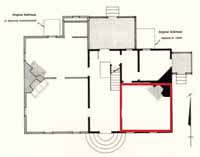 First floor plan, Robert Nicolson House Southeast room is outlined in red
First floor plan, Robert Nicolson House Southeast room is outlined in red
Discussion of Results: This study found that the woodwork in the first-floor southeast room retains excellent, intact paint evidence that elucidates the decorative and structural history of this room. The first five finish generations are deep blue paints, and the presence or absence of certain generations helped reconstruct the history of this room in two specific phases (see photomicrographs below), in particular, that the wainscot panelling is later than the rest of the woodwork.
According to the architectural report (Wenger 1986, 35), parts of the mantel are original. However, on site multiple excavations were made and this element appeared to contain only modern paints, and was not sampled.
Generation 1: This reflects the earliest form of the house, which dates to c.1751 and consists of the stair passage and eastern rooms on the first and second floors, including this room. The paint analysis suggests that in this period, the woodwork in this room was sealed with shellac (identified by its orange autofluorescence in the wood cells), and primed with a thin gray-colored primer (generation 1a), made with lead white, chalk, carbon black, and a few earth pigments. This is the same gray primer used in the adjacent stair passage (see Stair Passage section, p. 40). This primer was then painted with two layers of deep blue-green paint (generations 1b and 1c), composed of lead white, Prussian blue, and a small amount of yellow earth pigment. There is a very thin layer of grime on the surface of this paint.
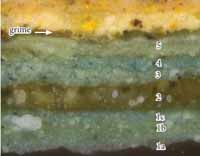 NI 43b, visible light, 400x (door leaf to passage)
NI 43b, visible light, 400x (door leaf to passage)
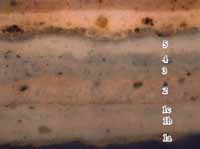 NI 43b, UV light, 400x (door leaf to passage)
NI 43b, UV light, 400x (door leaf to passage)
The presence of this paint helped identify first period elements. It was found on the west wall door architrave and leaf (see samples NI 42 and 43, pp. 11-14), the north wall door architrave and leaf (NI 69 and 70, pp. 15-16), and the window architraves on the south wall (NI 66, p. 17). Although only the easternmost window was sampled, the western window was examined and found to contain the same paints.
Generation 2: This paint was also found on all first period elements. In cross-section, this layer is thick, translucent, and greenish, with small dark particles suspended within it. Under UV light, it has a brighter, orange-colored autofluorescence suggestive of a shellac resin, which would have been very glossy. PLM determined that the dark pigment particles are actually indigo, a blue pigment that is known to have been imported into Williamsburg, but one that has not yet been identified in a house interior to date (based on the author's knowledge). Although today this finish is very green (see color match, p. 30), this could result from oxidation of the resinous media, and/or pigment fading (Bristow 1996, 14). The actual color would have to be determined through mock-ups using traditional materials.
Generations 3 and 4: These paints were also found on all first period elements. Both generations are coarsely ground blue paints of almost identical color. In most samples, they looked like a single generation with no boundary between them, suggesting they were applied within a relatively short period of time. However, a few samples illustrated this boundary (see sample NI 43, p. 13), suggesting these are actually two separate, albeit very similar, paint generations.
Generation 5: This was the earliest paint on the wainscot panels and baseboards (see samples NI 44-46, pp. 18-20), an indication that these elements are later. This finish consists of a gray primer (generation 5a) and a blue paint (generation 5b), which is somewhat lighter in color than the previous blue paint generations. This paint is covered by a thick layer of grime and dirt, suggesting it was exposed for a relatively long period of time.
It seems likely that the wainscot in this room is contemporary with the wainscot panelling in the adjacent stair passage, which was also later. It is estimated that the wainscot in the stair passage was installed c.1777. Therefore the wainscot in this room would have the same approximate date.
Binding media analysis was inconclusive regarding these early paints (pp. 21-23). However, visual analysis suggests they are traditional oil-bound paints (with the exception of generation 2, which appears to have a resinous binder).
Generation 6: This finish was found throughout the first floor of the house. This scheme consisted of faux-wood grained door leaves, stairs, and baseboards, possibly in imitation of a light-colored wood, such as oak, with the architraves and wainscot painted a cream color. The wainscot caps, stair handrails and newel posts appear to have been painted to imitate a more orange-red-colored wood. This scheme is consistent with an early 19th-century date, and most likely reflects the period of the Power occupancy (1803 - c.1840).
Generation 7: This scheme consists of a finely ground, resinous grayish-colored paint on the door architraves, wainscot, and baseboard. This paint has a bright bluish, twinkling autofluorescence characteristic of zinc white (ZnO), a pigment that was not commercially available in housepaints until c.1845. During this same period, the door leaves, window architraves, and chair rails were painted black.
Generations 8-11: These paints are all finely ground, smooth, and consistent white paints that appear to have been industrially prepared, and probably date to the late 19th or early 20th century.
9Generations 12-14: These are blue-colored paints, the earliest of which probably dates to 1940, when Cogar restored the house. Cogar noted in his diary that rudimentary paint scrapes carried out by himself and his mother found that the first paint in the passage was yellow. It seems likely that these scrapes were carried out on one of the doorways on the west wall, where the wood was first painted with a yellow-tan primer (generation 2a).
Generation 15: This generation is a modern, yellow-colored paint.
Generations 16-18: These represent the present pale blue, or 'pearl' colored paints in the passage.
| Paint Generation | Description | Notes |
|---|---|---|
| 16-18 | pale blue paints, modern | current finish |
| 15 | deep yellow paint, modern | |
| 12-14 | blue paints, modern | possibly Cogar-era (1940) |
| 8-11 | white paint, post-industrial | late 19th or early 20th c. |
| 7 | gray paint on door architraves and wainscot, black door leaves, window architraves and wainscot cap | gray paint contains zinc white (ZnO), post c.1845 |
| 6 | faux wood graining (6a-6d), possibly oak, door leaves and wainscot caps. Cream-colored paint on rest of woodwork. | Same scheme in other first-floor rooms. |
| 5 c.1777 | gray primer (5a), blue paint (5b). Very grimy | earliest paint on wainscot |
| 4 | blue paint | |
| 3 | blue paint | |
| 2 | blue or blue-green glossy layer, made with indigo suspended in resin | also found in adjacent NE room |
| 1 c.1752 | gray primer (1a), coarsely ground blue paint (1b and 1c), grime | also found in adjacent NE room |
First-Floor Southeast Room [Room 107] — Sample Locations
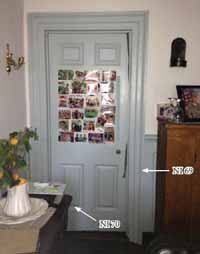 north wall, doorway to present kitchen
north wall, doorway to present kitchen
Sample NI 42: west wall, door architrave (north), backband cyma
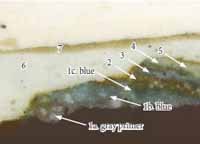 NI 42b, visible light, 200x (different section of sample) Lightened for greater legibility in PS
NI 42b, visible light, 200x (different section of sample) Lightened for greater legibility in PS
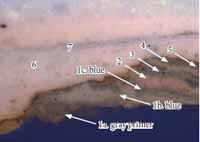 NI 42b, visible light, 200x (different section of sample) Lightened for greater legibility in PS
NI 42b, visible light, 200x (different section of sample) Lightened for greater legibility in PS
Sample NI 43: west wall, door leaf, bottom right panel, right bevel
14Sample NI 69: Door architrave to northeast room (current kitchen). Right (east) architrave, cyma of backband, 30" above floor
Sample NI 70: Door leaf to northeast room (current kitchen), bottom left panel, beveled underside
Sample NI 66: South wall, window architrave, right side, cyma, 10" up from bottom
Sample NI 44: west wall, wainscot stile immediately adjacent to right side of passage door
The samples from the wainscot on the south wall [not shown] began with the same fifth generation gray primer and blue paint.
Sample NI 45: west wall, chair rail, underside of cap
First-Floor Southeast Room [Room 107] — Binding Media Analysis
Sample NI 43: west wall, door leaf, bottom right panel, right bevel
TTC stain for carbohydrates (starches, gums, cellulosic fillers)
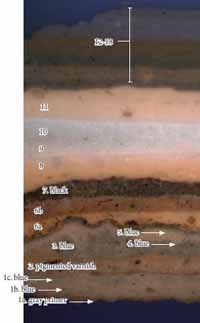 NI 43, UV light, 200x. Before TTC stain.
NI 43, UV light, 200x. Before TTC stain.
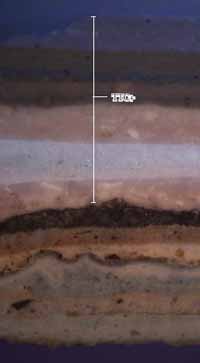 NI 46a, UV light, 200x. TTC reaction.
NI 46a, UV light, 200x. TTC reaction.
Sample NI 43 was stained with TTC to tag carbohydrates in the stratigraphy.
Strong positive reactions (dark, reddish-brown color), were observed in the modern paints (generations 6-18). No reactions were observed in the earliest paints.
FITC stain for proteins (animal glues, casein)
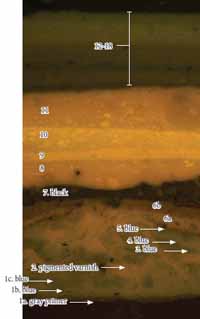 NI 43, B-2A filter, 200x. Before FITC stain.
NI 43, B-2A filter, 200x. Before FITC stain.
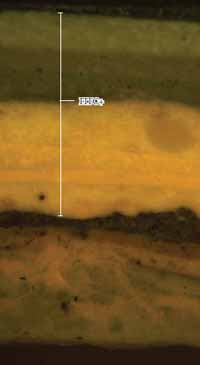 NI 46a, B-2A filter, 200x. FITC reaction.
NI 46a, B-2A filter, 200x. FITC reaction.
Sample NI 43 was stained with FITC to tag proteins in the stratigraphy.
Positive reactions (yellow-green fluorescence) were observed in the modern paints (generations 8-18). No reactions were observed in the earliest paints.
DCF for lipids (oils)
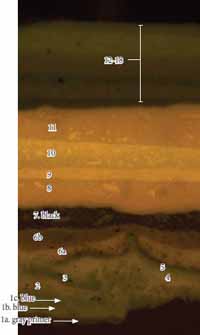 NI 43, B-2A filter, 200x. Before DCF stain.
NI 43, B-2A filter, 200x. Before DCF stain.
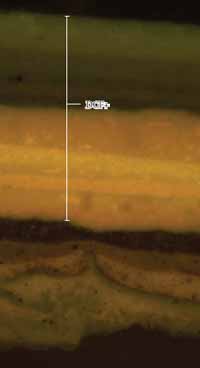 NI 46a, B-2A filter, 200x. DCF reaction.
NI 46a, B-2A filter, 200x. DCF reaction.
Sample NI 43 was stained with DCF to tag lipids (oils) in the stratigraphy.
Strong positive reactions (yellow-green fluorescence), were observed in the modern paints (generations
8-18). No reactions were observed in the earliest paints.
First-Floor Southeast Room [Room 107] - Pigment ID
Generation 1a: gray primer
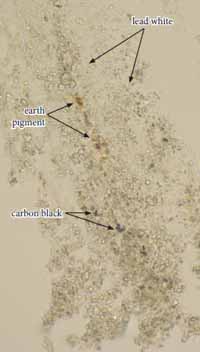 dispersed pigment sample from gray primer, sample NI 43 (door leaf), plane polarized light, 1000x
dispersed pigment sample from gray primer, sample NI 43 (door leaf), plane polarized light, 1000x
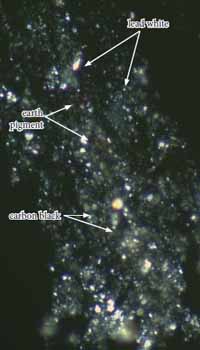 dispersed pigment sample from gray primer, sample NI 43 (door leaf), cross polarized light, 1000x
dispersed pigment sample from gray primer, sample NI 43 (door leaf), cross polarized light, 1000x
The first generation gray primer (generation 1a), is comprised of mostly lead white pigment (2PbCO3 ⋅ Pb(OH)2), visible as very small, rounded transparent particles with high relief and a bright birefringence in crossed polars.
Some carbon black particles were also seen, which were black and opaque in transmitted light, and dark under crossed polars. These particles were very fine and could be lampblack pigment.
A few agglomerations of golden-brown-colored particles were present, which are dark under crossed polars. These could be some type of earth pigment — possibly a yellow ochre, a sienna, or an umber. The exact type of pigment could not be determined.
Generation 1b,c: blue paint (two layers could not be isolated)
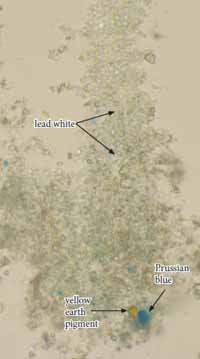 dispersed pigment sample from first generation blue paint, sample NI 43 (door leaf), plane polarized light, 1000x
dispersed pigment sample from first generation blue paint, sample NI 43 (door leaf), plane polarized light, 1000x
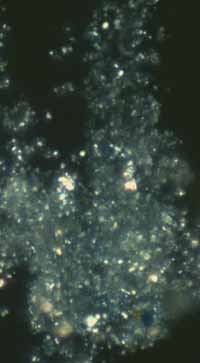 dispersed pigment sample from first generation blue paint, sample NI 43 (door leaf), cross polarized light, 1000x
dispersed pigment sample from first generation blue paint, sample NI 43 (door leaf), cross polarized light, 1000x
The pigment samples from the first generation blue paints (generations 1b and 1c could not be isolated) appear to contain primarily lead white pigments (2PbCO3 ⋅ Pb(OH)2), visible as small, rounded particles with high relief, that are colorless in transmitted plane polarized light and have a bright birefringence in cross polarized light.
Particles of Prussian blue (Fe4[Fe(CN)6]3), were also present, visible as bright blue particles in a range of shapes and sizes, always with low relief, soft edges, and a 'smeary' quality in some areas. This pigment is isotropic (dark) in crossed polars.
A few agglomerations of yellow and golden-brown-colored particles were also seen, which are dark under crossed polars. These appear to be an earth pigment — most likely a yellow ochre, in addition to a sienna or an umber. The exact type of earth pigment could not be determined.
Generation 2: pigmented varnish
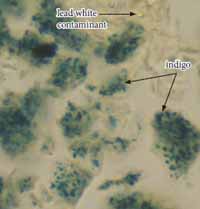 dispersed pigment sample from second generation pigmented glaze, sample NI 43 (door leaf), plane polarized light, 1000x
dispersed pigment sample from second generation pigmented glaze, sample NI 43 (door leaf), plane polarized light, 1000x
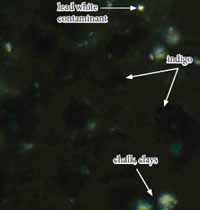 dispersed pigment sample from second generation pigmented glaze, sample NI 43 (door leaf), cross polarized light, 1000x
dispersed pigment sample from second generation pigmented glaze, sample NI 43 (door leaf), cross polarized light, 1000x
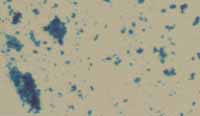 reference sample of indigo, plane polarized light, 1000x (note this is not embedded in resin as above)
reference sample of indigo, plane polarized light, 1000x (note this is not embedded in resin as above)
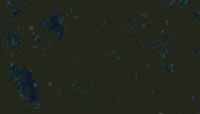 reference sample of indigo, cross polarized light, 1000x
reference sample of indigo, cross polarized light, 1000x
In cross-section, the second generation finish appears to be a pigmented glaze, consisting of large, dark particles suspended in a translucent, greenish-colored matrix. This matrix has a brighter autofluorescence in UV, suggestive of a resinous composition.
The dispersed pigment sample contains fine-grained particles of a dark blue color. Particle shape is rounded and size range is narrow with some larger agglomerations of particles. The pigment is isotropic. This matches the literature descriptions (Eastaugh 656), and reference samples of indigo (see bottom images).
Under crossed polars, a few colorless particles with bright birefringence were observed. These could be lead white pigments from surrounding paints, as well as chalk, clay, or another inert extender sometimes associated with indigo (ibid).
First-Floor Southeast Room [Room 107] — Colorimetry
Generation 1a: gray primer in southeast room and stair passage
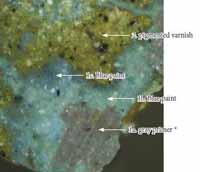 Sample NI 43 (door leaf), uncast, 100x
Sample NI 43 (door leaf), uncast, 100x
Accurate color readings for the first generation gray primer used in the southeast room and stair passage could not be obtained with the Minolta Chroma Meter because this layer was very thin and a clean, intact area could not be isolated for measurement. Instead, the closest commercial color match was determined by eye using a stereomicroscope at 30x magnification with a color corrected light source. The closest match for the gray primer was determined to be Benjamin Moore 2134-30 "Iron Mountain".
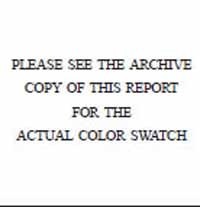 Benjamin Moore
Benjamin Moore
2134-30
"Iron Mountain"
| CIE L*a*b* values | L* (black to white) | a* (green to red) | b* (blue to yellow) |
|---|---|---|---|
| 36.27 | +0.10 | +1.09 | |
| Munsell values | hue | value | chroma |
| 2.3Y | 3.5 | 0.1 |
Generation 1b: blue paint (layer 1)
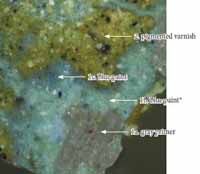 Sample NI 43 (door leaf), uncast, 100x
Sample NI 43 (door leaf), uncast, 100x
Accurate color readings for the second layer of the first generation blue finish (generation 1b), used in the southeast room could not be obtained with the Minolta Chroma Meter because this layer was very thin and a clean, intact area could not be isolated for measurement. Instead, the closest commercial color match was determined by eye using a stereomicroscope at 30x magnification with a color corrected light source. The closest match for the gray primer was determined to be Sherwin Williams SW 6222 "Riverway".
 Sherwin Williams
Sherwin Williams
SW 6222
"Riverway"
| CIE L*a*b* values | L* (black to white) | a* (green to red) | b* (blue to yellow) |
|---|---|---|---|
| 45.33 | -6.94 | -4.76 | |
| Munsell values | hue | value | chroma |
| 1.3B | 4.4 | 1.8 |
Generation 1c: blue paint (final layer)
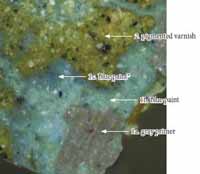 Sample NI 43 (door leaf), uncast, 100x
Sample NI 43 (door leaf), uncast, 100x
Accurate color readings for the final layer of the first generation blue finish (generation 1c), used in the southeast room could not be obtained with the Minolta Chroma Meter because this layer was very thin and a clean, intact area could not be isolated for measurement. Instead, the closest commercial color match was determined by eye using a stereomicroscope at 30x magnification with a color corrected light source. The closest match for the gray primer was determined to be Benjamin Moore HC-158 "Newburg Green".
 Benjamin Moore
Benjamin Moore
HC-158
"Newburg Green"
| CIE L*a*b* values | L* (black to white) | a* (green to red) | b* (blue to yellow) |
|---|---|---|---|
| 35.30 | -4.64 | -8.90 | |
| Munsell values | hue | value | chroma |
| 7.8B | 3.4 | 2.3 |
Generation 2: pigmented varnish
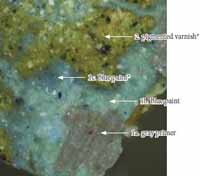 Sample NI 43 (door leaf), uncast, 100x
Sample NI 43 (door leaf), uncast, 100x
Accurate color readings for the second generation finish (pigmented varnish), used in the southeast room could not be obtained with the Minolta Chroma Meter because this layer was very thin and a clean, intact area could not be isolated for measurement. Instead, the closest commercial color match was determined by eye using a stereomicroscope at 30x magnification with a color corrected light source. The closest match was determined to be Benjamin Moore HC-134 "Tarrytown Green".
 Benjamin Moore
Benjamin Moore
HC-134
"Tarrytown Green"
| CIE L*a*b* values | L* (black to white) | a* (green to red) | b* (blue to yellow) |
|---|---|---|---|
| 34.72 | -8.49 | -0.64 | |
| Munsell values | hue | value | chroma |
| 3.1BG | 3.4 | 1.6 |
Generations 3 & 4: blue paints
The third and fourth generation blue paints were examined with low-power magnification and both appear to be the same color. Accurate color readings for these blue paints could not be obtained with the Minolta Chroma Meter because a clean, intact area could not be isolated for measurement. Instead, the closest commercial color match was determined by eye using a stereomicroscope at 30x magnification with a color corrected light source. The closest match was determined to be Sherwin Williams #0047 "Studio Blue Green".
 Sherwin Williams
Sherwin Williams
#0047
"Studio Blue Green"
| CIE L*a*b* values | L* (black to white) | a* (green to red) | b* (blue to yellow) |
|---|---|---|---|
| 51.81 | -9.61 | -0.58 | |
| Munsell values | hue | value | chroma |
| 3.6BG | 5.1 | 1.8 |
Generation 5b: blue paint (first finish on wainscot)
Accurate color readings for the fifth generation blue finish (generation 5b), used in the southeast room could not be obtained with the Minolta Chroma Meter because this layer was very thin and a clean, intact area could not be isolated for measurement. Instead, the closest commercial color match was determined by eye using a stereomicroscope at 30x magnification with a color corrected light source. The closest match was determined to be Benjamin Moore HC-150 "Yarmouth Blue".
 Benjamin Moore
Benjamin Moore
HC-150
"Yarmouth Blue"
| CIE L*a*b* values | L* (black to white) | a* (green to red) | b* (blue to yellow) |
|---|---|---|---|
| 77.64 | -4.98 | -3.48 | |
| Munsell values | hue | value | chroma |
| 3.7B | 7.7 | 1.3 |
First-Floor Northeast Room [Rooms 106 and 108]
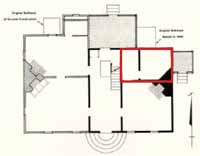 First floor plan, Robert Nicolson House
First floor plan, Robert Nicolson House
Northeast room is outlined in red
Discussion of Results: The early paint history of the woodwork in this room is very similar that of the adjacent southeast room, and suggests that during the Nicolson period (1751-1797), these rooms were painted in the same manner, and therefore chromatically linked. Since this room contains the same early paints as the southeast room, fluorochrome staining, color matching, and pigment ID were not carried out.
This room is the present kitchen, and as such as been much re-worked. There is not as much original woodwork here as in the other rooms, and no wainscot. Fewer samples were taken from this space, and the early paints in general were more disrupted. However, there was more than enough evidence to determine that some of the existing woodwork dates to Period 1 (c.1751).
Generation 1: Like the southeast room, the woodwork in this room was sealed with shellac, primed with a thin gray-colored primer (generation 1a), and painted with two layers of deep blue-green paint (generations 1b and 1c).
The presence of this paint helped identify first period elements. It was found on the south wall door leaf and architrave (see samples NI 72 and 71, pp. 36 and 38), the door architrave to the passage (NI 74, p. 37), and the chair rail on the south wall (NI 73, p. 39).
Generation 2: This paint was also found on all first period elements. It is the pigmented varnish (indigo) that was used in the adjacent southeast room.
Generation 3: Another blue paint. This is the final early blue paint layer, whereas the adjacent southeast room was painted blue up to five times. This suggests that the northeast room was not painted as often by comparison. The third generation blue paint is very grimy and exposed for a long period of time.
Generations 4 and 5: Compared to the adjacent southeast room, this room appears to have been unpainted during these periods.
Generation 6: This is the faux-wood graining scheme found throughout the first floor of the house.
Generation 7: Compared to the adjacent southeast room, this room appears not to have been repainted during this period.
34Generation 8: It appears that all of the woodwork in this room was painted a brick red color. This paint was found throughout the first floor of the house.
Generations 9-16: These are thick paints with smooth surfaces and finely ground pigment particles, suggestive of modern paints. The present color is red-brown.
| Paint Generation | Description | Notes |
|---|---|---|
| 9-16 | modern white, black, and red-brown paints | present color red-brown |
| 8 | brick red paint | also in stair passage |
| 7 | not repainted | — |
| 6 | faux wood graining (6a-6d), possibly oak, door leaves and wainscot caps. Cream-colored paint on rest of woodwork. | Same scheme in other first-floor rooms. |
| 5 | not repainted | blue in adjacent SE room |
| 4 | not repainted | blue in adjacent SE room |
| 3 | blue paint | also in adjacent SE room |
| 2 | blue or blue-green glossy layer, made with indigo suspended in resin | also in adjacent SE room |
| 1 c.1752 | gray primer (1a), coarsely ground blue paint (1b and 1c), grime | also in adjacent SE room |
First-Floor Northeast Room [Rooms 106 and 108] — Sample Location Photos
Sample NI 72: south wall, door leaf, lock rail, west edge
Sample NI 74: West wall, door architrave to passage, south side, fascia, 16" up from floor
Sample NI 71: south wall, door architrave, east side, fascia, 18" up from floor
First-Floor Stair Passage [Room 105]
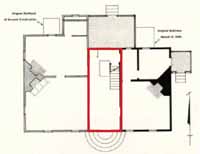 First floor plan, Robert Nicolson House
First floor plan, Robert Nicolson House
Stair passage is outlined in red
Discussion of Results: This study found that the stair passage woodwork retains excellent, intact paint evidence to confirm some of the known construction history of the space, in particular the first period finish in 1751 and the finish after the western expansion c.1764, as well as to clarify how this space changed after that period.
The first three finish generations (generations 1, 2, and 5), are dark brown paints of almost identical color, which, at high magnification, have very different appearances in visible and UV light. Characteristics such as pigment composition and autofluorescence were important factors in identifying each individual generation. The presence or absence of certain generations helped reconstruct the history of this room in three specific phases. Please refer to page 43 for the three best photomicrographs illustrating these phases.
Generation 1: This reflects the earliest form of the house, which dates to c. 1751 and consists of the stair passage and eastern rooms on the first and second floors. The paint analysis suggests that in this period, the woodwork in the passage was sealed with shellac (identified by its orange autofluorescence in the wood cells), and primed with a thin gray-colored primer (generation 1a), made with lead white, chalk, carbon black, and a few earth pigments. This is the same gray primer used in the adjacent eastern rooms. The woodwork was then painted with a dark brown paint (generation 1b), that was very coarsely ground, and contained large chunks of carbon black pigments, red lead pigments, and earth pigments ranging from deep red, brown, and yellow. These large pigment particles made this first generation dark brown paint easy to identify in all of the cross-section samples. This paint was coated with a very thin layer of autofluorescent material, probably a plant resin varnish (generation 1c), which would have created a glossy surface. This varnish was worn away in most samples and was not always present. The best example of this finish was found in sample NI 39, taken from the door leaf to the cellar stair (see p. 52).
The presence of this first generation finish helped identify the first period woodwork in the passage. This finish was found on the entire staircase (see samples NI 2, 9, 15, 18; pp. 52-55), and stair stringer (NI 3, p. 56). It was also found on the cellar door leaf and architrave (NI 39, 40; pp. 54-57), the north entrance door leaf and architrave (NI 80, 81; pp. 59-60), the south entrance door leaf and architrave (NI 79, 78; pp. 65-66), the door architrave leading to the northeast room (NI 75, p. 62), and the door leaf and architrave leading to the southeast room (NI 22, 20; pp. 63-64). It should be noted that the east jamb of the north (original, rear) door architrave might have been moved from one of the eastern rooms, since the paint history of that jamb more closely resembles the paints in those spaces (NI 83, p. 61).
41Most importantly, the first generation paint was NOT found on the two doorways leading to the west room, the wainscot, or the closet in the northwest corner, which confirms that these elements post-date the first period.
Generation 2: This reflects the second form of the house, when the western addition was constructed c.1764. During this period, the passage woodwork was re-painted with another dark brown paint (generation 2b). Although it is the same color as the previous generation, this paint is much more finely-ground, and has a very dim autofluorescence in UV light. This paint was so thin it could not be isolated for pigment identification.
This was the earliest finish on the door architraves and leaves on the west wall, having been painted over a shellac sealant, and a yellowish-tan priming layer (generation 2a), made with yellow ochre, white lead, and some carbon black pigments. On the rest of the woodwork, it was simply painted over the extant coarsely-ground dark brown paint. Like the previous generation, the paint was coated with a thin layer of resinous varnish (generation 2c), which was not found in all samples, suggesting it was worn away.
Therefore, the results confirm that the door architraves and leaves on the west wall date to Period 2, c.1764, when the western wing was constructed. This evidence was found on the doorway to the southwest room (see samples NI 76 and 27, pp. 67-68), and the doorway to the northwest room (see samples NI 30 and 31, pp. 69-70). In addition, this provided a benchmark date for the second generation dark brown paint, and determined that approximately thirteen years had passed before the stair passage was re-painted.
Generations 3, 4:
During this period the stair passage was not repainted. By comparison, the southeast room was re-painted twice. The finishes appear to align in the next generation (generation 5), when the wainscot panelling was installed in both spaces.
Generation 5: An exact date for this period is unknown, but it had to occur after 1764. During this period, all of the passage woodwork was again painted dark brown (generation 5b), this time with a paint containing approximately 1:1 carbon black and red iron earth pigments, all finely ground. This paint was also coated with a varnish (generation 5c), which in most samples was heavily worn, soiled, and disrupted, suggesting a long period of exposure. This was the earliest finish on all of the wainscot panelling, the closet in the northwest corner of the passage, and the baseboards. In fact, on these elements the fifth generation dark brown was painted over a gray primer (generation 5a).
Therefore, the results suggest that the wainscot, northwest closet, and baseboards were added in Period 3 (paint generation 5). This evidence was found on the wainscot below the stair stringer (see sample NI 7, p. 71), the wainscot along the stair (NI 11 and 16, pp. 72-73), and the wainscot on the west wall (NI 13 and 14, pp. 74-75). It was also found on the northwest closet paneling (NI 35, p. 76) the closet door leaf (NI 32, p. 77), and the baseboards throughout the room (NI 36, p. 78).
It would seem likely that the wainscot in the passage is contemporary with the wainscot in the first-floor southeast room, which was also first painted with a gray primer and a blue paint that was applied to the rest of the woodwork in the fifth generation. This would suggest that the southwest room was painted more frequently than the passage.
Paint generations one and two appear to have the same level of surface exposure and disruption. Knowing that generation one was exposed for thirteen years, it is possible that generation two was exposed for a 42 similar period of time. This is purely theoretical, but suggests that the fifth generation could date to c.1777. Interestingly, this is the year that Nicolson stopped taking in lodgers at his house (Samford, 1986), as it was no longer a financial necessity. Therefore, this upgrade could reflect Nicolson's desire to have the interior of his house to reflect his growing fortunes and rising social status.
After the fifth generation, the passage appears to have been unpainted for a long period of time. The varnish (generation 5c) is very soiled and disrupted, and deep cracks extend through the surface of the paint, and even into generations one and two. This could suggest that this finish was exposed to the end of Nicolson's residency (Nicolson passed away in 1797), and into the early 19th century, when the house passed from the Nicolson family to the Power family in 1803.
Binding media analysis was inconclusive regarding these early paints (pp. 21-23). However, visual analysis suggests they are traditional oil-bound paints (with the exception of generation 2, which appears to have a resinous binder).
Generation six: This finish was found throughout the house, most notably as the sixth paint generation in the first-floor southwest room. Therefore, it is delineated generation six in all rooms. This scheme consisted of faux-wood grained door leaves, stairs, and baseboards, possibly in imitation of a light-colored wood, such as oak, with the architraves and wainscot painted a cream color. The wainscot caps, stair handrails and newel posts appear to have been grain-painted to imitate a more orange-red-colored wood. This scheme is consistent with an early 19th-century date, and most likely reflects the period of the Power occupancy (1803 - c.1840).
Generation seven: This scheme consists of a finely ground, resinous grayish-colored paint on the staircase and wainscot. This paint has a bright bluish, twinkling autofluorescence characteristic of zinc white (ZnO), a pigment that was not commercially available in housepaints until c.1845. During this same period, the door leaves and architraves were painted dark brown with a resinous paint.
Generation eight: The scheme during this period is unclear. A thin layer of brick-red colored paint was found on a few elements (cellar door leaf and architrave, north entrance door leaf, closet leaf, door leaf to the northwest room), but in all other samples there was only a white paint.
Generations 9-11: These paints are all finely ground, smooth, and consistent white paints that appear to have been industrially prepared, and probably date to the late 19th or early 20th century.
Generations 12-15: These are yellow-ochre colored paints, the earliest of which probably dates to 1940, when Cogar restored the house. Cogar noted in his diary that rudimentary paint scrapes carried out by himself and his mother found that the first paint in the passage was yellow. It seems likely that these scrapes were carried out on one of the doorways on the west wall, where the wood was first painted with a yellow-tan primer (generation 2a).
Generations 16-18: These represent the present pale blue, or 'pearl' colored paints in the passage.
Comparison of Stair Passage samples showing three phases of construction
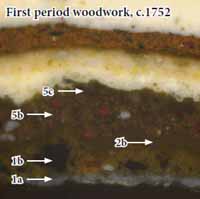 NI 39, visible light, 200x (cellar door leaf)
NI 39, visible light, 200x (cellar door leaf)
First period woodwork — cellar door leaf and architraves on the east side, and the stair.
Gray primer (1a), with coarsely ground dark brown paint (1b) and varnish (1c).
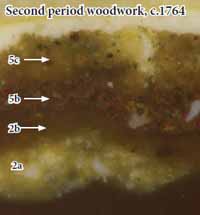 NI 30a, visible light, 200x (door architrave to NW room)
NI 30a, visible light, 200x (door architrave to NW room)
Second period woodwork — door leaves and architraves on the west side.
Yellow-tan primer (2a), with finely ground dark brown paint (2b) and varnish (2c).
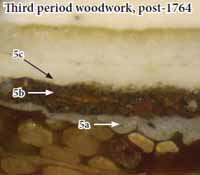 NI 13a, visible light, 200x (wainscot on west wall)
NI 13a, visible light, 200x (wainscot on west wall)
Third period woodwork — all wainscot panelling, including those below the stair stringer. Also closet and closet panelling in NW corner
Gray primer (5a), and finely ground dark brown paint (5b) and varnish (5c).
| Paint Generation | Description | Notes |
|---|---|---|
| 16-18 | pale blue paints, modern | current finish |
| 13-15 | deep yellow paint, modern | |
| 12 | deep yellow paint, modern | possibly Cogar-era (1940) |
| 9-11 | white paint, post-industrial | late 19th or early 20th c. |
| 8 | inconclusive, some samples have brick-red paint, but most have white paints | |
| 7 | gray paint on staircase and wainscot, dark brown resinous paint on door leaves and architraves | gray paint contains zinc white (ZnO), post c.1845 |
| 6 | faux wood graining (6a-6d), possibly oak, on staircase, door leaves, and wainscot caps. Cream-colored paint on rest of woodwork. | Same scheme in other first-floor rooms. |
| 5 c.1777(?) | gray primer (3a), finely ground dark brown paint made with red and black particles (3b), varnish (3c) | first generation on all wainscot panelling, closet in NW corner, and baseboards. Aligns with new woodwork in adjacent southeast room |
| 4 | — | not repainted |
| 3 | — | not repainted |
| 2 c.1764 | yellow-tan primer (2a), finely ground dark brown paint with dim autofluorescence (2b), varnish (2c) | first generation on door leaves and architraves on west wall |
| 1 c.1752 | gray primer (1a), coarsely ground dark brown paint (1b), varnish (1c) | found on staircase, all door leaves and architraves except for those on the west wall |
First-Floor Stair Passage [Room 105] — Sample Location Photos
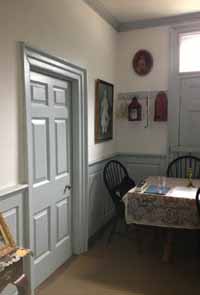 overall view, facing southeast
overall view, facing southeast
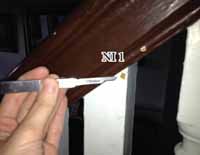 12th full baluster from first floor
12th full baluster from first floor
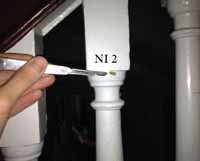 17th full baluster from first floor
17th full baluster from first floor
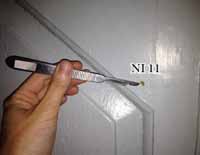 wainscot along east side of stair
wainscot along east side of stair
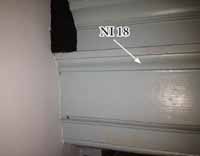 horizontal architrave in stairwell
horizontal architrave in stairwell
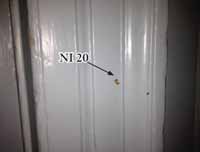 doorway to SE room, right architrave
doorway to SE room, right architrave
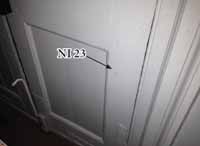 south entrance door (blocked by heavy furniture)
south entrance door (blocked by heavy furniture)
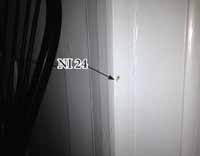 south entrance door (blocked by heavy furniture)
south entrance door (blocked by heavy furniture)
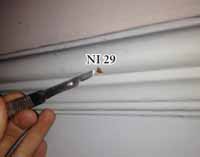 west wall, wainscot cap left of SW room
west wall, wainscot cap left of SW room
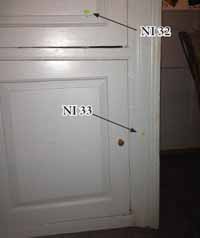 closet at NW corner of passage
closet at NW corner of passage
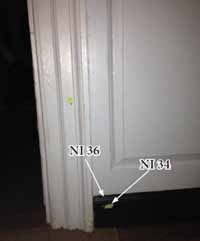 baseboard on west wall, right of NW room
baseboard on west wall, right of NW room
Sample NI 39: Door leaf to cellar stair, bottom ovolo of lock rail
This sample from the cellar door leaf has the most intact early stratigraphy from all samples taken from the stair passage. It clearly shows the first generation gray primer (1a) and dark brown paint (1b), which contains very large orange and black pigment particles. In this sample, a very thin varnish (1c) over the surface of the first generation is visible. The second generation brown paint is much more finely ground and has a very dim autofluorescence, which strongly differentiates it from generations one and two. The passage was unpainted in generations 3 and 4. This was determined through comparison of samples from the adjacent southeast room.
Generation five is a finely ground brown paint composed of red and black particles. There is a varnish layer (5b) over this paint that in most samples is soiled and disrupted, suggesting a long period of exposure. The next generation is a faux-wood graining finish, which was used throughout the house, usually on the door leaves and wainscot caps.
Sample NI 40: Door architrave to cellar stair, fillet of east architrave, inner edge
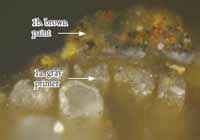 NI 40a (repolished), visible light, 400x
NI 40a (repolished), visible light, 400x
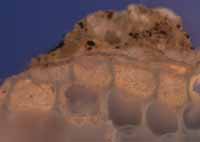 NI 40a (repolished), UV light, 400x
NI 40a (repolished), UV light, 400x
The door architrave to the cellar stair also contains the first three generations of dark brown paints (generations 1, 2, and 5), indicating that this element is first period.
Sample NI 9: stair handrail, west face, above 9th baluster, middle of thin astrigal
The samples from the stair handrails were more fragmented, but were found to contain all three early dark brown paints, indicating that these elements are first period. Sample NI 9 represents all handrail samples.
Sample NI 2: stair, 17th baluster from first floor, northeast edge of ovolo below upper square
The samples from the stair balusters were also fragmented, but contained all three early dark brown paints, indicating that these elements are first period. Sample NI 2 represents all baluster samples.
Sample NI 15: stair, second newel post, top of first stair run, east face
The sample from the newel contained all three early dark brown paints, indicating that this element is first period. Sample NI 15 represents all newel samples.
Sample NI 18: horizontal north-facing architrave finishing the south edge of the stairwell adjacent to east plaster wall (transverse partition)
The sample from the stair architrave contained all three early dark brown paints, indicating that this element is first period.
Interestingly, this element is adjacent to the wall, and the sample does appear to contain what could be wall-related finishes, between generations 1 and 2, and between generations 2 and 5. The sample was stained with fluorochromes to characterize these materials (see p. 82), but the results were inconclusive.
Sample NI 3: outer stair stringer below 11th and 12th balusters, top of cove
The samples from the stair stringers are fragmented, but contained all three early dark brown paints, indicating that this elements are first period. Sample NI 3 represents all stringer samples.
Sample NI 80: north door leaf, second rail from top, bottom ovolo
The samples from the north entrance door leaf contained all three early dark brown paints, indicating that this element is first period. Sample NI 80 represents all north wall door leaf samples.
Sample NI 81: north door architrave, left (west) side), inner bead
Like its corresponding leaf (previous page), the north entrance door architrave also contained all three early dark brown paints, indicating that this element is first period. However, the right (east) jamb of this architrave appears to have been re-used from another room. See next page.
Sample NI 83: north door architrave, right (east) side, backband fillet
Interestingly, the right (east) jamb of the north entrance door architrave appears to have been re-used from another room, possibly the first-floor northeast room (present kitchen), where the woodwork contains the same paint history of early blues.
Sample NI 75: door architrave to northeast room (kitchen), north side, center fascia
The sample from the door architrave to the northeast room (present kitchen) contained all three early dark brown paints, indicating that this element is first period.
Sample NI 22: door leaf to southeast room, beveled edge of lower left raised panel
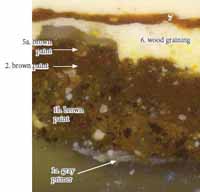 NI 22a, visible light, 400x (lightened in PS)
NI 22a, visible light, 400x (lightened in PS)
The sample from the door leaf to the southeast room contained all three early dark brown paints, indicating that this element is first period.
Sample NI 20: door architrave to southeast room, center fascia
Although fragmented, the sample from the door architrave to the southeast room contained the first generation gray primer and dark brown paint, indicating that this element is first period. Generation two is missing from this sample, but generation three is present.
Sample NI 78: south (front) door architrave, east side, backband fillet
The sample from the door architrave to the south entrance contained the first three generations of dark brown paint, indicating that this element is first period.
Sample NI 79: south (front) door leaf, east leaf, top rail, bottom ovolo
The sample from the south entrance door leaf contained the first three generations of dark brown paint, indicating that this element is first period.
Sample NI 76: door architrave to southwest room, cyma of top architrave
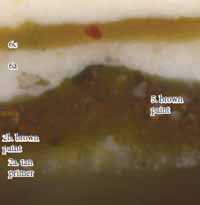 NI 76, visible light, 400x (early layers only)
NI 76, visible light, 400x (early layers only)
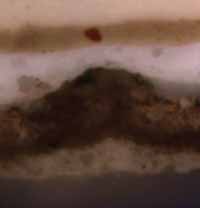 NI 76, UV light, 400x (early layers only)
NI 76, UV light, 400x (early layers only)
As expected, the sample from the door architrave to the SW room is missing the first generation gray primer and dark brown paint, confirming that this woodwork is later. The earliest finish is a yellowish-tan primer (2a), followed by the second generation finely ground dark brown paint (2b) that has a dark autofluorescence in reflected UV light.
This evidence confirms this architrave was installed in Period 2 (c.1764).
Sample NI 27: door leaf to southwest room, bottom ovolo of bottom right panel
The sample from the door leaf to the SW room is disrupted, but a fragment of the second generation dark brown paint is attached to the bottom of the sample. This would indicate that this leaf is also second period, like its corresponding architrave (see previous page).
Sample NI 31: door leaf to northwest room, bottom right panel, right beveled edge
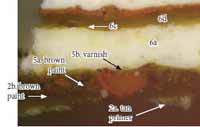 NI 31a (repolished), visible light, 400x (lightened in PS)
NI 31a (repolished), visible light, 400x (lightened in PS)
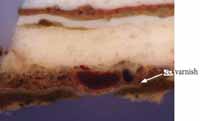 NI 31a (repolished), UV light, 400x (lightened in PS)
NI 31a (repolished), UV light, 400x (lightened in PS)
The sample from the door leaf to the NW room begins with the second generation yellow-tan primer (2a), followed by the finely ground dark brown paint (2b), and varnish (2c).
This evidence confirms this architrave was installed in Period 2 (c.1764).
Sample NI 30: door architrave to northwest room, right architrave, middle fascia
Like its corresponding door leaf (previous page), the sample from the door architrave to the NW room begins with the second generation yellow-tan primer (2a), followed by the finely ground dark brown paint (2b), and varnish (2c).
This evidence confirms this architrave was installed in Period 2 (c.1764).
Sample NI 7: paneling below stair stringer, rail
All of the samples from the wainscot panelling below the stair stringer had the same stratigraphy. Sample NI 7, shown above, represents the group. Generations one and two are missing, and the earliest paint is a gray primer (5a) and the fifth generation dark brown paint (3b), which contains finely ground red and black pigment particles (remember the passage was unpainted in generations 3 and 4).
The absence of generations one and two suggest that this panelling is later, post-dating even the west addition, c.1764.
Sample NI 11: upper rail of wainscot rising along east side of stair
The wainscot on the east side of the stair has the same stratigraphy as the rest of the wainscot panelling in this space. Generations one and two are missing, and the earliest paint is a gray primer (5a) and the fifth generation dark brown paint (5b), which contains finely ground red and black pigment particles.
The absence of generations one and two suggest that this panelling is later, post-dating even the west addition, c.1764.
Sample NI 16: wainscot at stair landing, ovolo of stile east of middle panel
The wainscot on the stair landing has the same stratigraphy as the rest of the wainscot panelling in this space. Generations one and two are missing, and the earliest paint is a gray primer (5a) and the fifth generation dark brown paint (5b), which contains finely ground red and black pigment particles.
The absence of generations one and two suggest that this panelling is later, post-dating even the west addition, c.1764.
Sample NI 13: west wall, wainscot stile to right of door to southwest room
The wainscot on the west wall has the same stratigraphy as the rest of the wainscot panelling in this space. Generations one and two are missing, and the earliest paint is a gray primer (5a) and the fifth generation dark brown paint (5b), which contains finely ground red and black pigment particles.
The absence of generations one and two suggest that this panelling is later, post-dating even the west addition, c.1764.
Sample NI 14: west wall, cap of wainscot to right of door to southwest room (above NI 13)
Sample NI 14 is shown here to illustrate that in generation six, when the panelling and architraves were painted a cream color, and the door leaves and stair balusters were painted to imitate a light-colored wood (possibly oak), the cap of the wainscot (as well as the stair handrails) were painted to imitate a more orange-red colored wood.
Sample NI 35: paneling on east side of closet at northwest end of passage, ovolo of stile
The closet in the northwest corner has the same stratigraphy as the rest of the wainscot panelling in this space. Generations one and two are missing, and the earliest paint is a gray primer (5a) and the fifth generation dark brown paint (5b), which contains finely ground red and black pigment particles. The absence of generations one and two suggest that this panelling is later, post-dating even the west addition, c.1764.
Sample NI 32: upper door of closet at northwest end of passage, lower bevel of bottom panel
The closet doors have the same stratigraphy as the rest of the wainscot panelling, post-dating even the west addition, c.1764.
Sample NI 36: baseboard on west wall, cyma cap, adjacent to door to northwest room
Multiple samples were taken from the baseboards in the stair passage, and all appeared to begin with the fifth generation gray primer (5a) and dark brown paint (5b), which suggests they are contemporary with the wainscot panelling. Sample NI 36, taken from the west wall, is representative for the group.
According to this sample, the baseboards were also faux-wood grained in generation six, along with the door leaves and the staircase. In generation seven, the baseboards were painted with a resinous gray paint. In generations 8-11, the baseboards were painted white along with the rest of the woodwork.
Sample NI 39: Door leaf to cellar stair, bottom ovolo of lock rail
TTC stain for carbohydrates (starches, gums, cellulosic fillers)
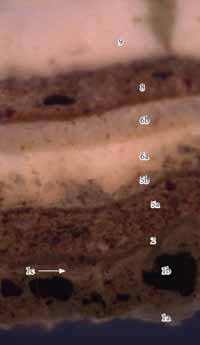 NI 39, UV light, 400x. Before TTC stain.
NI 39, UV light, 400x. Before TTC stain.
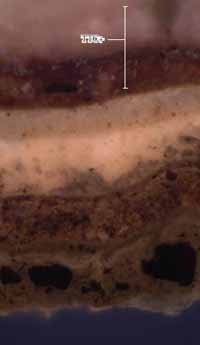 NI 39, UV light, 400x. TTC reaction.
NI 39, UV light, 400x. TTC reaction.
Sample NI 39 was stained with TTC to tag carbohydrates in the stratigraphy.
Positive reactions (a dark red-brown color) were observed in generations eight and nine (modern paints not photographed).
No reactions were observed in the earliest generations.
Sample NI 18: Horizontal, north-facing architrave finishing the south edge of the stairwell
FITC stain for proteins (animal glue, casein)
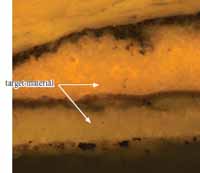 NI 18, B-2A filter, 200x. Before FITC stain.
NI 18, B-2A filter, 200x. Before FITC stain.
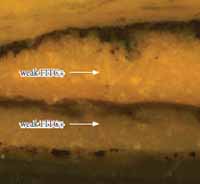 NI 18, B-2A filter, 200x. TTC reaction.
NI 18, B-2A filter, 200x. TTC reaction.
Sample NI 18 was stained to characterize the autofluorescent materials between the paint layers. There was no reaction with TTC. There was a very weak reaction for proteins with FITC, but it was not strong enough to be conclusive. The material did not appear to be oil-based, so it was not stained with DCF. The nature of these materials is still unclear.
Pigment ID: first generation gray primer
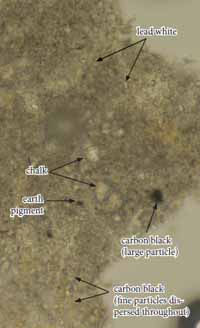 NI 39, dispersed pigments from first generation gray primer, plane polarized light, 1000x
NI 39, dispersed pigments from first generation gray primer, plane polarized light, 1000x
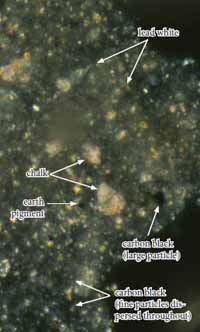 NI 39, dispersed pigments from first generation gray primer, cross polarized light, 1000x
NI 39, dispersed pigments from first generation gray primer, cross polarized light, 1000x
The first generation gray primer (generation 1a), is comprised of mostly lead white pigment (2PbCO3 ⋅ Pb(OH)2), visible as very small, rounded transparent particles with high relief and a bright birefringence in crossed polars. A good amount of chalk (CaCO3) was also present, a commonly used inert extender in housepaints. The chalk particles are large, flat plate-shaped particles with an undulose birefringence.
Some carbon black particles were also seen, which were black and opaque in transmitted light, and dark under crossed polars. Most particles were very fine and well dispersed throughout the medium, although occasional large carbon black particles were also found.
A few agglomerations of golden-brown-colored particles were present, which are dark under crossed polars. These could be some type of earth pigment — possibly a yellow ochre, a sienna, or an umber. The exact type of pigment could not be determined.
Pigment ID: first generation dark brown paint
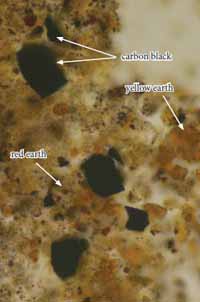 NI 39, dispersed pigments from first generation brown paint, plane polarized light, 1000x
NI 39, dispersed pigments from first generation brown paint, plane polarized light, 1000x
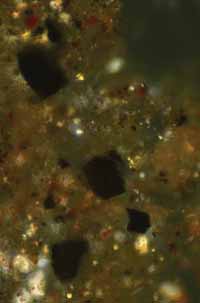 NI 39, UV light, 400x, dispersed pigments from first generation brown paint, cross polarized light, 1000x
NI 39, UV light, 400x, dispersed pigments from first generation brown paint, cross polarized light, 1000x
In cross-section, the first generation dark brown paint is very coarsely ground and contains large black, yellow, and red-colored pigment particles, which are much more apparent in the dispersed sample (photomicrographs from this paint continue on the next page). PLM suggests that this paint contains approximately 1/3 carbon black, 1/3 yellow and red earth pigments, and 1/3 red lead pigments. Some lead white pigments were also visible.
The carbon black pigments are the most apparent in this sample, visible in a range of particle sizes from very fine to very large. All are flat and opaque with sharp edges, suggestive of a coarsely ground charcoal black.
Yellow, red, and brown (sienna, umber) earth pigments are visible as clumps of golden-yellow, red, an brown particles of varying shape and size, from small grains to large agglomerations with amorphous boundaries. These pigment are isotropic in crossed-polars, although some golden and deep red birefringence was observed where particles were clumped together (an occasional "ruby-red" color in transmitted light is recorded for iron oxide red in Gettens and Stout, 122).
Pigment ID: first generation dark brown paint
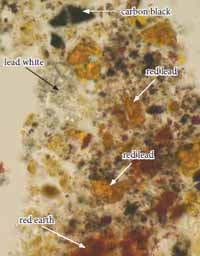 NI 39, dispersed pigments from first generation brown paint, plane polarized light, 1000x
NI 39, dispersed pigments from first generation brown paint, plane polarized light, 1000x
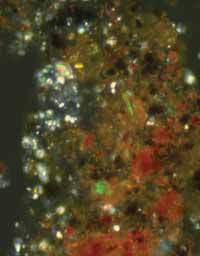 NI 39, UV light, 400x, dispersed pigments from first generation brown paint, cross polarized light, 1000x
NI 39, UV light, 400x, dispersed pigments from first generation brown paint, cross polarized light, 1000x
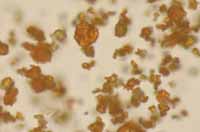 Red Lead reference, plane polarized light, 1000x
Red Lead reference, plane polarized light, 1000x
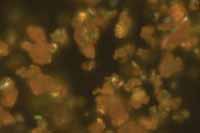 Red Lead reference, cross polarized light, 1000x (note blue-green interference colors)
Red Lead reference, cross polarized light, 1000x (note blue-green interference colors)
The sample also contained a large amount of red lead particles (Pb3O4), visible as coarse orange-colored particles with high relief that display bright blue-green interference colors under crossed polars, which is diagnostic for red lead pigment (see comparison to reference sample below).
Some lead white particles were also found in the sample, but could originate from the gray primer below. Other colorless particles that were present in the sample could represent mineral inclusions associated with earth pigments, such as calcite, quartz, or clays.
Pigment ID: second generation yellow-tan primer on west wall doors and architraves
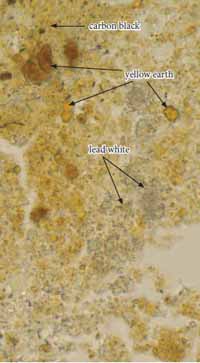 NI 31, dispersed pigments from second generation yellow-tan primer, plane polarized light, 1000x
NI 31, dispersed pigments from second generation yellow-tan primer, plane polarized light, 1000x
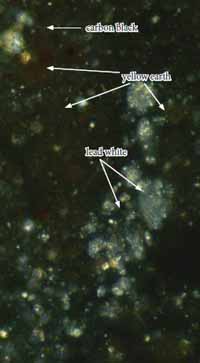 NI 39, UV light, 400x, dispersed pigments from second generation yellow-tan primer, cross polarized light, 1000x
NI 39, UV light, 400x, dispersed pigments from second generation yellow-tan primer, cross polarized light, 1000x
The second generation yellow-tan primer (generation 2a), is comprised of approximately 1:1 lead white pigment (2PbCO3 ⋅ Pb(OH)2), and yellow earth pigment. The lead white pigments are very small, rounded transparent particles with high relief and a bright birefringence in crossed polars. The yellow earth pigments are golden-yellow to brownish-yellow rounded particles of varying size that are dark under crossed-polars.
Some very fine carbon black particles were also seen, which were black and opaque in transmitted light, and dark under crossed polars. Most particles were very fine and well dispersed throughout the medium, although occasionally, larger carbon black particles were also found.
Pigment ID: fifth generation dark brown paint
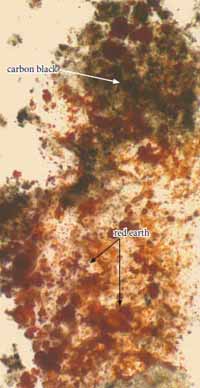 NI 39, dispersed pigments from third generation brown paint, plane polarized light, 1000x
NI 39, dispersed pigments from third generation brown paint, plane polarized light, 1000x
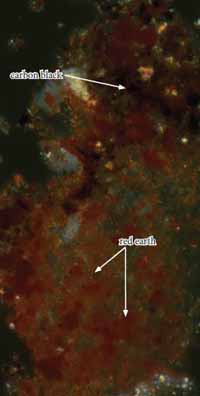 NI 39, UV light, 400x, dispersed pigments from third generation brown paint, cross polarized light, 1000x
NI 39, UV light, 400x, dispersed pigments from third generation brown paint, cross polarized light, 1000x
The fifth generation dark brown paint is composed of approximately ½ carbon black and ½ red earth pigments, which are more finely ground than the pigments in generation 1.
Carbon black is visible as opaque black particles that have sharp edges and are isotropic in crossed polars.
Red earth pigment particles are visible as rounded red to orange-red particles (and agglomerations of particles), with broad particle size distribution. The particles are isotropic but some have a deep red color in crossed polars.
First-Floor Stair Passage [Room 105] - Colorimetry
Generation 1a: gray primer in stair passage and first-floor southeast room
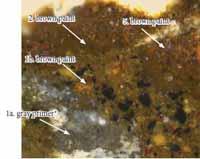 Sample NI 39 (stair passage, door leaf to cellar), uncast, 200x
Sample NI 39 (stair passage, door leaf to cellar), uncast, 200x
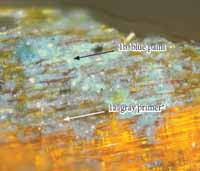 Sample NI 43 (first-floor southeast room, door leaf), uncast, 200x
Sample NI 43 (first-floor southeast room, door leaf), uncast, 200x
Accurate color readings for the first generation gray primer used in the stair passage and the southeast room could not be obtained with the Minolta Chroma Meter because this layer was very thin and a clean, intact area could not be isolated for measurement. Instead, the closest commercial color match was determined by eye using a stereomicroscope at 30x magnification with a color corrected light source. The closest match for the gray primer was determined to be Benjamin Moore 2134-30 "Iron Mountain".
 Benjamin Moore
Benjamin Moore
2134-30
"Iron Mountain"
| CIE L*a*b* values | L* (black to white) | a* (green to red) | b* (blue to yellow) |
|---|---|---|---|
| 36.27 | +0.10 | +1.09 | |
| Munsell values | hue | value | chroma |
| 2.3Y | 3.5 | 0.1 |
Generations 1, 2, and 5 in stair passage: dark brown paint
 Sample NI 39 (door leaf to cellar), uncast, 200x
Sample NI 39 (door leaf to cellar), uncast, 200x
Generations 1, 2, and 5 in the stair passage are all dark brown paints of an extremely similar color, although they have very different textures and consistencies which helped identify them in cross-section. Accurate color readings for these paints could not be obtained with the Minolta Chroma Meter because a clean, intact area could not be isolated for measurement. Instead, the closest commercial color match was determined by eye using a stereomicroscope at 30x magnification with a color corrected light source. The closest match was determined to be Benjamin Moore/Colonial Williamsburg Color CW-170 "Tarpley Brown".
This swatch was the closest color match to all three dark brown paint generations in the stair passage.
 Colonial Williamsburg
Colonial Williamsburg
#170
"Tarpley Brown"
| CIE L*a*b* values | L* (black to white) | a* (green to red) | b* (blue to yellow) |
|---|---|---|---|
| 26.49 | +5.14 | +6.91 | |
| Munsell values | hue | value | chroma |
| 4.3YR | 2.5 | 1.4 |
Generation 2 yellow-tan primer on west wall doors and architraves (c.1764); also used as finish coat in second-floor western spaces
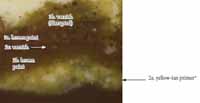 NI 30a, visible light, 200x (door architrave to NW room)
NI 30a, visible light, 200x (door architrave to NW room)
Accurate color readings for the yellow-tan primer/finish coat could not be obtained with the Minolta Chroma Meter because it was very fragmented and a clean, intact area could not be isolated for measurement. Instead, the closest commercial color match was determined by eye using a stereomicroscope at 30x magnification with a color corrected light source. The closest match was determined to be Benjamin Moore HC-17 "Summerdale Gold".
 Benjamin Moore
Benjamin Moore
HC-17
"Summerdale Gold"
| CIE L*a*b* values | L* (black to white) | a* (green to red) | b* (blue to yellow) |
|---|---|---|---|
| 68.92 | -1.03 | +32.08 | |
| Munsell values | hue | value | chroma |
| 4.0Y | 6.8 | 4.6 |
First-Floor Southwest Room [Room 102]
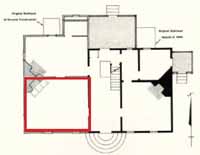 First floor plan, Robert Nicolson House Southwest room is outlined in red
First floor plan, Robert Nicolson House Southwest room is outlined in red
Discussion of results: This study found that the woodwork in the first-floor southwest room retains excellent, intact paint evidence that elucidates the decorative and structural history of this room. Since this west wing of the house was constructed c.1764, the earliest paint is this room is labelled generation 2.
Interestingly, in contrast to the stair passage and the first-floor southeast room, the paint analysis results suggest that the wainscot in this room (and the adjacent northwest room) was not added later, but is contemporary with the rest of the second-period woodwork.
Generation 2: This generation consists of a shellac sealant (identified by its orange autofluorescence) followed by a coarsely ground gray primer that contains lead white, carbon black, and a few scattered, large red earth pigment particles. This was finished with a coarsely ground yellow-green paint that contains white lead, yellow earth pigments, and small amounts of Prussian blue and carbon black. In a few samples (NI 48, p. 98 and NI 51, p. 96) there was a thin layer of grime on the surface of this paint, suggesting it was exposed for a relatively long period of time.
This finish was found on all woodwork in the room, including the mantel (NI 52 and 53, pp. 94-95), the door architrave and leaf to the passage (NI 50, p. 97), and the wainscot panels (NI 48 and 55, p. 98). Therefore, the wainscot in this room is contemporary with the rest of the woodwork and would date to c.1764, unlike the passage and east rooms, where it was added c.1777.
Generation 3: This generation consists of a coarsely ground blue-green paint made with lead white, yellow earth, and large particles of Prussian blue pigment. There is a thin, brownish layer on the surface of this paint that could be grime or an oil-based varnish (based on its dim autofluorescence in UV).
Generations 4-5: During these periods, the mantel was painted black and varnished. The rest of the woodwork appears to have been unpainted.
Binding media analysis determined there were no proteins or carbohydrates in these early paints. There was a very weak positive reaction for oils (DCF+), confirming the visual analysis that these are traditional oilbound finishes (p. 99-101).
Generation 6: This generation is the same scheme of cream-colored woodwork and faux-grained doors
92Generation eight: The scheme during this period is unclear. A thin layer of brick-red colored paint was found on the mantel, but in all other samples there was only a white paint.
Generations 9-12: These paints are all finely ground, smooth, and consistent white paints that appear to have been industrially prepared, and probably date to the late 19th or early 20th century.
Generations 13-17: These are modern paints, including the present pale blue color. Generation 13 is the first of three green-colored paints, which probably dates to 1940, when Cogar restored the house. Cogar noted in his diary that rudimentary paint scrapes carried out by himself and his mother found that the first paint in this room was green (Wenger 1986, 28).
| Paint Generation | Description | Notes |
|---|---|---|
| 17 | pale blue paint, modern | current finish |
| 16 | deep yellow paint, modern | |
| 13-15 | green paints, modern | possibly Cogar-era (1940) |
| 9-12 | white paint, post-industrial | late 19th or early 20th c. |
| 8 | inconclusive, some samples have brick-red paint, but most have white paints | |
| 7 | gray paint on mantel and wainscot, dark brown resinous paint on door leaves and architraves | gray paint contains zinc white (ZnO), post c.1845 |
| 6 | faux wood graining (6a-6d), possibly oak, on door leaves, rest of woodwork painted cream. Mantel painted black and varnished. | |
| Same scheme in other first-floor rooms. | ||
| 5 | mantel painted black (5a) and varnished (5b) | |
| 4 | mantel painted black (4a) and varnished (4b) | |
| 3 post-1764 | blue-green paint (3a), grime or oil-based varnish (3b) | |
| 2 c.1764 | gray primer (2a), yellow-green paint (2b) | found on all woodwork, including wainscot |
| 1 c.1752 | not yet constructed |
First-Floor Southwest Room [Room 102] - Sample Location Photos
Sample NI 52: Mantel, cushion of crown molding above dentil course, far left end
Sample NI 53: Mantel, backboard, far left end, near top
Sample NI 51: door architrave on east wall, right (south) architrave, backband cyma
The other sample from the inner fascia of this same architrave (NI 47), has the same early paints as the sample above. Therefore, the entire architrave is of the same period.
Sample NI 50: door leaf to passage (east wall), center left panel, ovolo on underside
Sample 50b (above) is shown to illustrate the complete stratigraphy for the room.
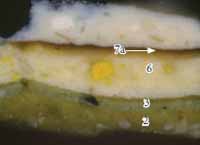 NI 49a, visible light, 400x (taken from same door, but raised panel)
NI 49a, visible light, 400x (taken from same door, but raised panel)
 NI 49a, UV light, 400x (taken from same door, but raised panel)
NI 49a, UV light, 400x (taken from same door, but raised panel)
Sample NI 55: wainscot stile, north wall, immediately adjacent to mantel
Sample NI 52: Mantel, cushion of crown molding above dentil course, far left end
TTC stain for carbohydrates (starches, gums, cellulosic fillers)
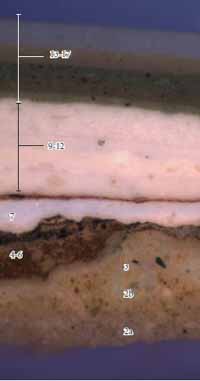 NI 52, UV light, 200x. Before TTC stain.
NI 52, UV light, 200x. Before TTC stain.
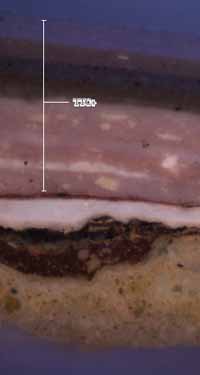 NI 52, UV light, 200x. TTC reaction.
NI 52, UV light, 200x. TTC reaction.
Sample NI 52 was stained with TTC to tag carbohydrates in the stratigraphy.
Positive reactions (a dark red-brown color) were observed in generations 9-17, which probably result from cellulosic fillers in modern paints.
No reactions were observed in the earliest generations.
FITC stain for proteins (animal glues, casein)
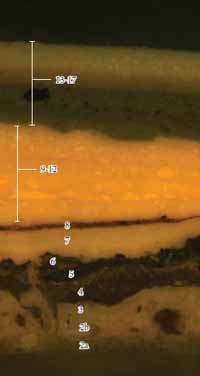 NI 52, B-2A filter, 200x. Before FITC stain.
NI 52, B-2A filter, 200x. Before FITC stain.
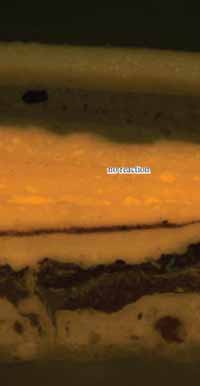 NI 52, B-2A filter, 200x. FITC reaction.
NI 52, B-2A filter, 200x. FITC reaction.
Sample NI 52 was repolished and stained with FITC to tag proteins in the stratigraphy.
No positive reactions (a yellow-green fluorescence) were observed.
DCF for lipids (oils)
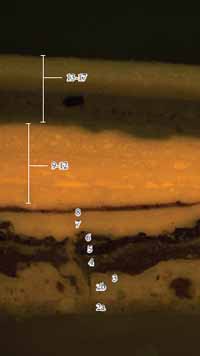 NI 52, B-2A filter, 200x. Before DCF stain.
NI 52, B-2A filter, 200x. Before DCF stain.
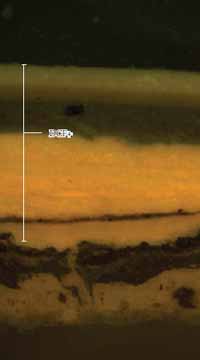 NI 52, B-2A filter, 200x. DCF reaction.
NI 52, B-2A filter, 200x. DCF reaction.
Sample NI 52 was repolished and stained with DCF to tag oils in the stratigraphy.
Positive reactions (a yellow-green fluorescence) were observed in the modern paints (generations 7-17). There was a very weak reaction in the earliest paints, which may not be visible in the printed image.
Pigment ID: second generation gray paint
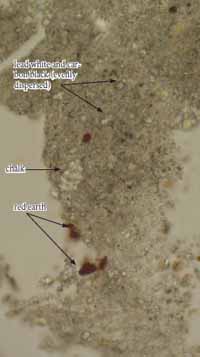 dispersed pigment sample from second generation gray paint, sample NI 52 (mantel), plane polarized light, 1000x
dispersed pigment sample from second generation gray paint, sample NI 52 (mantel), plane polarized light, 1000x
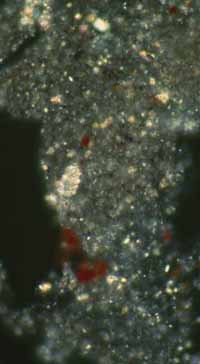 dispersed pigment sample from second generation gray paint, sample NI 52 (mantel), cross polarized light, 1000x
dispersed pigment sample from second generation gray paint, sample NI 52 (mantel), cross polarized light, 1000x
The second generation gray primer in the first floor southwest room is comprised of mostly lead white pigment (2PbCO3 ⋅ Pb(OH)2), visible as very small, rounded transparent particles with a bright birefringence in crossed polars. Dispersed throughout the lead white are fine particles of carbon black pigments, which are black and opaque in transmitted light, and dark under crossed polars.
Some red earth pigments were also identified, having a deep red color, rounded edges and existing in a range of sizes. These particles are isotropic but have a reddish color in cross-polarized light. Some smaller particles of yellow earth were also seen, having a yellow color in transmitted light and isotropic under crossed polars.
This paint also contains some chalk, visible as larger, flat, plate-shaped colorless particles with an undulose birefringence.
Pigment ID: second generation yellow-green paint
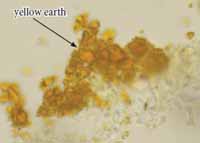 dispersed pigment sample from second generation yellow-green paint, sample NI 52 (mantel), plane polarized light, 1000x
dispersed pigment sample from second generation yellow-green paint, sample NI 52 (mantel), plane polarized light, 1000x
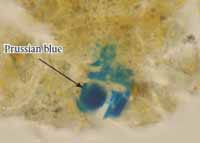 dispersed pigment sample from second generation yellow-green paint, sample NI 52 (mantel), cross polarized light, 1000x
dispersed pigment sample from second generation yellow-green paint, sample NI 52 (mantel), cross polarized light, 1000x
The second generation yellow-green paint in the southwest room contains lead white pigment and what appears to be yellow earth pigment in a ratio of approximately 1:1. The lead white particles are visible as very small, rounded transparent particles with a bright birefringence in crossed polars. Yellow earth pigments are visible as larger clumps of golden-yellow particles of varying shape and size, from small grains to large agglomerations with amorphous boundaries. These pigment are isotropic in crossed-polars.
A small amount of Prussian blue pigment particles were also seen, having a deep blue color in transmitted light with alternating hard boundaries or a 'smeary' quality, that are isotropic in crossed polars. An equally small amount of carbon black was also identified, being opaque and black in transmitted light, and isotropic in crossed polars.
Pigment ID: third generation light blue paint
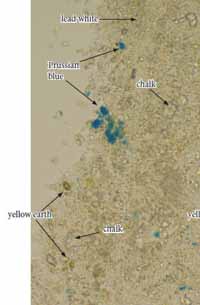 dispersed pigment sample from third generation light blue paint, sample NI 52 (mantel), plane polarized light, 1000x
dispersed pigment sample from third generation light blue paint, sample NI 52 (mantel), plane polarized light, 1000x
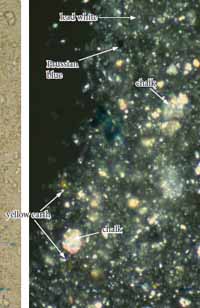 dispersed pigment sample from third generation light blue paint, sample NI 52 (mantel), cross polarized light, 1000x
dispersed pigment sample from third generation light blue paint, sample NI 52 (mantel), cross polarized light, 1000x
The third generation blue paint in the first floor southwest room is comprised of mostly lead white pigment (2PbCO3 ⋅ Pb(OH)2), visible as very small, rounded transparent particles with a bright birefringence in crossed polars. Dispersed throughout the lead white are particles of Prussian blue, which are deep blue in transmitted light, and dark under crossed polars.
A few small particles of yellow earth were also seen, that have a yellow color in transmitted light, and are isotropic under crossed polars.
This paint also contains some chalk, visible as larger, flat, plate-shaped colorless particles with an undulose birefringence.
First-Floor Southwest Room [Room 102] - Colorimetry
Generation 2a: gray primer
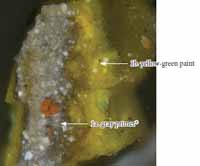 Sample NI 53 (mantel), uncast, 200x
Sample NI 53 (mantel), uncast, 200x
Accurate color readings for the first generation gray primer in the southwest room could not be obtained with the Minolta Chroma Meter, possibly because the exposed area was soiled and/or uneven. Instead, the closest commercial color match was determined by eye using a stereomicroscope at 30x magnification with a color corrected light source. The closest match for the gray primer was determined to be Benjamin Moore 2112-30 "Stone Brown".
 Benjamin Moore
Benjamin Moore
2112-30
"Stone Brown"
| CIE L*a*b* values | L* (black to white) | a* (green to red) | b* (blue to yellow) |
|---|---|---|---|
| 36.93 | +2.75 | +4.51 | |
| Munsell values | hue | value | chroma |
| 5.4YR | 3.6 | 0.8 |
Generation 2b: yellow-green paint
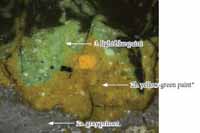 Sample NI 52 (mantel), uncast, 200x
Sample NI 52 (mantel), uncast, 200x
Accurate color readings for the second generation yellow-green paint in the southwest room could not be obtained with the Minolta Chroma Meter because a clean, smooth area could not be isolated for measurement. Instead, the closest commercial color match was determined by eye using a stereomicroscope at 30x magnification with a color corrected light source. The closest match for this paint was determined to be Sherwin Williams #6132 "Relic Bronze".
 Sherwin Williams
Sherwin Williams
#6132
"Relic Bronze"
| CIE L*a*b* values | L* (black to white) | a* (green to red) | b* (blue to yellow) |
|---|---|---|---|
| 50.78 | +2.95 | +31.82 | |
| Munsell values | hue | value | chroma |
| 2.1Y | 5.0 | 4.7 |
Generation 3: light blue paint
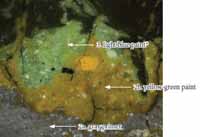 Sample NI 52 (mantel), uncast, 200x
Sample NI 52 (mantel), uncast, 200x
Accurate color readings for the third generation blue-green paint in the southwest room could not be obtained with the Minolta Chroma Meter because a clean, smooth area could not be isolated for measurement. Instead, the closest commercial color match was determined by eye using a stereomicroscope at 30x magnification with a color corrected light source. The closest match for this paint was determined to be Sherwin Williams #2811 "Rookwood Blue Green".
 Sherwin Williams
Sherwin Williams
#2811
"Rookwood Blue green"
| CIE L*a*b* values | L* (black to white) | a* (green to red) | b* (blue to yellow) |
|---|---|---|---|
| 53.79 | -9.94 | +2.79 | |
| Munsell values | hue | value | chroma |
| 6.8G | 5.3 | 1.8 |
First-Floor Northwest Room [Room 101]
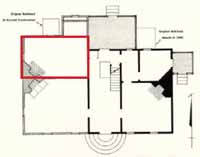 First floor plan, Robert Nicolson House
First floor plan, Robert Nicolson House
Northwest room is outlined in red
Discussion of Results: This room was constructed c.1764, at the same time as the adjacent southwest room. Accordingly, these rooms share the same paint history. This suggests that during the Nicolson period (1751-1797), these rooms were painted in the same manner, and therefore chromatically linked. Since this room contains the same early paints as the southwest room, fluorochrome staining, color matching, and pigment ID were not carried out. Please refer to the southwest room section for that information.
Like the adjacent southwest room, the paint analysis results suggest that the wainscot in this room is contemporary with the rest of the woodwork. The mantel was installed in 1940 and was not sampled.
Generation 2: This generation consists of a shellac sealant (identified by its orange autofluorescence) followed by a coarsely ground gray primer that contains lead white, carbon black, and a few scattered, large red earth pigment particles. This was finished with a coarsely ground yellow-green paint that contains white lead, yellow earth pigments, and small amounts of Prussian blue and carbon black. There was usually a thin layer of grime on the surface of this paint, suggesting it was exposed for a relatively long period of time.
This finish was found on all woodwork in the room, including the door architrave and leaf to the passage (NI 61 and NI 62 p. 114), and the closet door architrave and leaf (NI 59, 60, p. 113), the wainscot (NI 56, 58, p. 112), and the window architraves (NI 64, p. 115). Therefore, the wainscot in this room is contemporary with the rest of the woodwork and would date to c.1764, unlike the passage and east rooms, where it was added c.1777.
Generation 3: This generation consists of a coarsely ground blue-green paint made with lead white, yellow earth, and large particles of Prussian blue pigment. There is a thin, brownish layer on the surface of this paint that could be grime or an oil-based varnish (based on its dim autofluorescence in UV).
Generations 4-5: The scheme during these periods is unknown. In the adjacent room, the mantel was painted black and varnished, while the rest of the woodwork was unpainted.
Generation 6: This generation is the same scheme of cream-colored woodwork and faux-grained door leaves and chair rails that was used in the rest of the house. During this period the mantel was probably painted black and varnished, as it was in the adjacent southwest room.
109Generation eight: A thin layer of brick-red colored paint was found all of the woodwork (this layer was cropped out of the wainscot photomicrographs).
Generations 9-12: These paints are all finely ground, smooth, and consistent white paints that appear to have been industrially prepared, and probably date to the late 19th or early 20th century.
Generations 13-17: These are modern paints, including the present pale blue color. Generation 13 is the first of three green-colored paints, which probably dates to 1940, when Cogar restored the house. Cogar noted in his diary that rudimentary paint scrapes carried out by himself and his mother found that the first paint in this room was green (Wenger 1986, 28).
| Paint Generation | Description | Notes |
|---|---|---|
| 16-17 | pale blue paint, modern | current finish |
| 13-15 | green paints, modern | possibly Cogar-era (1940) |
| 9-12 | white paint, post-industrial | late 19th or early 20th c. |
| 8 | brick-red paint on wall woodwork | |
| 7 | gray paint on wainscot, dark brown resinous paint on door leaves and architraves | gray paint contains zinc white (ZnO), post c.1845 |
| 6 | faux wood graining (6a-6d), possibly oak, on door leaves, rest of woodwork painted cream. | Same scheme in other first-floor rooms. |
| 5 | missing | probably same as adjacent SW room |
| 4 | missing | probably same as adjacent SW room |
| 3 post-1764 | blue-green paint (3a), grime or oil-based varnish (3b) | |
| 2 c.1764 | gray primer (2a), yellow-green paint (2b) | found on all woodwork, including wainscot |
| 1 c.1752 | not yet constructed |
First-Floor Northwest Room [Room 101] - Sample Locations
111Sample NI 56: south wall, center of second raised wainscot panel from passage door
Sample NI 58: south wall, chair rail cap, above third wainscot panel from passage door
Sample NI 59: south wall, closet door, east architrave, backband
Sample NI 60: south wall, closet door leaf, bottom left panel, bottom left corner
Sample NI 61: east wall, door architrave to passage, north jamb, fascia
Sample NI 62: door leaf to passage, lower right panel, upper left corner
Second-Floor, Main Passage [Room 206]
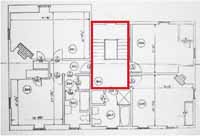 Second floor plan, Robert Nicolson House
Second floor plan, Robert Nicolson House
Main passage is outlined in red
Discussion of Results: The second-floor stair passage woodwork does not contain as many paints as the first-floor, but it does contain the same first generation finish as the first-floor passage, indicating that there are a good number of surviving first period elements in this space.
Generation 1: The woodwork was sealed with shellac (identified by its orange autofluorescence in the wood cells), and primed with a thin gray-colored primer (generation 1a), followed by a dark brown paint (generation 1b), that was very coarsely ground, and contained large chunks of carbon black pigments, red lead pigments, and earth pigments ranging from deep red, brown, and yellow. This was coated with a very thin layer of varnish (1c), which was completely worn away in most samples. This is the same first generation finish in the first-floor stair passage, and dates to c.1751.
The presence of this first generation finish helped identify the first period woodwork in the passage. The door leaf and architrave to the west passage are new, but first period elements include the door architrave on the east wall (see sample NI 84, p. 119), and the door leaves to the eastern rooms (NI 86, 87, pp. 120- 121), as well as the architrave to the present bathroom (NI 89, p. 122).
In a few samples, there did appear to be some grime on the surface of the gray primer (see sample NI 84, p. 119). This suggests that the primer here might have been exposed longer before being repainted, or this could simply be an anomaly of the sample.
Generation 2: This finish is believed to date to c.1764, and is the same dark brown paint used on the first-floor passage woodwork. Although it is the same color as the previous generation, this paint is much more finely-ground, and has a very dim autofluorescence in UV light. It was very deteriorated and missing from some samples, but was clearly present in sample NI 87 (door leaf to southeast room).
One exception is the door leaf to the present bathroom. The earliest paint on this leaf is the yellow-tan primer that was used the western door leaves and architraves in the first-floor passage (c.1764). Here, it appears to have been used as a finish coat (see NI 90, p. 123 and compare to NI 30, p. 70). It was also found on much of the woodwork in the second-floor west wing (see sections for present bathroom, second-floor west passage, southwest and northwest rooms). This suggests that this door leaf was moved from one of the western rooms, although it is not clear which one.
Generation 6: The woodwork in this space appears to have been unpainted in generations 3-5. Generation six is a faux-wood graining finish with a peach-colored base coat (6a) and a brown glaze (6b). Generation 117 6b is not seen in all samples. This finish is visually very similar to the sixth generation faux-wood graining finish on the first floor. It seems likely that these finishes are contemporary. This finish is believed to date to the early-mid 19th century.
Generations 7-9: These are smooth, consistent, finely ground modern white paints that appear to have been industrially prepared.
Generations 10-14: These are modern paints. The earliest probably dates to the Cogar-era (1940).
| Paint Generation | Description | Notes | |
|---|---|---|---|
| 10-14 | modern yellow and pale blue paints | current finish pale blue | |
| 7-9 | white paints, post-industrial 6 | faux wood graining finish consisting of peach-colored base coat (6a) and brown glaze (6b) | contemporary with faux-wood graining on first floor |
| 5 | - | not repainted | |
| 4 | - | not repainted | |
| 3 | - | not repainted | |
| 2 c.1764 | finely ground dark brown paint with dim autofluorescence (2b), varnish (2c) | also used in first-floor stair passage | |
| 1 c.1752 | gray primer (1a), coarsely ground dark brown paint (1b), varnish (1c) | also used in first-floor passage (west wall modern) |
Second-Floor, Main Passage [Room 206] — Sample Location Photos
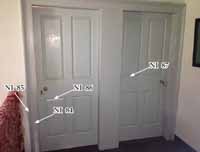 east wall, doors to east rooms
east wall, doors to east rooms
Sample NI 84: east wall, door architrave to northeast room, fascia
Sample NI 84 begins with the same gray primer (1a) and dark brown paint (1b) used on the staircase and the first-floor passage woodwork. Therefore, this architrave is original. However, in this sample there is a dark layer on the surface of the primer, which has a dim autofluorescence, as if it is an oil-bound varnish. However, this layer was not observed in any of the other samples. In general, generation 1a always looked like a primer for the dark brown paint. The condition in this sample is most likely an anomaly. The peach-colored paint applied on top of generation 2 appears to be part of a faux-wood graining scheme. In other samples from this space there is a dark pigmented glaze applied on top (see NI 90, door leaf, p. 123). It also appears very similar to generation 6 on the first-floor, which was also a faux-wood graining scheme. The thickness, consistency, and pigment particle sizes are so similar (compare to sample NI 14, p. 75), that they appear to be contemporary, although they must have imitated different-colored woods. Therefore, this paint is delineated generation 6.
Sample NI 86: door leaf to northeast room, bottom ovolo of lock rail, above left panel
The sample from the door leaf to the northeast room contains the same first generation paint used on Period 1 elements on the first floor. Therefore, this leaf is original.
Sample NI 87: door leaf to southeast room, bottom bevel of top left panel
The sample from the door leaf to the southeast room contains the same first generation paint used on Period 1 elements on the first floor. Therefore, this leaf is original.
Sample NI 89: south wall, door architrave to bathroom, right side, backband cyma
The sample from the door architrave to the present bathroom contains the same first generation paint used on Period 1 elements on the first floor. Therefore, this architrave is original.
Sample NI 90: south wall, door leaf to present bathroom, lower left panel, bottom bevel
The door leaf to the present bathroom is missing the first generation paint. The earliest finish is a yellow-tan paint that was used as a primer on the Period 2 woodwork in the first-floor stair passage (see p. 70 for comparison). This would suggest that this paint dates to c.1764. It is interesting to note that it was used as a primer on the first-floor, but used as a finish coat on the second-floor.
Second-Floor, Present Bathroom [Room 207]
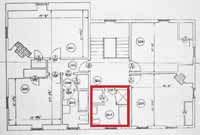 Second floor plan, Robert Nicolson House
Second floor plan, Robert Nicolson House
Present bathroom is outlined in red
Discussion of Results: The only old woodwork in the present bathroom is the door leaf to the passage. The earliest paint on this leaf is the yellow-tan paint that was used as a primer on Period 2 doors in the first-floor stair passage. There, it was coated with a dark brown paint to match the rest of the stair. Here, it was used as a finish coat (see comparison below).
This suggests that this leaf dates to c.1764, and it must have been moved to the bathroom from another area of the house, presumably from the second-floor western wing. It may have been moved from the western wall, since the present door leaf is entirely new.
The door leaf contains generation six, the faux wood graining finish, and generation eight, the brick red paint. The rest of the stratigraphy consists of modern white paints up to the present.
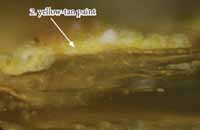 2nd floor bathroom, door leaf to passage
2nd floor bathroom, door leaf to passage
NI 91a, visible light, 200x
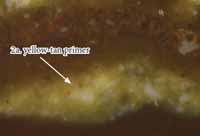 First floor, yellow-tan primer on c.1764 doors
First floor, yellow-tan primer on c.1764 doors
NI 30a, visible light, 200x
Second-Floor, Northeast Room [Room 208]
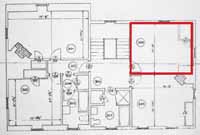 Second floor plan, Robert Nicolson House
Second floor plan, Robert Nicolson House
Northeast room is outlined in red
Discussion of Results: The only old woodwork in this room was the door leaf and trim on the west wall. The sample from the leaf (NI 92, p. 127) contained mostly modern paints, with remnants of what could be an early gray primer in the wood cells.
The sample from the trim (NI 93, p. 128), also began with the early gray primer and what looked like a varnish, followed by the sixth generation faux-wood graining finish.
None of the earliest brown paints were found. It is possible that this woodwork was stripped. The baseboards were examined but contained only a few layers of modern black paint. They were not sampled.
Sample NI 92: door leaf to passage, upper left hand panel, center, left edge near stile
Second-Floor, Southeast Room [Room 209]
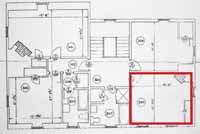 Second floor plan, Robert Nicolson House
Second floor plan, Robert Nicolson House
Southeast room is outlined in red
Discussion of Results: The only woodwork in this room that appeared to contain old paint was the door leaf to the passage (sample NI 105). The mantel did not appear to contain old paints, but since it is purported to be an original element, one sample was collected (NI 106).
The sample from the door leaf contained mostly modern paints, but started with the gray primer on the wood, followed by the sixth generation wood-graining finish.
The mantel did not contain any historic paints. Its stratigraphy began with multiple layers of black paints and varnishes. Remnants of the early gray primer were not seen. This mantel has probably been stripped of its historic finishes.
Second-Floor, Southeast Room [Room 209] - Sample Location Photos
Second-Floor, West Passage [Room 205]
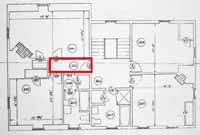 Second floor plan, Robert Nicolson House
Second floor plan, Robert Nicolson House
Second floor west passage is outlined in red
Discussion of Results: All of the woodwork in the western passage appears old, and begins with the c.1764 yellow-tan paint, which was also used as a primer on the first-floor western doors. This is followed by the generation six faux-wood graining, followed by modern paints.
The door architrave to the southwest room (NI 96, p. 135), and door leaves to the northwest and southwest rooms (NI 97 and 98, p. 136), were the same, starting with the c.1764 yellow-tan paint. The early paints on the door architrave to the present bathroom (NI 94, not shown), were missing.
The baseboards were examined but contained only a few layers of modern black paint. They were not sampled.
Second-Floor, West Passage [Room 205] — Sample Location Photos
Sample NI 96: door architrave to southwest room, right (west) side, fascia
The other sample from this architrave (NI 94) was missing its earliest paints.
Sample NI 97: door leaf to northwest room, bottom ovolo of lock rail
Sample NI 98: door leaf to southwest room, bottom ovolo of lock rail
The door leaves to both western rooms began with the second generation yellow-tan paint (2), which was very grimy. In sample NI 98, it was very worn, but remnants remained in the wood cells.
Second-Floor, Southwest Room [Room 202]
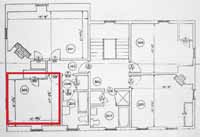 Second floor plan, Robert Nicolson House
Second floor plan, Robert Nicolson House
Second floor, SW room is outlined in red
Discussion of Results: The door leaf to the passage (NI 99, p. 138), was the only element in this room to contain old paints. The window architrave (NI 100, p. 139), and the baseboards (NI 101, not shown), contained modern paints only. The other woodwork appeared new and was not sampled.
The door leaf to the passage has the same early paint history as the other second-floor west spaces. The earliest paint is the yellow-tan primer that dates to c.1764. This is followed by the sixth generation woodgraining finish. Modern paints make up the rest of the stratigraphy.
Second-Floor, Southwest Room [Room 202] — Sample Location Photos
Sample NI 99: door leaf to passage, lock rail, far west (left) end
Sample NI 100: west wall, window architrave, bottom, cyma
The white paint applied to the wood substrate has a 'twinkling', bluish autofluorescence in UV light, and indication that this paint contains zinc white, which was not commercially available in housepaints until c.1845. The window architrave was either stripped or is later than the rest of the woodwork.
Second-Floor, Northwest Room [Room 201]
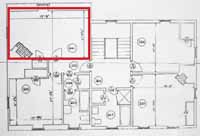 Second floor plan, Robert Nicolson House
Second floor plan, Robert Nicolson House
Second floor, NW room is outlined in red
Discussion of Results: The door leaf and trim leading to the passage (NI 102, p. 142), was the only element in this room to contain old paints. The trim around this door had the same paints but was not sampled. The earliest paint on the mantel (NI 103, p. 143) was a black paint, and the rest of the sample contains modern paints. It is unclear if this black paint dates to the 18th century. The other woodwork in this room appeared new and was not sampled.
The door leaf and trim to the passage has the same early paint history as the other second-floor west spaces. The earliest paint is the yellow-tan primer that dates to c. 1764. This is followed by the sixth generation wood-graining finish. Modern paints make up the rest of the stratigraphy.
Second-Floor, Northwest Room [Room 201] — Sample Location Photos
Sample NI 102: door leaf to passage. Bottom left panel, upper left corner
Sample NI 103: mantel, right jamb
The earliest paint on the mantel is a black paint. Here the sample fragmented and only modern paints were found. It is unclear if this black paint dates to the 18th century. The mantel was re-visited but no 'older' paints were found. The mantel might have been stripped of its paint history.
Conclusions
The interior woodwork at the Nicolson House retains excellent paint evidence that sheds light on the early decorative and structural history of this building, from the first period (c.1751) to the present. Finish stratigraphies were used to confirm a major construction phase c.1764, when the west wing of the house was constructed, and determined that the wainscot in the first-floor stair passage and the southeast room was a c.1777 addition.
Generation 1 (c.1751):
In this phase the house consisted only of the stair passage and eastern rooms on the first and second floors.
The woodwork in both first-floor eastern rooms was painted in the same manner, with a shellac sealant, a gray primer, and a deep blue finish. The present wainscot and baseboards did not exist at this time. The woodwork in the stair passage was prepared similarly, with a shellac sealant and a gray primer, followed by a dark brown paint made with coarsely ground pigments and coated with a thin layer of varnish. This finish extended from the first floor up to the second-floor passage. The present wainscot and baseboards did not exist at this time.
Both of the second-floor eastern rooms do not contain much early woodwork. Fragmentary gray primer on the door leaf and trim in both eastern rooms suggests these elements are original and were painted similarly to the stair passage, but this is uncertain.
Generation 2 (c.1764):
In this phase the house was extended to the west, creating the western rooms on the first and second floors.
The paints in the first-floor stair passage clearly reflected this change. The newly made door leaves and architraves leading to these western rooms are missing the first generation gray primer and dark brown paint. Instead, they were primed with a yellow-tan base coat (primer) and painted with a dark brown paint. This dark brown paint, which was thinner and more finely ground than the previous generation, was applied to all of the woodwork in the first and second-floor stair passage. It was the same color as the previous generation. The wainscot was not yet installed.
The woodwork in the new first-floor western rooms was sealed with shellac, primed with a gray-colored primer, and painted with a dark yellow-green paint. This generation was also found on the wainscot, indicating that in these rooms all woodwork was contemporary. This is interesting because it suggests that the wainscot panelling in the western rooms pre-dates the wainscot panelling in the passage and southeast room.
The first-floor eastern rooms were painted with a finish that appears to consist of indigo pigments in a resinous glaze, unique to what we have found in 18th-century Williamsburg paints. This finish appears glossy, but also very dark and greenish, most likely due to the oxidation of the resinous media. Like the passage, the wainscot in this room was not yet installed.
The finishes in the second-floor eastern rooms are unknown, since the early paints were fragmentary in these spaces.
On the second-floor, all of the woodwork in the new western wing was painted with the same yellow-tan paint that was used as the primer on the first-floor. Here, it was used as a finish coat. This finish was Robert Nicholson House Interior, Cross-Section Microscopy Report September 2013 145 exposed for a very long period of time, as the woodwork on the second floor appears to have gone unpainted until generation six.
Generations 3:
At this time, the first-floor southeast room was painted with a blue paint that matched the first generation. The first-floor western rooms were painted a light blue-green color. This paint is very grimy and appears to have been exposed for a long period of time (the next paint aligns with generation 6). The rest of the woodwork in the house was unpainted.
Generation 4:
At this time, only the first-floor southeast room was painted, using a blue paint that was the same color as the previous generation. The frequency of painting in this room suggests it was a highly visible space that was used often.
Generation 5 (c.1777):
In this period Nicolson made major upgrades to the interior of his home. In the stair passage, he installed the wainscot panelling and panelled closet in the northwest corner. The new woodwork was primed gray (5a), and all of the woodwork was painted with a finely ground dark brown paint (5b), and coated with varnish (5c). The estimated time for this period is c.1777, since it was established that thirteen years passed between generations 1 and 2 in the passage. The surface of generation 2 displays a similar level of deterioration, leading to the proposed date. Interestingly, this time period coincides with Nicolson's discontinuance of taking in lodgers, and probably reflects his improved finances and rising social status. This generation was very disrupted and soiled, suggesting it was exposed for a very long period of time.
In the southeast room, similar wainscot was installed. It was also primed gray (5a) and painted with a light blue paint (5b). Like the passage, this finish was grimy and disrupted, resulting from a long period of exposure.
There was no wainscot panelling installed in the northeast room, and this room was not repainted.
The first-floor western rooms were not repainted. None of the woodwork on the second-floor was repainted.
Generation 6:
This paint scheme was used throughout the house. The majority of woodwork was painted a cream-color, while the door leaves and wainscot caps were picked out in a faux-wood graining finish that might have imitated a lighter-colored wood, such as oak. This faux-wood graining was also found on the entire staircase, with the newels and handrails grained to imitate a more reddish-orange-colored wood. On the second floor, all of the woodwork was grained as well, again imitating a more orange-colored wood. This generation is estimated to date to the early 19th-century and would reflect the period of the Power occupancy (c.1803 - 1840).
Generation 7:
This paint scheme varied slightly throughout the house but was most often a grayish-colored paint on the woodwork with dark-brown door leaves and architraves. In some rooms, the mantels were painted black (although most mantels were not original or did not have early paint). The gray paint contains zinc white pigment, which indicates this generation post-dates c.1845.
Generation 8:
The exact scheme during this period is inconclusive, but in most rooms all of the woodwork was painted with a brick-red colored paint.
Late 19th-century early 20th-century:
After this period, the rooms in the house were repainted at different periods, and the paint layers do not clearly align. In general, all rooms contain at least three generations of finely ground, industrially prepared white paints that probably date to the late 19th and early 20th centuries.
Cogar-era (1940):
The house was restored by Cogar in 1940. At this time he repainted at least some of the rooms using colors he exposed through rudimentary paint scrapes. The stair passage was painted a yellow color, which suggests that Cogar made his scrapes on one of the western doorways, mistakenly interpreting the second generation yellow-tan primer as a finish coat. The first-floor eastern rooms were painted blue, and the first-floor western rooms were painted green.
The house has been repainted by CWF approximately four times since the Cogar era. The present color on the first floor woodwork is a light blue, with the kitchen (northeast room) painted red-brown. On the second floor, the light blue from the stair passage continues up to the second floor. The woodwork in the second-floor eastern rooms are painted deep red, and the western rooms are painted light green.
Re-thinking the previous exterior paint findings:
As discussed in the "Previous Research" section of this report (p. 5), in 2006 the Period 2 (c.1764) generation paint was determined to be a medium tan color, as determined by Susan Buck using a sample taken from a window frame on the south elevation, just east of the front door. This medium-tan paint looks very similar to what is called the 'yellow-tan' interior paint used to prime the western passage doorways and finish the second-floor woodwork in Period 2.
When Natasha Loeblich re-examined the house with twenty additional samples the next year, she concluded that the first four generations were cream-colored paints. She did not find the medium-tan color identified by Buck. However, there was one sample that was an anomaly among the set: sample NC 7, taken from a window frame on the south (front) elevation, just west of the front door, which would date to Period 2. The earliest paint in the sample is a "yellow paint" that looks very similar to the yellow-tan paint used on the interior in Period 2 (Loeblich 2007, 6). Since this was the only sample containing this paint, Loeblich, understandably, dismissed it as an anomaly.
In the context of what is now known of the interior paint history, it is very possible that the yellow-tan paint used on the interior is the same as the "medium-tan paint" found by Buck and the "yellow paint" found and dismissed by Loeblich. Was this paint used as an exterior coating? Or was it applied only to these window frames for an unknown reason? Additional sampling is recommended to confirm the presence of the c.1764 yellow-tan paint on the exterior. However, since Loeblich did not find this yellow paint in any of her other nineteen samples, it may be an elusive finish.
Footnotes
References
- Buck, Susan. 2006. Period II Nicolson House Paint Color. Memo to Edward Chappell, Director of Architectural and Archaeological Research.
- Bristow, Ian. 1996. Interior House Painting Colours and Technology. New Haven and London, Yale University Press.
- Eastaugh, N., et. al. 2008. Pigment Compendium: a dictionary and optical microscopy of historical pigments. Oxford, Butterworth-Heinemann.
- Gettens, R., and G. Stout. 1942. Painting materials: a short encyclopedia. New York, Dover Publications, Inc.
- Loeblich, Natasha. 2007. Cross-Section Microscopy Analysis of Exterior Paints: Robert Nicolson House (Block 7, Building 12), Williamsburg, Virginia. Unpublished report for the Colonial Williamsburg Foundation Department of Architectural and Archaeological Research.
- Savedge, Catherine. 1976. Robert Nicolson House Architectural Report, Block 7 Building 12. Colonial Williamsburg Foundation Library Research Report Series — 1082.
- Samford, Patricia. 1986. Robert Nicolson House Archaeological Report Block 7 Building 12. Colonial Williamsburg Foundation Library Research Report Series — 1083.
- Travers, Kirsten. 2011. "Lead and Zinc-based Paint in Cross-Section: a Comparative Study of Elemental Composition and Autofluorescence Behaviors in Architectural Paints." Unpublished research report completed as part of graduate coursework for the Winterthur/University of Delaware Program in Art Conservation.
- Wenger, Mark R. 1986. Robert Nicolson House Architectural Report, Block 7 Building 12. Colonial Williamsburg Foundation Library Research Report Series — 1084.
- Whiffen, Marcus. 1984. The Eighteenth-century Houses of Williamsburg. Williamsburg: the Colonial Williamsburg Foundation.
Appendix A: Procedures
Sample Preparation:
The samples were cast in mini-cubes of Extec Polyester Clear Resin (methyl methacrylate monomer), polymerized with the recommended amount of methyl ethyl ketone peroxide catalyst. The resin was allowed to cure for 24 hours under ambient light. After cure, the individual cubes were removed from the casting tray and sanded down using a rotary sander with grits ranging from 200 — 600 to expose the cross-section surface. The samples were then dry polished with silica-embedded Micro-mesh Inc. cloths with grits ranging from 1500 to 12,000, lending the final cross-section surface a glassy-smooth finish.
Microscopy and Documentation:
The cross-section samples were examined using a Nikon Eclipse 80i microscope equipped with an EXFO X-cite 120 fluorescence illumination system fiberoptic halogen light source. Samples were examined and photographed under visible and ultraviolet light conditions (330-380 nm), at 20 to 200x magnifications. Digital images were captured using a Spot Flex digital camera with Spot Advance (version 4.6) software. All images were recorded as 12.6 MB tiff files and stored on a hard drive in a folder titled "Nicolson House Interior" on Susan Buck's laboratory computer. A separate set of images will be stored on the CWF digital database, accompanied by the appropriate metadata and a digital version of the final report.
Information Provided by Visible and Ultraviolet Light Microscopy:
When examining paint cross-sections under reflected visible and ultraviolet light conditions, a number of physical characteristics can be observed to assist with the interpretation of a paint stratigraphy. These include the number and color of layers applied to a substrate, the thickness or surface texture of layers, and pigment particle size and distribution within the paint film. Relative time periods for coatings can sometimes be assigned at this stage: for instance, pre-industrial-era paints were hand ground, lending them a coarse, uneven surface texture with large pigment particles that vary in size and shape. By contrast, more "modern", industrially-prepared paints have smoother, even surfaces and machine-ground pigment particles of a consistent size and shape. Furthermore, he presence of cracks, dirt layers, or biological growth between layers can indicate presentation surfaces and/or coatings that were left exposed for an extended period of time.
Under UV light conditions, the presence and type of autofluorescence colors can distinguish sealants, clear coatings, and binding media, from darker dirt or paint layers within the stratigraphy. For instance, shellacs exhibit a distinct orange-colored autofluorescence, while natural resins (such as dammar and mastic), typically fluoresce a bright white color. Oil media tends to quench autofluorescence, while most modern, synthetic paint formulations (such as latex) exhibit no fluorescence at all. Some pigments, such as verdigris, madder, and zinc white, have distinct fluorescence characteristics, as well. UV light microscopy is critical to help distinguish otherwise identical layers often found in architectural samples- such as successive varnishes, or multiple layers of unpigmented (white) limewash.
Binding Media Analysis using Fluorochrome staining:
Fluorochrome stains adapted from the biological sciences were used to characterize the paint binding media (oils, proteins, carbohydrates), in layers within the cross-section sample. The following stains were used in this analysis:
2,7 Dichlorofluorescein (DCF): 0.02% w/v in ethanol. Fluorescent labeling reagent for lipids, particularly drying oils. One drop of stain was applied to the surface of the sample, blotted immediately, and cover-slipped with mineral spirits. The reaction was observed with the B2A filter cube (EX 450-490nm, BA 520nm). This stain exhibits a yellow-green fluorescence where lipids are present.
Triphenyl tetrazolium chloride (TTC): 1.0% w/v in ethanol. Labeling reagent for carbohydrates (gums, starches, cellulosic thickeners). One drop of stain was applied to the surface of the sample, blotted dry, and allowed to sit for approximately 45 seconds before cover-slipping, (must be allowed to react with atmospheric moisture for reaction to move forward). The reaction is observed under reflected UV light conditions (EX 330-380nm, BA 420nm). A dark red-brown color is seen where carbohydrates are present.
Fluorescein isothiocyanate (FITC): 0.02% w/v in anhydrous acetone. Fluorescent labeling reagent for proteins. One drop of stain was applied to the surface of the sample, blotted immediately, and coverslipped with mineral spirits. The reaction was observed using the B-2A filter cube (EX 450-490 nm, BA 520nm). A positive reaction is a bright yellow-green fluorescence.
Pigment Identification with Polarized Light Microscopy:
To collect a pigment sample for polarized light microscopy (PLM), a surgical scalpel was used to collect a small scraping from a clean, representative area of paint. The blade was then pressed and pulled across a clean glass microscope slide, dispersing the pigment particles across the surface. The pigments were then permanently embedded under a cover slip using Cargille Meltmount (refractive index 1.66). The embedded pigments were then examined in cross and plane-polarized transmitted light with the Nikon Eclipse 80i microscope at 1000x magnification (using an oil immersion objective). The observed morphologies (size, shape, agglomeration, cleavage patterns), and optical properties (including color, refractive index, extinction), were compared to reference standards as well as literature sources before making final determinations.
Color measurement and matching:
Color measurements were taken using the Minolta Chroma Meter CR-241 colorimeter/ microscope in Susan Buck's paint analysis laboratory. Equipped with an internal 360-degree pulsed xenon arc lamp, this instrument is capable of obtaining accurate color measurements in any one of five different tristimulus color measurement systems from areas as small as 0.3mm. For the purposes of this project, color values in CIE L*a*b* colorspace and the Munsell color system were obtained.
The CIE L*a*b* color space system (developed in 1976 by the Commission International de l'Eclairage, and now an internationally accepted industry-standard color measuring system) uses three numerical values, known as "tristimulus" values, to measure color: L* is the lightness variable, representing dark to light on a scale of 0-100, while a* and b* are chromaticity coordinates, a* representing red to green on scale from -50 to +50, and b* representing blue to yellow on a scale from -50 to +50. These three coordinates are used to plot the location of a color in the CIE L*a*b* colorspace.
150These resulting values can be used to quantify color differences (Δ E), between two samples. To obtain this value, the following calculation is used:
ΔE = (ΔL*)1/2 + (Δa*)1/2 + (Δb*)1/2Generally, a ΔE value = 3 cannot be perceived by the human eye (Wolbers 2008). Therefore, for any two samples, ΔE values at or below this range are considered acceptable matches.
Ideally, color measurements should be collected from a clean, unweathered sample area. If necessary, a scalpel is used to scrape an area clean before color matching. Due to inherent color variations in paints (especially in hand ground, pre-industrial coatings), multiple readings are taken and averaged together to establish the final CIE L*a*b* values.
Due to the deterioration, soiling, and fragmentary nature of some early paints, color readings cannot always be obtained with the Chroma Meter. In these instances, paints are matched by eye to Munsell standard color swatches and commercial paint chips, using a stereomicroscope at 30x magnification with a color corrected light source. Commercial systems consulted include Benjamin Moore, Sherwin Williams, Pittsburgh Paints, and the Colonial Williamsburg Color Collection.
Appendix B. Sample Memo
From: Ed Chappell
Subject: Interior Paint Investigation, Robert Nicolson House
Block 7, Building 12
You and I began looking at interior paint evidence at the Nicolson House this afternoon. There is a rich range of early woodwork, seemingly of two principal periods, so my hopes are high that we will find strong evidence for how the spaces were differentiated or drawn together by color as well as the obvious variation in woodwork.
I write these notes without reading Mark R. Wenger's good report.
I will note your field observations, while understanding that these are very preliminary.
- 1. East (right) face of upper square section of 12th full baluster, north edge 1/8" below the rail.
- 2. Northeast edge of ovolo immediately below the upper square of the 17th baluster. Both seem to begin with dark brown.
- 3. Top of cove at top of outer stringer on stair above the 11th and 12th balusters.
- 4. Flat fascia of the same stringer immediately below the cove below 10th and 11th balusters.
- 5. Thin middle cyma of same stringer below the 10th baluster.
- 6. South (right) edge of raised field, 1" below corner of raised field, middle panel of wainscot below the stair stringer. This paneling is fitted under the stringer in a manner suggesting that it could have been added in second period. Nevertheless, you see a similar brown as the bottom layer.
- 7. Upper edge of sloping upper panel rail above the first panel and below 9th baluster. Samples 1 to 7 may have light blue paint.
- 8. Base below top molding, below leading (south) edge of middle panel.
- 9. Middle of thin astragal at bottom of handrail, west face, centered above 9th baluster.
- 10. Bottom edge of cove at top of fascia on inner (east) side of handrail, above the upper edge of the 12th baluster. You see brown on the rail, samples 9 and 10.
- 11. Upper rail of wainscot rising along east (right) side of the stair, 1" above the ovolo, ½" north (left) of the leading (bottom) sloping panel.
- 12. Upper rail of panel immediately below its cap, just to the south (northern-most) rectangular panel, third from the door into the southeast (right front) room. There is a vertical seam in the panel style just east of the first step, so this could mean that the wainscot on this wall is of two dates, that running up beside the stair earlier than straight wainscot in the passage, or it could simply be an awkward piece of contemporary joinery.
- 13. West (left) wainscot in passage, ovolo of north stile at first panel north (right) of door into southwest (left front) room, 1" below the top rail.
- 14. Wainscot cap, west wall, bottom edge of torus centered over the same first panel north of the southwest (left front) 152 door.
- n15. Second newel post, at top of first stair run, east face at southeast (front right) corner, even with sloping astragal.
- n16. Horizontal north wainscot at first landing, ovolo on stile east of middle panel, at bevel, 7" below the top rail.
- n17. Bottom of torus on the cap of the same north wainscot, 2" west (left) of center of middle panel.
- n18. Top of thin middle cyma, horizontal, north-facing architrave finishing the south edge of the stairwell, ¾" west of plaster on the east transverse partition.
- n19. Middle fascia at backband, north (left) architrave of doorway into southeast (right front) room, 1' 7" above floor.
- n20. Middle fascia ½" north of backband on south (right) architrave of same doorway to southeast room, 1' 8" above floor.
- n21. One half inch above lower edge and 3" south of north side of bottom north (left) raised panel, west (passage) face of door into southeast (right front) room. This is a superior door, with ovolos edging the raised panel fields and ovolos and cymas on the stiles and rails, both sides of the 1¾"—thick leaf. We have not yet sorted out whether this door leaf is first period of second because it matches its counterpart across the passage. This one seems to have been trimmed on both edges, then extended (or simply had the edges replaced). Now hung on butt hinges, but there are scars from HL hinges on the inner face.
- n22. Same door, bottom ovolo on lock rail, just above upper north (left) edge of north (left) bottom panel. You still see brown.
- n23. South (front) exterior door, inner face, west rail of west leaf, 2" out from vertical ovolo and 3½" below that of the lock rail. The panels are flat inside.
- n24. Same south door, west architrave, outer side of cyma backband, ¼" from front edge and 2' 5" above floor.
- n25. Peg rail west of south door in stair passage, 5" west of door architrave immediately above bottom bead. This is an addition by James Cogar, so it should provide a guide to 20th-century paint layers.
- n26. Backband of north architrave, doorway to (second-period) southwest (left front) room, cyma ¼" from fillet, 1' 8" above floor.
- n27. Same door to southwest room, passage face, bottom ovolo on north (right) bottom panel, 1½" from inner bottom corner. This is another fine door leaf with raised panels and complex moldings on both sides, and 1¾" thick, hung on 1'-high HL hinges with the stationary leaf hidden behind the architrave, active leaf surface-mounted. It is likely that this is second-period.
- n28. West wall, southernmost panel, raised field 2" below top edge and 1" from south (left) edge.
- n29. Bottom edge of torus on wainscot cap 10" south (left) of architrave for door into southwest room. The panels and stiles of the wainscot on the west wall respond perfectly to the two second-period doorways, suggesting the wainscot was added or vigorously reworked when the west wing was added.
- n30. North (right) architrave, doorway to northwest (left rear) room, middle fascia ½" out from cyma background and 1' 4" above floor.
- n32. Leaf of same door to northwest room, north (right) bottom panel, north bevel at raised field 3" below the top. Very interesting that while the door has the same six-panel elevation, it is much cheaper: plain raised panels and only ovolos on stiles and rails of outer face, flat recessed panels and no molding on the inner face. Also hung on HL hinges 153 with stationary leaf hidden behind the single architrave.
- 32. Upper door of closet at northwest corner of the passage, lower bevel of bottom panel ¼" from raised field and 1½" from east edge. Notice that the closet is an early feature, with double architraves and simple panels like those on the wainscot and northwest door leaf rather than the lavish work on the doors to the two south rooms. Both leaves (bottom one 20th-century replacement) hung on 4" to 4¼"-high H hinges, set into the stile and architrave.
- 33. Closet at northwest corner of passage, east (right) architrave, middle fascia, adjoining middle cyma 1' 6" above floor.
- 34. West wall, base 1" north of architrave, doorway to northwest room, ½" below the cap.
- 35. East (right) side closet in passage, ovolo on north stile 7" below middle rail.
- 36. West wall, base, cyma cap 1" north of architrave of door to northwest room (just above sample 34).
- 37. East (right) architrave of north (rear) exterior door, middle of cyma backband. 1' 9" above the floor.
- 38. East (right) ovolo of middle stile of same north door, 5" above bottom rail.
- 39. Door to cellar stair in passage, bottom ovolo on lock rail 1" west (right) of east stile.
- 40. Same cellar stair door, fillet of east architrave, inner edge, 9" above the floor.
Appendix C. Sample Memo
Cc: Susan Buck
From: Kirsten Travers
Date: July 3, 2013
Re: Nicolson House Interior Paint Samples
Yesterday I collected 55 paint samples from first-floor spaces inside the building. I was accompanied by Ed Chappell who examined the woodwork, directed sample collection and recorded sample locations for NI 1 — NI 40, which will be written up in a separate memo. This memo records information for samples NI 41 — NI 55.
Stair and Stair Passage [Room 105]
Samples NI 1 — NI 41 were taken from the stair and stair passage woodwork (Room 105 in the 1986 architectural report).
NI 41 East wall, doorway to present kitchen, south architrave, center fascia, 27" up from floor
First floor, southeast room [Room 107]
NI 42 West wall, door architrave (north), cyma of backband, 19" up from floor
NI 43 West wall, door leaf, bottom right panel, right beveled edge
NI 44 West wall, wainscot to right of passage door, stile just adjacent to door
NI 45 West wall, chair rail, underside of cap, 4" to right of passage door
NI 46 West wall, baseboard, top cyma, 6" to right of passage door architrave
First floor, southwest room [Room 102]
NI 47 East wall, door architrave, left side, inner fascia, 20" up from floor
NI 48 South wall, wainscot, face of second raised panel from the west
NI 49 Door leaf, bottom left panel, top left corner
NI 50 Door leaf, center left panel, ovolo on underside
NI 51 East wall, door architrave, right (south) architrave, cyma of backband, 29" from floor
NI 52 Mantel, crown molding cushion (?) above dentil course, far left end
NI 53 Mantel, backboard, far left end, 54" up from floor
NI 54 West wall, wainscot stile, 1" from north wall, top edge
NI 55 North wall, wainscot stile adjacent to mantel, 27" up from floor
Appendix D. Sample Memo
Cc: Susan Buck
From: Kirsten Travers
Date: August 9, 2013
Re: Nicolson House Interior Paint Samples, Block 7, Building 12
On Wednesday, August 7 and Thursday, August 8, I collected forty-nine additional paint samples (NI 56 — NI 104) from the interior of the Nicholson House.
First floor, Northwest room
NI 56 South wall, second wainscot panel from doorway to passage, center of the raised panel at pre-existing crack
NI 57 South wall, third wainscot panel from doorway to passage, top stile, bottom ovolo, ~14" from closet door architrave
NI 58 South wall, chair rail (top cap), above third wainscot panel from east, ~4" from closet door architrave
NI 59 South wall, closet door architrave, east jamb, backband, ~30" above floor
NI 60 South wall, closet door leaf (inferior construction), bottom left panel, lower left corner
NI 61 East wall, door architrave to passage, north side, fascia
NI 62 Door leaf to passage, lower right panel, upper left corner
NI 63 Mantel, far right end of raised panel, bottom bevel (this is a new piece)
NI 64 North wall, window architrave, east side, cyma of backband, ~24" up from bottom
NI 65 North wall, wainscot panel to left of doorway to rear room, right (east) beveled edge
First floor, Southeast Room
NI 66 South wall, window architrave, right side, cyma, 10" up from bottom
NI 67 South wall, wainscot panel to right (east) of easternmost window. Top rail, bottom ovolo
NI 68 South wall, cap (chair rail) of wainscot panel, ~3" west of easternmost window
NI 69 Door architrave to northeast room (current kitchen). Right (east) architrave, cyma of backband, 30" above floor
NI 70 Door leaf to northeast room (current kitchen), bottom left panel, beveled underside
First floor, northeast room (present kitchen)
Notes: Baseboards excavated but only recent paints found. Not sampled.
156NI 71 South wall, door architrave, east side, fascia, 18" up from floor
NI 72 South wall, door leaf, lock rail, west edge
NI 73 South wall, chair rail, 7" from south wall
NI 74 West wall, door architrave to passage, south side, fascia, 16" up from floor
First floor passage
NI 75 Door architrave to northeast room, north side, center fascia, ~60" up from floor
NI 76 Door architrave to southwest room, top architrave, cyma, upper left corner
NI 77 Door architrave to southwest room, north side, inner fascia, at top near junction of top architrave
NI 78 South entrance, door architrave, east side, fillet of backband, 7" up from floor
NI 79 South entrance, door leaf, east leaf, top rail, bottom ovolo
NI 80 North entrance, door leaf, second rail from top, bottom ovolo above center of left panel
NI 81 North entrance, door architrave, left (west) architrave, inner bead, 60" up from floor
NI 82 North entrance, door architrave, left (west) architrave, backband cyma, 56" up from floor
NI 83 North entrance, door architrave, right (east) architrave, backband fillet, ~50" up from floor
Second floor, main passage
Note: Door architrave and leaf on the west wall are new
NI 84 East wall, door architrave to northeast room, fascia adjacent to backband, 24" up from floor
NI 85 East wall, door architrave to northeast room, backband cyma, 26" up from floor
NI 86 Door leaf to northeast room, bottom ovolo of lock rail, above bottom left panel
NI 87 Door leaf to southeast room, bottom beveled edge of top left panel
NI 88 South wall, door architrave to bathroom, left (east) side, fascia against backband, 20" up from floor
NI 89 South wall, door architrave to bathroom, right (west) side, cyma of backband, 50" up from floor
NI 90 South wall, door leaf to bathroom, lower left panel, bottom beveled underside
Second floor, present bathroom
Note: Window is screwed shut, cannot open. All other woodwork new
NI 91 Door leaf to passage (inferior construction), lower right panel, upper left corner
Second floor, Northeast room
Note: Baseboards had modern paints only. Not sampled.
NI 92 Door leaf to passage, upper left hand panel, center, left edge near stile
NI 93 Door to passage, trim, left side, ~30" up from floor
Second floor, west passage
NI 94 South wall, architrave of doorway from passage to present bathroom vestibule, right (east) side, fillet of backband, ~36" up from floor
NI 96 Door architrave to southwest room, right (west) side, fascia near bead, ~24" up from floor
NI 97 Door leaf to northwest room, bottom ovolo of lock rail above lower right panel
NI 98 Door leaf to southwest room, bottom ovolo of lock rail just below knob
Second floor, southwest room
Note: The trim around the door had the same paints as the leaf. Not sampled. The window sash on the south wall was examined but no old paints were found. Not sampled. The baseboards did not have a lot of paints, but one sample (NI 101) was taken.
NI 99 Door leaf to passage, lock rail, far west (left) end, bottom edge
NI 100 West wall, window architrave, bottom architrave, cyma at bottom right corner
NI 101 North wall, baseboard, at top near bead, 5" west of closet
Second floor, northwest room
Note: The trim around the door had the same paints as the leaf. Not sampled. All baseboards have only modern paints. Not sampled. Didn't find any old paints on the "old" pieces of window trim. Not sampled.
NI 102 Door leaf to passage. Bottom left panel, upper left corner
NI 103 Mantel, right side, 40" up from floor
Vestibule to present bathroom
NI 95 Door architrave to passage, west side bead between trim and stop, ~40" above floor
Appendix E. Sample Memo
Cc: Susan Buck
From: Kirsten Travers
Date: October 1, 2013
Re: Nicholson House Interior Paint Samples, Block 7, Building 12
On Friday, September 13, I collected two paint samples (NI 105, NI 106) from original woodwork in the second-floor southeast room, which I was not able to access on my previous visits.
Most of the woodwork in this room did not appear to have old paint. The door to the passage was an exception. The mantel is purportedly old, so a sample was taken from it, although it appeared to contain only modern paints.
Second floor, southeast room [Room 209]
NI 105 Door to passage, room-side, bottom left panel, upper left corner
NI 106 Mantel, fascia board under crown molding, far right corner
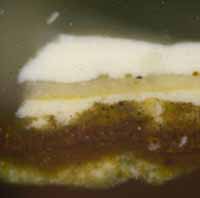 NI 30a VIS repolished 400x_adj
NI 30a VIS repolished 400x_adj
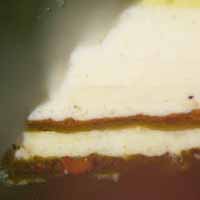 NI 31a VIS repolished 400x_adj
NI 31a VIS repolished 400x_adj
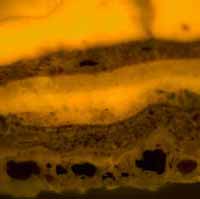 NI 39 before staining B-2A 400x
NI 39 before staining B-2A 400x
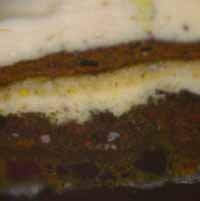 NI 39 before staining VIS 400x
NI 39 before staining VIS 400x
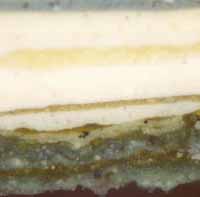 NI 42b repolished VIS 400x_adj
NI 42b repolished VIS 400x_adj
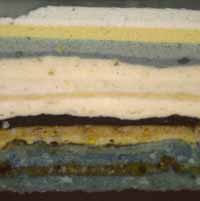 NI 43 before staining VIS 200x
NI 43 before staining VIS 200x
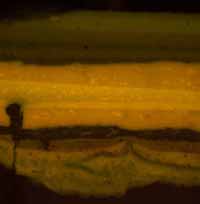 NI 43 repolished B2A b4DCF 200x
NI 43 repolished B2A b4DCF 200x
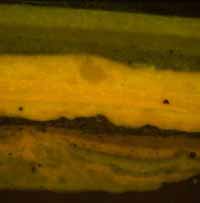 NI 43 repolished B2A FITC 200x
NI 43 repolished B2A FITC 200x
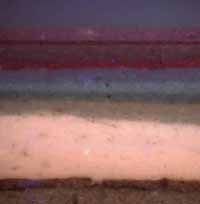 NI 99b UV 400x (detail of red spa…
NI 99b UV 400x (detail of red spa…
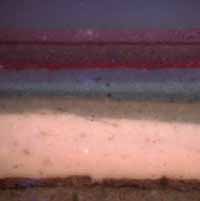 NI 99b UV 400x (detail of red spa…
NI 99b UV 400x (detail of red spa…
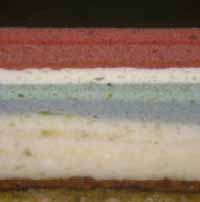 NI 99b VIS 400x (detail of red sp…
NI 99b VIS 400x (detail of red sp…
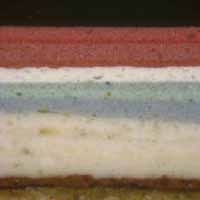 NI 99b VIS 400x (detail of red sp…
NI 99b VIS 400x (detail of red sp…
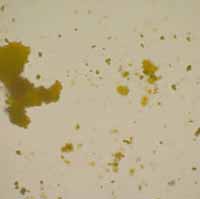 PLM reference Cadmium Yellow …
PLM reference Cadmium Yellow …
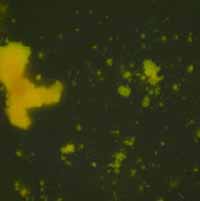 PLM reference Cadmium Yellow …
PLM reference Cadmium Yellow …
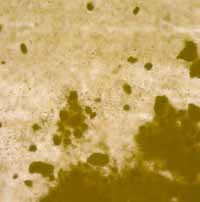 PLM reference Chrome Yellow P…
PLM reference Chrome Yellow P…
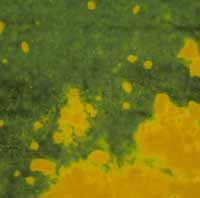 PLM reference Chrome Yellow X…
PLM reference Chrome Yellow X…
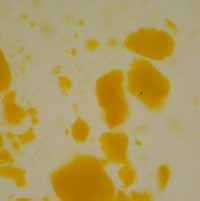 PLM reference Indian Yellow PP…
PLM reference Indian Yellow PP…
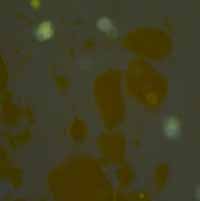 PLM reference Indian Yellow XP…
PLM reference Indian Yellow XP…
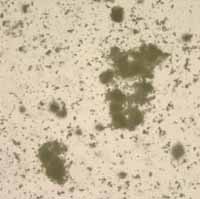 PLM reference Lead Tin Yellow P…
PLM reference Lead Tin Yellow P…
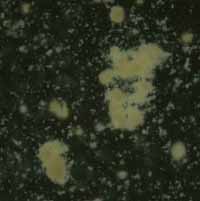 PLM reference Lead Tin Yellow …
PLM reference Lead Tin Yellow …
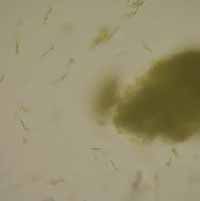 PLM reference Lemon Yellow PP…
PLM reference Lemon Yellow PP…
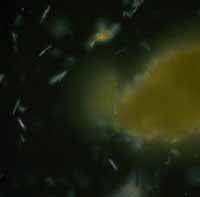 PLM reference Lemon Yellow XP…
PLM reference Lemon Yellow XP…
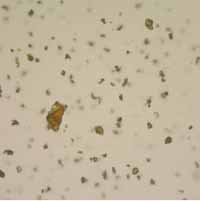 PLM reference Litharge PPL 400x
PLM reference Litharge PPL 400x
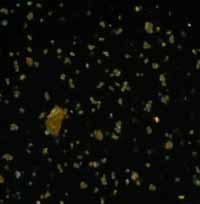 PLM reference Litharge XPL 400x
PLM reference Litharge XPL 400x
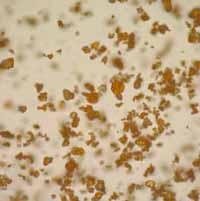 PLM reference Red Lead 2 PPL 1…
PLM reference Red Lead 2 PPL 1…
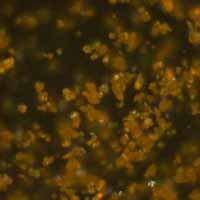 PLM reference Red Lead 2 XPL 1…
PLM reference Red Lead 2 XPL 1…
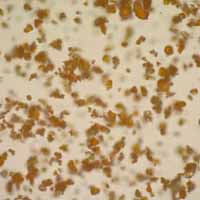 PLM reference Red Lead PPL 100…
PLM reference Red Lead PPL 100…
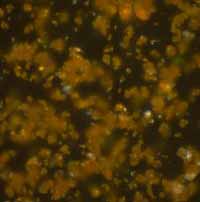 PLM reference Red Lead XPL 100…
PLM reference Red Lead XPL 100…
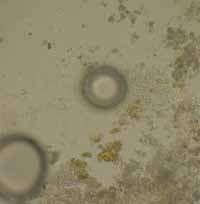 PLM_NI 27 later wood graining 2…
PLM_NI 27 later wood graining 2…
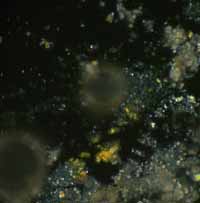 PLM_NI 27 later wood graining 2…
PLM_NI 27 later wood graining 2…
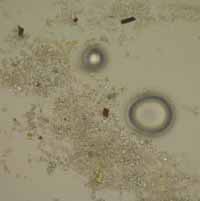 PLM_NI 27 later wood graining 3…
PLM_NI 27 later wood graining 3…
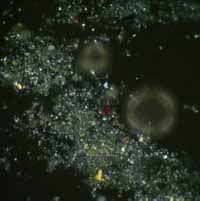 PLM_NI 27 later wood graining 3…
PLM_NI 27 later wood graining 3…
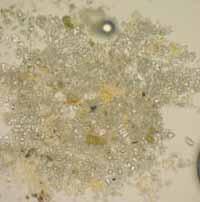 PLM_NI 27 later wood graining 4…
PLM_NI 27 later wood graining 4…
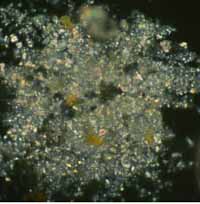 PLM_NI 27 later wood graining 4…
PLM_NI 27 later wood graining 4…
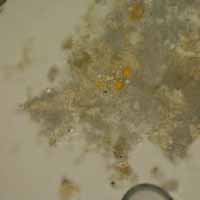 PLM_NI 27 later wood graining …
PLM_NI 27 later wood graining …
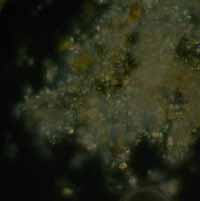 PLM_NI 27 later wood graining …
PLM_NI 27 later wood graining …
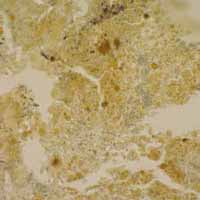 PLM_NI 31 gen 1a yell_tan prim…
PLM_NI 31 gen 1a yell_tan prim…
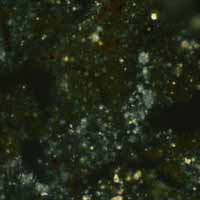 PLM_NI 31 gen 1a yell_tan prim…
PLM_NI 31 gen 1a yell_tan prim…
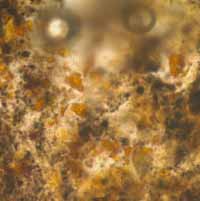 PLM_NI 39 early browns 1 PPL 1…
PLM_NI 39 early browns 1 PPL 1…
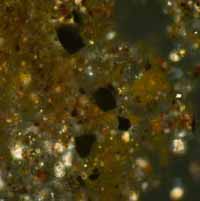 PLM_NI 39 early browns 1 XPL 1…
PLM_NI 39 early browns 1 XPL 1…
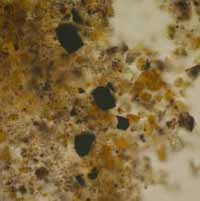 PLM_NI 39 early browns 2 PPL 1…
PLM_NI 39 early browns 2 PPL 1…
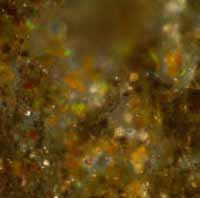 PLM_NI 39 early browns 2 XPL 1…
PLM_NI 39 early browns 2 XPL 1…
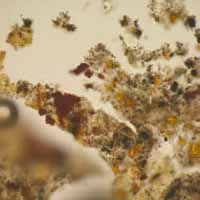 PLM_NI 39 early browns 3 PPL 1…
PLM_NI 39 early browns 3 PPL 1…
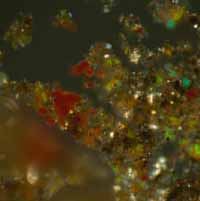 PLM_NI 39 early browns 3 XPL 1…
PLM_NI 39 early browns 3 XPL 1…
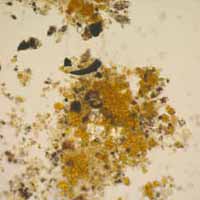 PLM_NI 39 early browns 4 PPL 1…
PLM_NI 39 early browns 4 PPL 1…
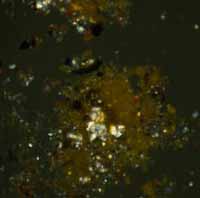 PLM_NI 39 early browns 4 XPL 1…
PLM_NI 39 early browns 4 XPL 1…
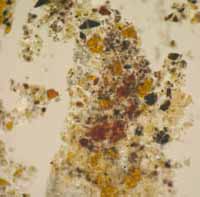 PLM_NI 39 early browns 5 PPL 1…
PLM_NI 39 early browns 5 PPL 1…
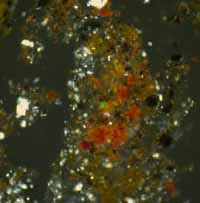 PLM_NI 39 early browns 5 XPL 1…
PLM_NI 39 early browns 5 XPL 1…
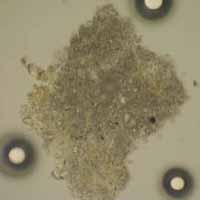 PLM_NI 39 gen1a gray primer 1 …
PLM_NI 39 gen1a gray primer 1 …
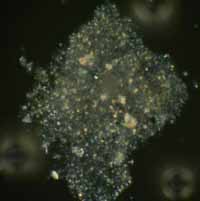 PLM_NI 39 gen1a gray primer 1 …
PLM_NI 39 gen1a gray primer 1 …
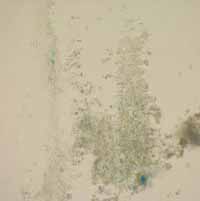 PLM_NI 43 gen 1 blue paint PPL …
PLM_NI 43 gen 1 blue paint PPL …
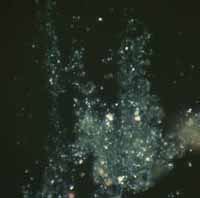 PLM_NI 43 gen 1 blue paint XPL…
PLM_NI 43 gen 1 blue paint XPL…
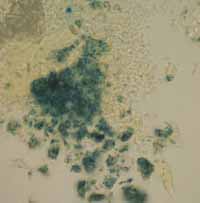 PLM_NI 43 gen 2 greenish glaze …
PLM_NI 43 gen 2 greenish glaze …
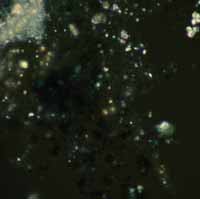 PLM_NI 43 gen 2 greenish glaze …
PLM_NI 43 gen 2 greenish glaze …
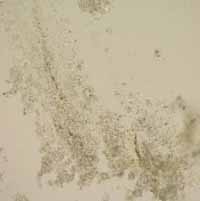 PLM_NI 43 gray primer PPL 1000x
PLM_NI 43 gray primer PPL 1000x
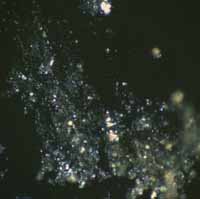 PLM_NI 43 gray primer XPL 100…
PLM_NI 43 gray primer XPL 100…
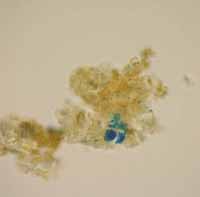 PLM_NI 52 gen 2 yell_grn paint …
PLM_NI 52 gen 2 yell_grn paint …
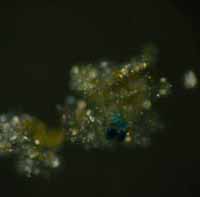 PLM_NI 52 gen 2 yell_grn paint …
PLM_NI 52 gen 2 yell_grn paint …
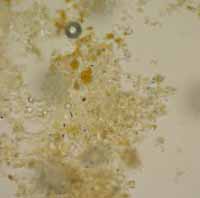 PLM_NI 52 gen 2 yell_grn paint …
PLM_NI 52 gen 2 yell_grn paint …
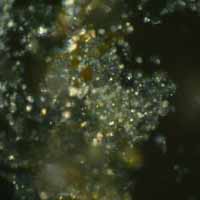 PLM_NI 52 gen 2 yell_grn paint …
PLM_NI 52 gen 2 yell_grn paint …
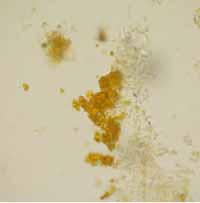 PLM_NI 52 gen 2 yell_grn paint …
PLM_NI 52 gen 2 yell_grn paint …
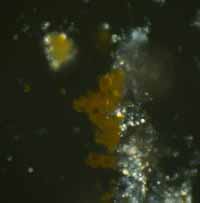 PLM_NI 52 gen 2 yell_grn paint …
PLM_NI 52 gen 2 yell_grn paint …
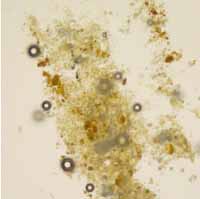 PLM_NI 52 gen 2 yell_grn paint …
PLM_NI 52 gen 2 yell_grn paint …
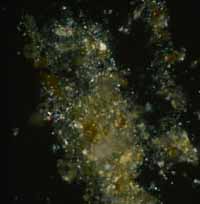 PLM_NI 52 gen 2 yell_grn paint …
PLM_NI 52 gen 2 yell_grn paint …
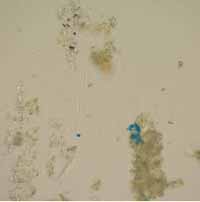 PLM_NI 52 gen 3 lt blue paint 1 …
PLM_NI 52 gen 3 lt blue paint 1 …
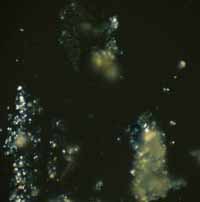 PLM_NI 52 gen 3 lt blue paint 1 …
PLM_NI 52 gen 3 lt blue paint 1 …
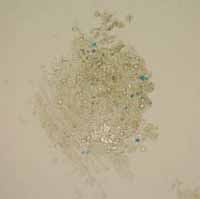 PLM_NI 52 gen 3 lt blue paint 2 …
PLM_NI 52 gen 3 lt blue paint 2 …
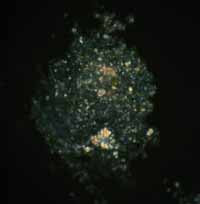 PLM_NI 52 gen 3 lt blue paint 2 …
PLM_NI 52 gen 3 lt blue paint 2 …
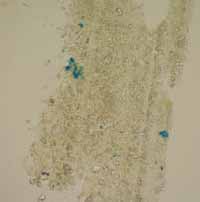 PLM_NI 52 gen 3 lt blue paint 3 …
PLM_NI 52 gen 3 lt blue paint 3 …
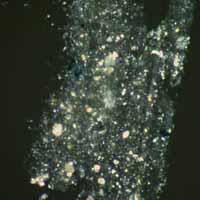 PLM_NI 52 gen 3 lt blue paint 3 …
PLM_NI 52 gen 3 lt blue paint 3 …
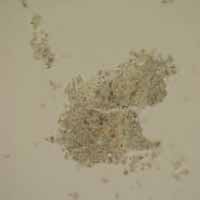 PLM_NI 52 gray paint 2 PPL 1000x
PLM_NI 52 gray paint 2 PPL 1000x
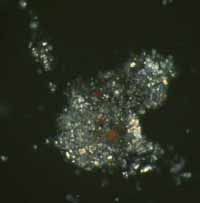 PLM_NI 52 gray paint 2 XPL 100…
PLM_NI 52 gray paint 2 XPL 100…
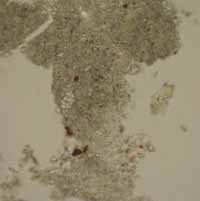 PLM_NI 52 gray paint 3 PPL 1000x
PLM_NI 52 gray paint 3 PPL 1000x
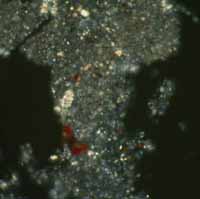 PLM_NI 52 gray paint 3 XPL 100…
PLM_NI 52 gray paint 3 XPL 100…
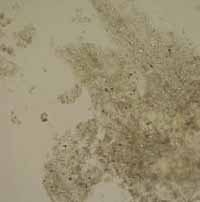 PLM_NI 52 gray paint PPL 1000x
PLM_NI 52 gray paint PPL 1000x
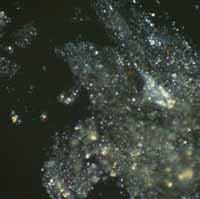 PLM_NI 52 gray paint XPL 1000x
PLM_NI 52 gray paint XPL 1000x
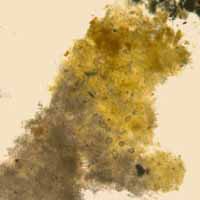 PLM_NI 53 gens 1 and 2 PPL 400x
PLM_NI 53 gens 1 and 2 PPL 400x
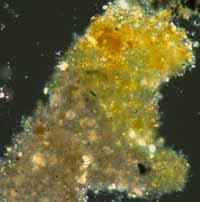 PLM_NI 53 gens 1 and 2 XPL 400x
PLM_NI 53 gens 1 and 2 XPL 400x
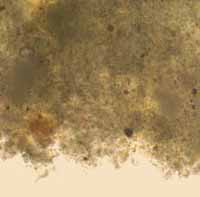 PLM_NI 53 gray paint PPL 1000x
PLM_NI 53 gray paint PPL 1000x
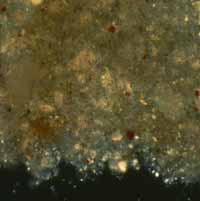 PLM_NI 53 gray paint XPL 1000x
PLM_NI 53 gray paint XPL 1000x
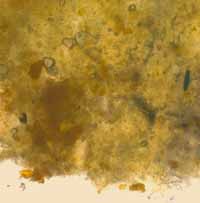 PLM_NI 53 yellow_green 2 PPL …
PLM_NI 53 yellow_green 2 PPL …
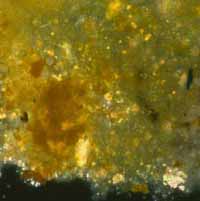 PLM_NI 53 yellow_green 2 XPL …
PLM_NI 53 yellow_green 2 XPL …
